Death of alexander the great Stock Photos and Images
(843)See death of alexander the great stock video clipsQuick filters:
Death of alexander the great Stock Photos and Images
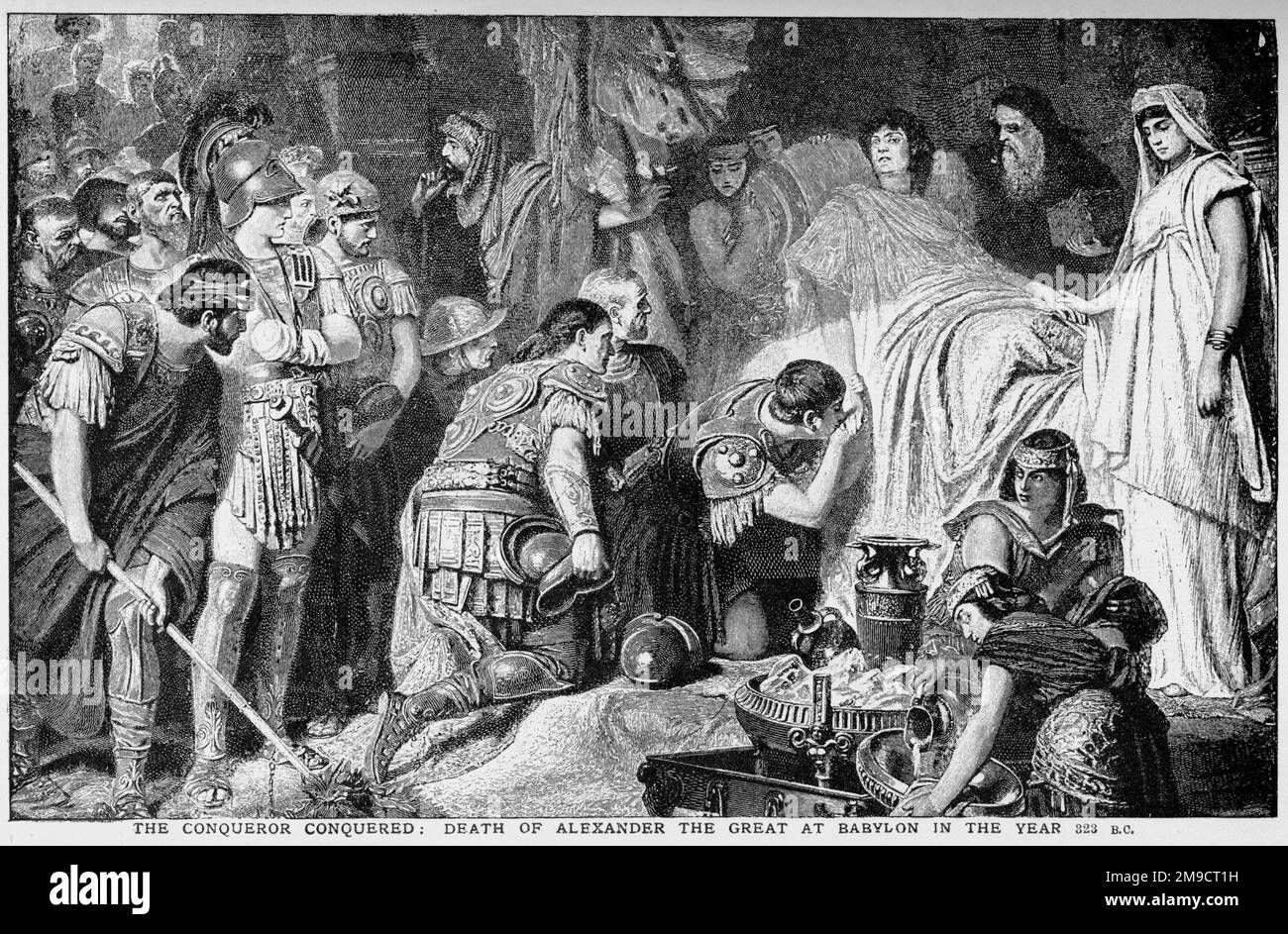 Death Of Alexander The Great Stock Photohttps://www.alamy.com/image-license-details/?v=1https://www.alamy.com/death-of-alexander-the-great-image504914861.html
Death Of Alexander The Great Stock Photohttps://www.alamy.com/image-license-details/?v=1https://www.alamy.com/death-of-alexander-the-great-image504914861.htmlRM2M9CT1H–Death Of Alexander The Great
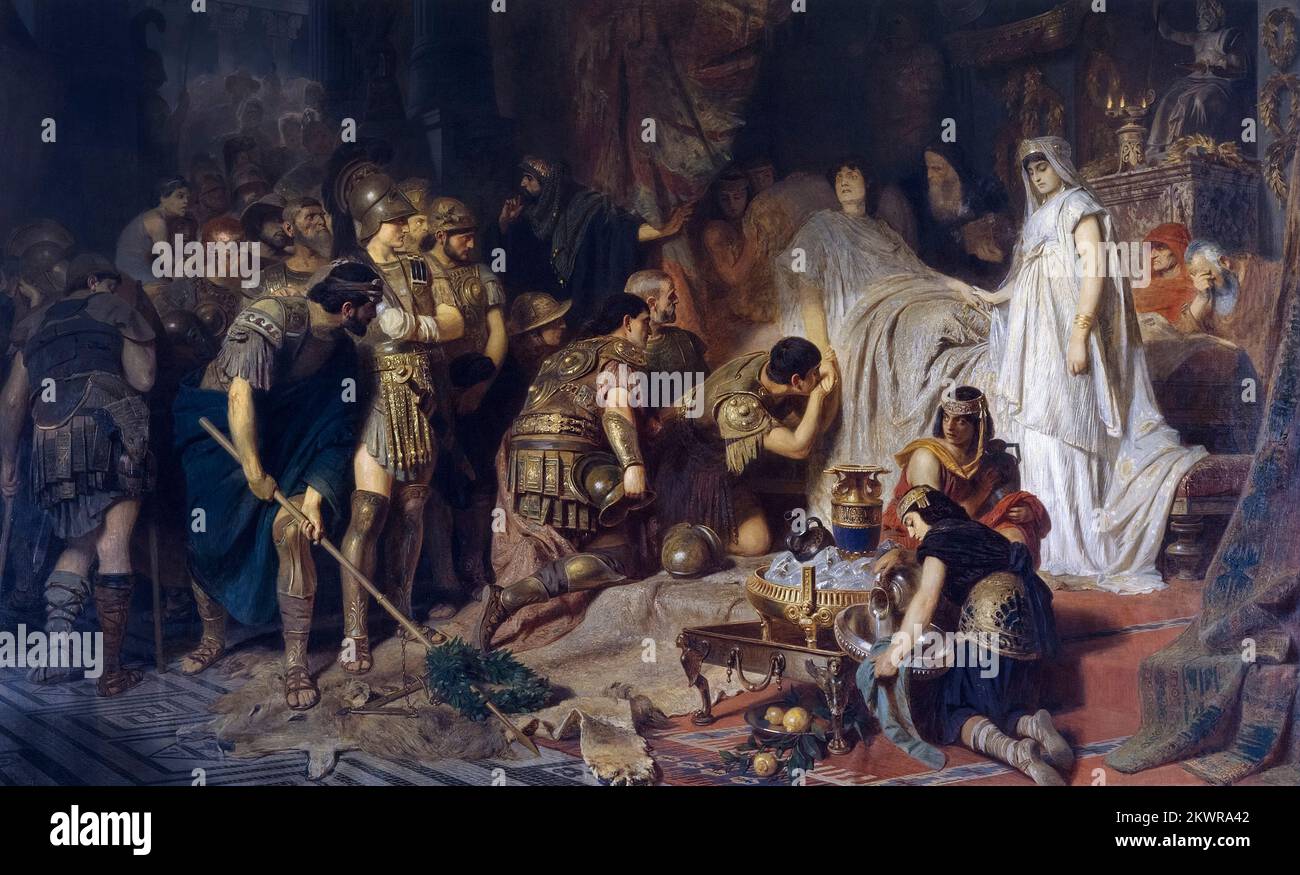 Death of Alexander the Great: The dying Alexander bids farewell to his Army, painting in oil on canvas by Karl von Piloty, 1885-1886 Stock Photohttps://www.alamy.com/image-license-details/?v=1https://www.alamy.com/death-of-alexander-the-great-the-dying-alexander-bids-farewell-to-his-army-painting-in-oil-on-canvas-by-karl-von-piloty-1885-1886-image497769554.html
Death of Alexander the Great: The dying Alexander bids farewell to his Army, painting in oil on canvas by Karl von Piloty, 1885-1886 Stock Photohttps://www.alamy.com/image-license-details/?v=1https://www.alamy.com/death-of-alexander-the-great-the-dying-alexander-bids-farewell-to-his-army-painting-in-oil-on-canvas-by-karl-von-piloty-1885-1886-image497769554.htmlRM2KWRA42–Death of Alexander the Great: The dying Alexander bids farewell to his Army, painting in oil on canvas by Karl von Piloty, 1885-1886
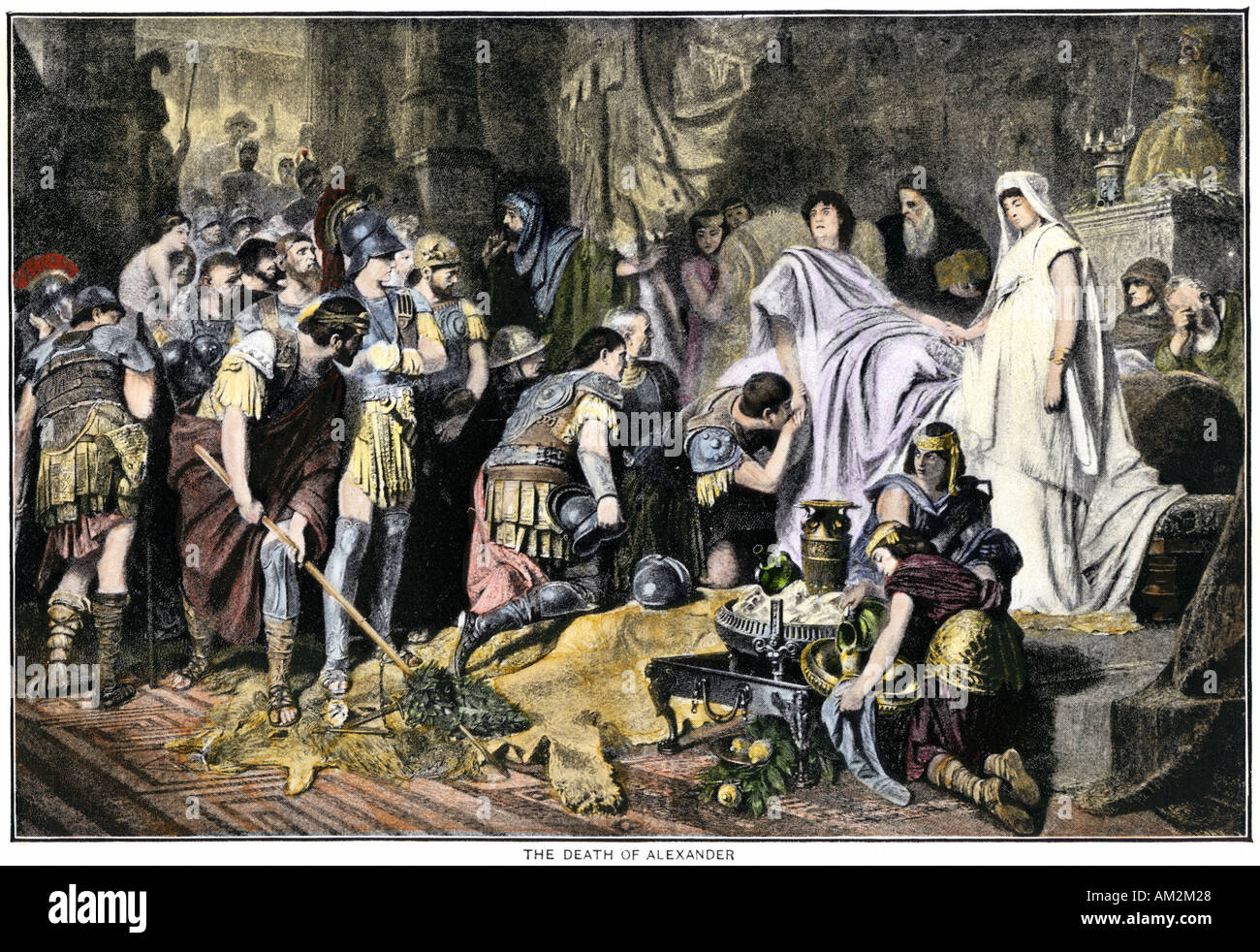 Soldiers paying final tribute to the dying Alexander the Great in Babylon 323 BC. Hand-colored halftone of an illustration Stock Photohttps://www.alamy.com/image-license-details/?v=1https://www.alamy.com/soldiers-paying-final-tribute-to-the-dying-alexander-the-great-in-image4938791.html
Soldiers paying final tribute to the dying Alexander the Great in Babylon 323 BC. Hand-colored halftone of an illustration Stock Photohttps://www.alamy.com/image-license-details/?v=1https://www.alamy.com/soldiers-paying-final-tribute-to-the-dying-alexander-the-great-in-image4938791.htmlRMAM2M28–Soldiers paying final tribute to the dying Alexander the Great in Babylon 323 BC. Hand-colored halftone of an illustration
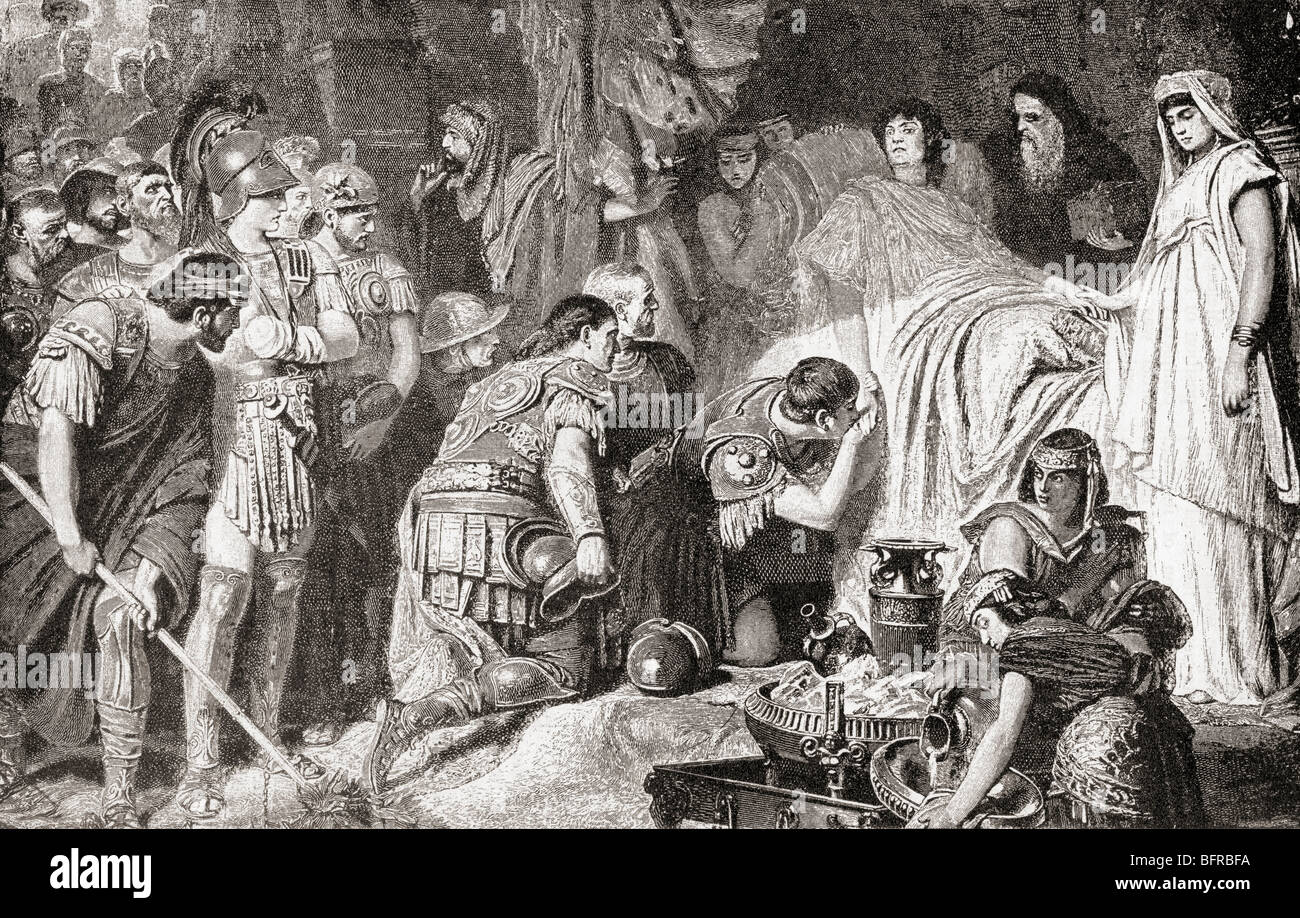 Death of Alexander the Great at Babylon in 323 BC. Alexander III of Macedon aka Alexander the Great, 356 BC – 323 BC. King (basileus) of the ancient Greek kingdom of Macedon and a member of the Argead dynasty. Stock Photohttps://www.alamy.com/image-license-details/?v=1https://www.alamy.com/stock-photo-death-of-alexander-the-great-at-babylon-in-323-bc-alexander-iii-of-26944158.html
Death of Alexander the Great at Babylon in 323 BC. Alexander III of Macedon aka Alexander the Great, 356 BC – 323 BC. King (basileus) of the ancient Greek kingdom of Macedon and a member of the Argead dynasty. Stock Photohttps://www.alamy.com/image-license-details/?v=1https://www.alamy.com/stock-photo-death-of-alexander-the-great-at-babylon-in-323-bc-alexander-iii-of-26944158.htmlRMBFRBFA–Death of Alexander the Great at Babylon in 323 BC. Alexander III of Macedon aka Alexander the Great, 356 BC – 323 BC. King (basileus) of the ancient Greek kingdom of Macedon and a member of the Argead dynasty.
 religion, Christianity, Iraq, Babylonia, Babylon, the death of Alexander the Great, ARTIST'S COPYRIGHT HAS NOT TO BE CLEARED Stock Photohttps://www.alamy.com/image-license-details/?v=1https://www.alamy.com/religion-christianity-iraq-babylonia-babylon-the-death-of-alexander-the-great-artists-copyright-has-not-to-be-cleared-image605549711.html
religion, Christianity, Iraq, Babylonia, Babylon, the death of Alexander the Great, ARTIST'S COPYRIGHT HAS NOT TO BE CLEARED Stock Photohttps://www.alamy.com/image-license-details/?v=1https://www.alamy.com/religion-christianity-iraq-babylonia-babylon-the-death-of-alexander-the-great-artists-copyright-has-not-to-be-cleared-image605549711.htmlRM2X554RB–religion, Christianity, Iraq, Babylonia, Babylon, the death of Alexander the Great, ARTIST'S COPYRIGHT HAS NOT TO BE CLEARED
 A history of Greece from the earliest times to the death of Alexander the Great : Oman, Charles William Chadwick, Sir, 1860-1946 Stock Photohttps://www.alamy.com/image-license-details/?v=1https://www.alamy.com/a-history-of-greece-from-the-earliest-times-to-the-death-of-alexander-the-great-oman-charles-william-chadwick-sir-1860-1946-image261419077.html
A history of Greece from the earliest times to the death of Alexander the Great : Oman, Charles William Chadwick, Sir, 1860-1946 Stock Photohttps://www.alamy.com/image-license-details/?v=1https://www.alamy.com/a-history-of-greece-from-the-earliest-times-to-the-death-of-alexander-the-great-oman-charles-william-chadwick-sir-1860-1946-image261419077.htmlRMW58JKH–A history of Greece from the earliest times to the death of Alexander the Great : Oman, Charles William Chadwick, Sir, 1860-1946
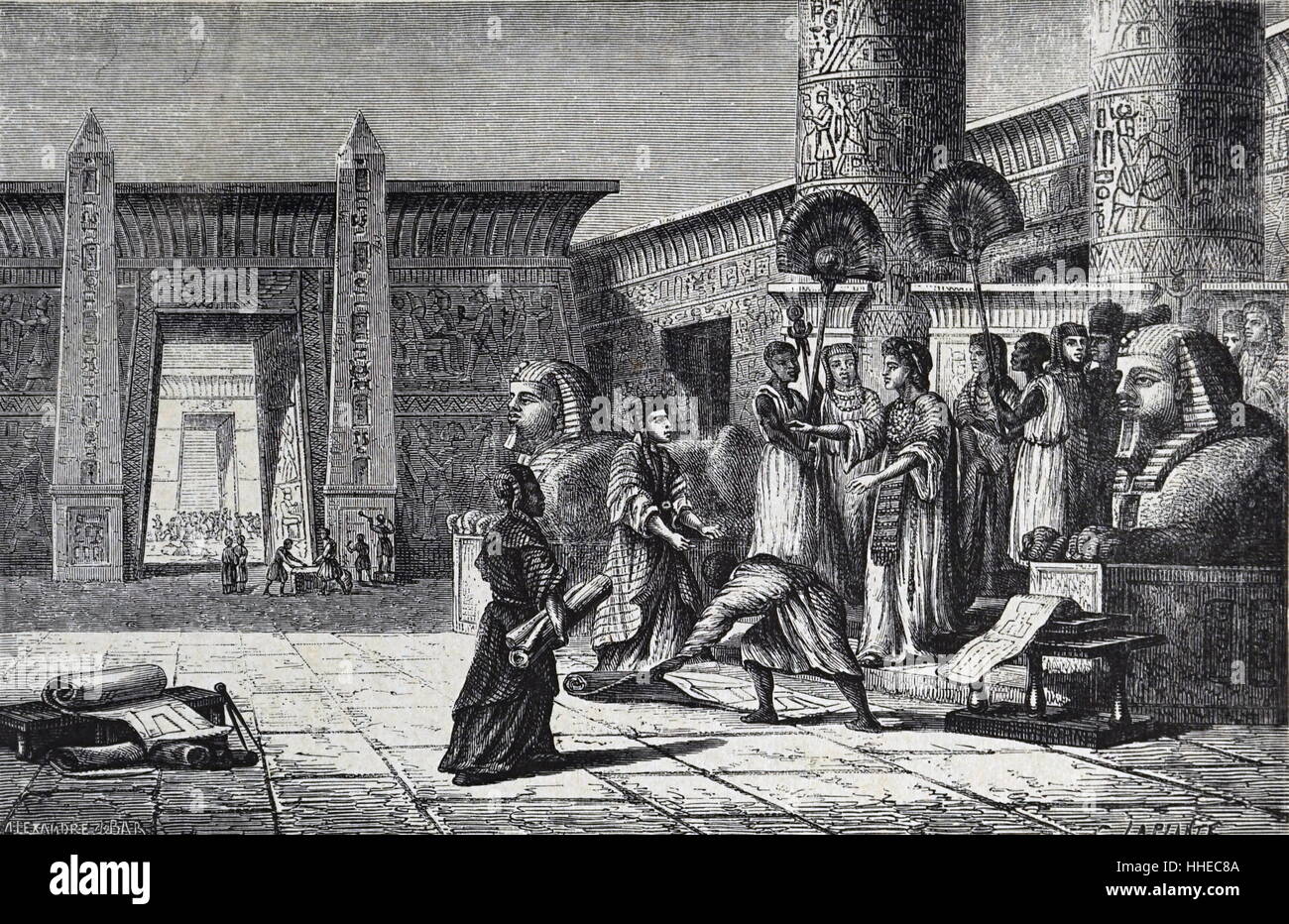 Ptolemy I, Soter (d283 BC) who obtained Egypt on death of Alexander the Great, planning the construction of the Library at Alexandria. Stock Photohttps://www.alamy.com/image-license-details/?v=1https://www.alamy.com/stock-photo-ptolemy-i-soter-d283-bc-who-obtained-egypt-on-death-of-alexander-the-131238698.html
Ptolemy I, Soter (d283 BC) who obtained Egypt on death of Alexander the Great, planning the construction of the Library at Alexandria. Stock Photohttps://www.alamy.com/image-license-details/?v=1https://www.alamy.com/stock-photo-ptolemy-i-soter-d283-bc-who-obtained-egypt-on-death-of-alexander-the-131238698.htmlRMHHEC8A–Ptolemy I, Soter (d283 BC) who obtained Egypt on death of Alexander the Great, planning the construction of the Library at Alexandria.
 Map of Syria, after the death of Alexander the Great. Artist: J Blundell Stock Photohttps://www.alamy.com/image-license-details/?v=1https://www.alamy.com/map-of-syria-after-the-death-of-alexander-the-great-artist-j-blundell-image262759715.html
Map of Syria, after the death of Alexander the Great. Artist: J Blundell Stock Photohttps://www.alamy.com/image-license-details/?v=1https://www.alamy.com/map-of-syria-after-the-death-of-alexander-the-great-artist-j-blundell-image262759715.htmlRMW7DMKF–Map of Syria, after the death of Alexander the Great. Artist: J Blundell
![. Playbill of Covent Garden, Saturday the 31st of January [1747], announcing The rival queens; or, The death of Alexander the Great &c.; Rival queens; or, The death of Alexander the Great; Double disappointment; Amanti Gelosi; [Playbill of Covent Garden, Saturday the 31st of January [1747], announcing The rival queens; or, The death of Alexander the Great &c.] [Playbill of Covent Garden, Saturday the 31st of January [1747], announcing The rival queens; or, The death of Alexander the Great &c.]. 31 January 1747. Covent Garden Theatre [author] Bodleian Libraries, Playbill of Covent Garden, Satu Stock Photo . Playbill of Covent Garden, Saturday the 31st of January [1747], announcing The rival queens; or, The death of Alexander the Great &c.; Rival queens; or, The death of Alexander the Great; Double disappointment; Amanti Gelosi; [Playbill of Covent Garden, Saturday the 31st of January [1747], announcing The rival queens; or, The death of Alexander the Great &c.] [Playbill of Covent Garden, Saturday the 31st of January [1747], announcing The rival queens; or, The death of Alexander the Great &c.]. 31 January 1747. Covent Garden Theatre [author] Bodleian Libraries, Playbill of Covent Garden, Satu Stock Photo](https://c8.alamy.com/comp/MMTCB2/playbill-of-covent-garden-saturday-the-31st-of-january-1747-announcing-the-rival-queens-or-the-death-of-alexander-the-great-c-rival-queens-or-the-death-of-alexander-the-great-double-disappointment-amanti-gelosi-playbill-of-covent-garden-saturday-the-31st-of-january-1747-announcing-the-rival-queens-or-the-death-of-alexander-the-great-c-playbill-of-covent-garden-saturday-the-31st-of-january-1747-announcing-the-rival-queens-or-the-death-of-alexander-the-great-c-31-january-1747-covent-garden-theatre-author-bodleian-libraries-playbill-of-covent-garden-satu-MMTCB2.jpg) . Playbill of Covent Garden, Saturday the 31st of January [1747], announcing The rival queens; or, The death of Alexander the Great &c.; Rival queens; or, The death of Alexander the Great; Double disappointment; Amanti Gelosi; [Playbill of Covent Garden, Saturday the 31st of January [1747], announcing The rival queens; or, The death of Alexander the Great &c.] [Playbill of Covent Garden, Saturday the 31st of January [1747], announcing The rival queens; or, The death of Alexander the Great &c.]. 31 January 1747. Covent Garden Theatre [author] Bodleian Libraries, Playbill of Covent Garden, Satu Stock Photohttps://www.alamy.com/image-license-details/?v=1https://www.alamy.com/playbill-of-covent-garden-saturday-the-31st-of-january-1747-announcing-the-rival-queens-or-the-death-of-alexander-the-great-c-rival-queens-or-the-death-of-alexander-the-great-double-disappointment-amanti-gelosi-playbill-of-covent-garden-saturday-the-31st-of-january-1747-announcing-the-rival-queens-or-the-death-of-alexander-the-great-c-playbill-of-covent-garden-saturday-the-31st-of-january-1747-announcing-the-rival-queens-or-the-death-of-alexander-the-great-c-31-january-1747-covent-garden-theatre-author-bodleian-libraries-playbill-of-covent-garden-satu-image184933366.html
. Playbill of Covent Garden, Saturday the 31st of January [1747], announcing The rival queens; or, The death of Alexander the Great &c.; Rival queens; or, The death of Alexander the Great; Double disappointment; Amanti Gelosi; [Playbill of Covent Garden, Saturday the 31st of January [1747], announcing The rival queens; or, The death of Alexander the Great &c.] [Playbill of Covent Garden, Saturday the 31st of January [1747], announcing The rival queens; or, The death of Alexander the Great &c.]. 31 January 1747. Covent Garden Theatre [author] Bodleian Libraries, Playbill of Covent Garden, Satu Stock Photohttps://www.alamy.com/image-license-details/?v=1https://www.alamy.com/playbill-of-covent-garden-saturday-the-31st-of-january-1747-announcing-the-rival-queens-or-the-death-of-alexander-the-great-c-rival-queens-or-the-death-of-alexander-the-great-double-disappointment-amanti-gelosi-playbill-of-covent-garden-saturday-the-31st-of-january-1747-announcing-the-rival-queens-or-the-death-of-alexander-the-great-c-playbill-of-covent-garden-saturday-the-31st-of-january-1747-announcing-the-rival-queens-or-the-death-of-alexander-the-great-c-31-january-1747-covent-garden-theatre-author-bodleian-libraries-playbill-of-covent-garden-satu-image184933366.htmlRMMMTCB2–. Playbill of Covent Garden, Saturday the 31st of January [1747], announcing The rival queens; or, The death of Alexander the Great &c.; Rival queens; or, The death of Alexander the Great; Double disappointment; Amanti Gelosi; [Playbill of Covent Garden, Saturday the 31st of January [1747], announcing The rival queens; or, The death of Alexander the Great &c.] [Playbill of Covent Garden, Saturday the 31st of January [1747], announcing The rival queens; or, The death of Alexander the Great &c.]. 31 January 1747. Covent Garden Theatre [author] Bodleian Libraries, Playbill of Covent Garden, Satu
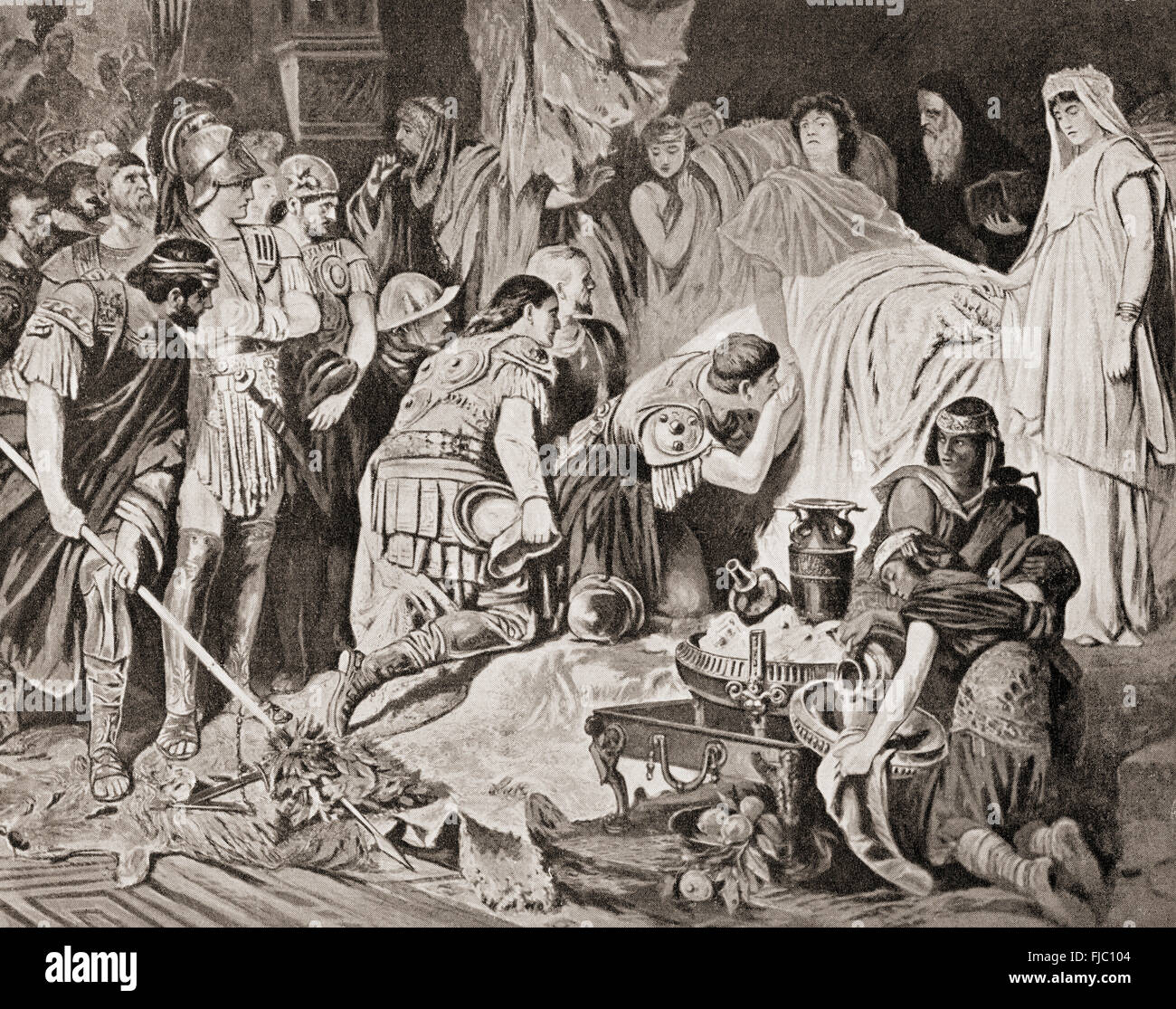 The death of Alexander III of Macedon, 356 BC – 323 BC, aka Alexander the Great. King of the Ancient Greek kingdom of Macedon. Stock Photohttps://www.alamy.com/image-license-details/?v=1https://www.alamy.com/stock-photo-the-death-of-alexander-iii-of-macedon-356-bc-323-bc-aka-alexander-97379860.html
The death of Alexander III of Macedon, 356 BC – 323 BC, aka Alexander the Great. King of the Ancient Greek kingdom of Macedon. Stock Photohttps://www.alamy.com/image-license-details/?v=1https://www.alamy.com/stock-photo-the-death-of-alexander-iii-of-macedon-356-bc-323-bc-aka-alexander-97379860.htmlRMFJC104–The death of Alexander III of Macedon, 356 BC – 323 BC, aka Alexander the Great. King of the Ancient Greek kingdom of Macedon.
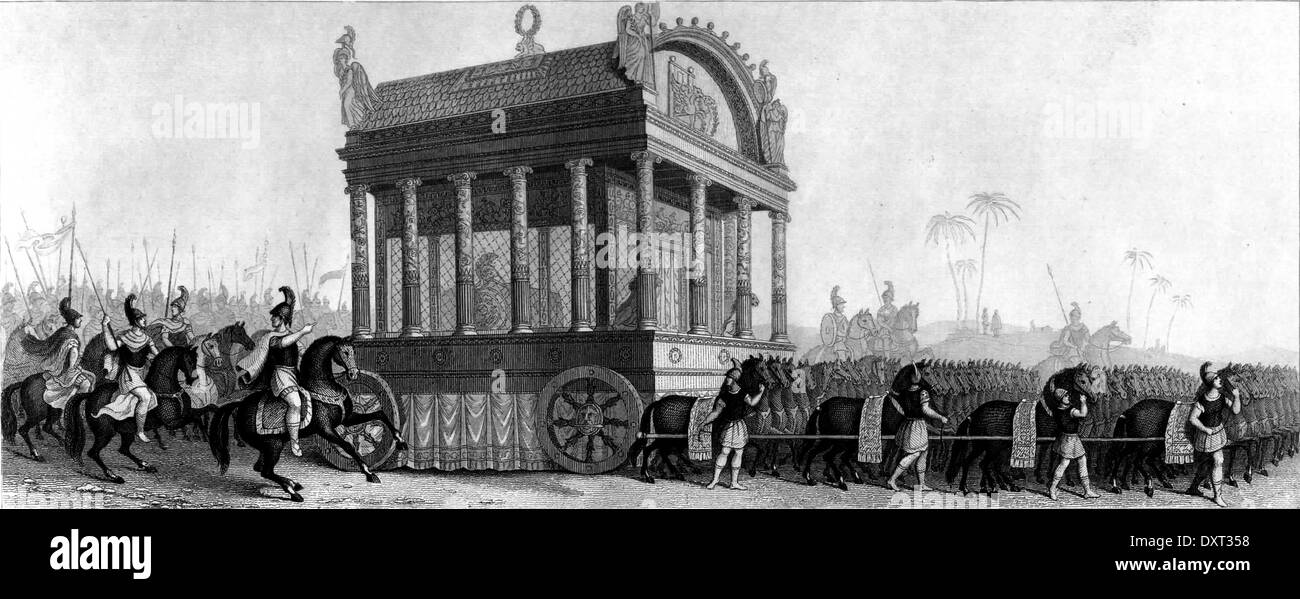 Alexander the Great, funeral procession Stock Photohttps://www.alamy.com/image-license-details/?v=1https://www.alamy.com/alexander-the-great-funeral-procession-image68141508.html
Alexander the Great, funeral procession Stock Photohttps://www.alamy.com/image-license-details/?v=1https://www.alamy.com/alexander-the-great-funeral-procession-image68141508.htmlRMDXT358–Alexander the Great, funeral procession
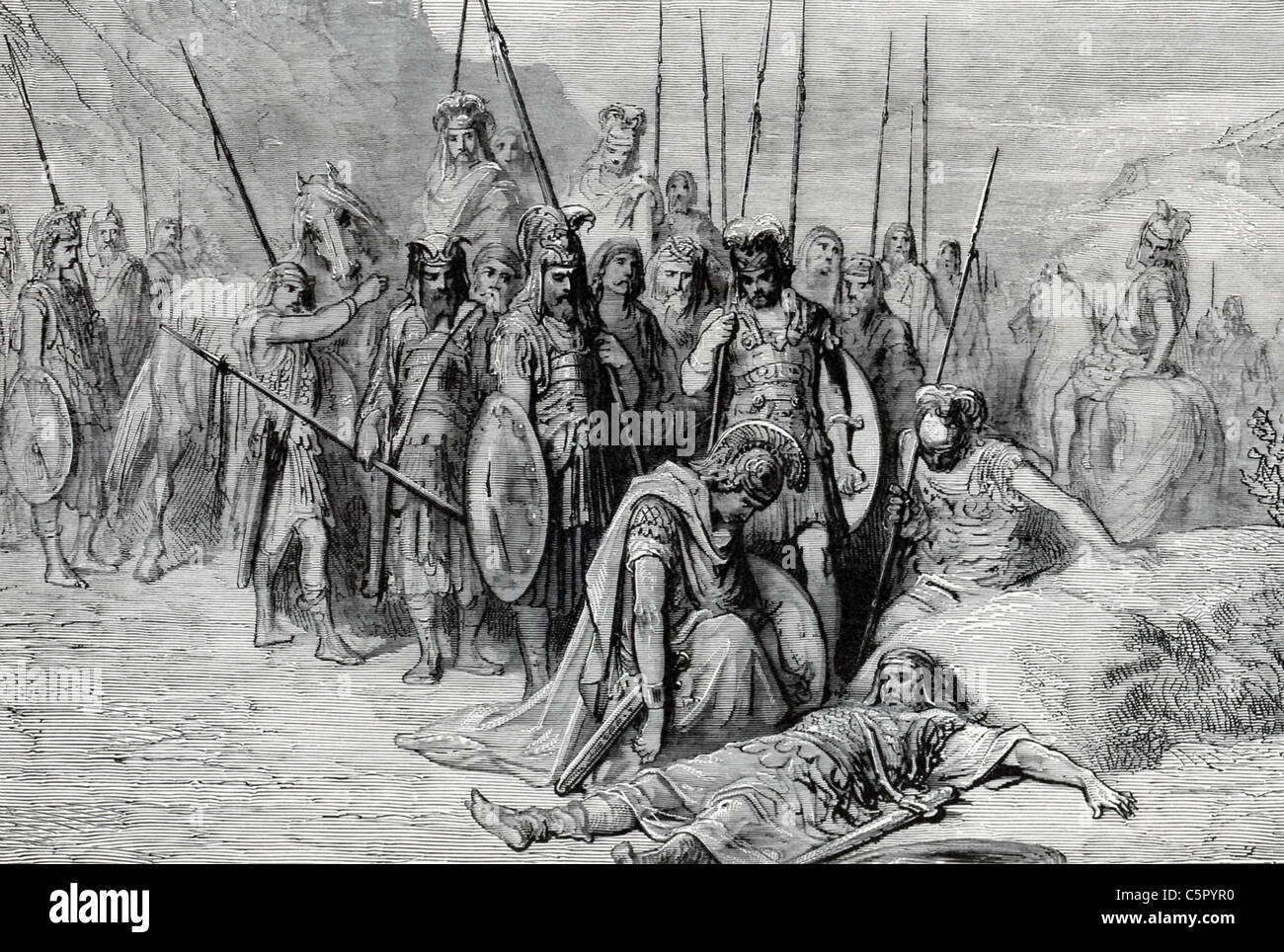 Following battle of Gaugamela, Alexander the Great came upon the dying Darius and ordered a proper burial for him. Stock Photohttps://www.alamy.com/image-license-details/?v=1https://www.alamy.com/stock-photo-following-battle-of-gaugamela-alexander-the-great-came-upon-the-dying-37998772.html
Following battle of Gaugamela, Alexander the Great came upon the dying Darius and ordered a proper burial for him. Stock Photohttps://www.alamy.com/image-license-details/?v=1https://www.alamy.com/stock-photo-following-battle-of-gaugamela-alexander-the-great-came-upon-the-dying-37998772.htmlRFC5PYR0–Following battle of Gaugamela, Alexander the Great came upon the dying Darius and ordered a proper burial for him.
 Asien, Irak, Babylonien, Babylon, der Tod von Alexander des Großen , Kupferstich aus : ' Allgemeine Geschichte vom Anfang der historischen Kenntniß bis auf unsere Zeiten ' , für denkende Geschichtsfreunde bearbeitet von Karl von Rotteck, zweiter Band, herausgegeben in der Herder´schen Kunst- und Buchhandlung, Freiburg im Breisgau , 1839 . / Asia, Iraq, Babylonia, Babylon, the death of Alexander the Great, copperplate engraving from : ' Allgemeine Geschichte vom Anfang der historischen Kenntniß bis auf unsere Zeiten ' , by Karl von Rotteck, second volume, published by Herder´schen Kunst- u Stock Photohttps://www.alamy.com/image-license-details/?v=1https://www.alamy.com/asien-irak-babylonien-babylon-der-tod-von-alexander-des-groen-kupferstich-aus-allgemeine-geschichte-vom-anfang-der-historischen-kenntni-bis-auf-unsere-zeiten-fr-denkende-geschichtsfreunde-bearbeitet-von-karl-von-rotteck-zweiter-band-herausgegeben-in-der-herderschen-kunst-und-buchhandlung-freiburg-im-breisgau-1839-asia-iraq-babylonia-babylon-the-death-of-alexander-the-great-copperplate-engraving-from-allgemeine-geschichte-vom-anfang-der-historischen-kenntni-bis-auf-unsere-zeiten-by-karl-von-rotteck-second-volume-published-by-herderschen-kunst-u-image354908975.html
Asien, Irak, Babylonien, Babylon, der Tod von Alexander des Großen , Kupferstich aus : ' Allgemeine Geschichte vom Anfang der historischen Kenntniß bis auf unsere Zeiten ' , für denkende Geschichtsfreunde bearbeitet von Karl von Rotteck, zweiter Band, herausgegeben in der Herder´schen Kunst- und Buchhandlung, Freiburg im Breisgau , 1839 . / Asia, Iraq, Babylonia, Babylon, the death of Alexander the Great, copperplate engraving from : ' Allgemeine Geschichte vom Anfang der historischen Kenntniß bis auf unsere Zeiten ' , by Karl von Rotteck, second volume, published by Herder´schen Kunst- u Stock Photohttps://www.alamy.com/image-license-details/?v=1https://www.alamy.com/asien-irak-babylonien-babylon-der-tod-von-alexander-des-groen-kupferstich-aus-allgemeine-geschichte-vom-anfang-der-historischen-kenntni-bis-auf-unsere-zeiten-fr-denkende-geschichtsfreunde-bearbeitet-von-karl-von-rotteck-zweiter-band-herausgegeben-in-der-herderschen-kunst-und-buchhandlung-freiburg-im-breisgau-1839-asia-iraq-babylonia-babylon-the-death-of-alexander-the-great-copperplate-engraving-from-allgemeine-geschichte-vom-anfang-der-historischen-kenntni-bis-auf-unsere-zeiten-by-karl-von-rotteck-second-volume-published-by-herderschen-kunst-u-image354908975.htmlRM2BHBE0F–Asien, Irak, Babylonien, Babylon, der Tod von Alexander des Großen , Kupferstich aus : ' Allgemeine Geschichte vom Anfang der historischen Kenntniß bis auf unsere Zeiten ' , für denkende Geschichtsfreunde bearbeitet von Karl von Rotteck, zweiter Band, herausgegeben in der Herder´schen Kunst- und Buchhandlung, Freiburg im Breisgau , 1839 . / Asia, Iraq, Babylonia, Babylon, the death of Alexander the Great, copperplate engraving from : ' Allgemeine Geschichte vom Anfang der historischen Kenntniß bis auf unsere Zeiten ' , by Karl von Rotteck, second volume, published by Herder´schen Kunst- u
 Death of Demosthenes. The death of Demosthenes (384-322 B.C.) , one of the greatest orators in history, was as tragic as his life had been. He sought by his eloquence to preserve the freedom of Athens against Alexander the Great and his successors; but Athens was subjugated and Demosthenes fled for his life, pursued by his foes. They would have dragged him even from the temple of Neptune, where he had sought shelter, clinging to the feet of the god’s statue. Seeing there was no hope, he took poison, which he had previously prepared. He then passed from the temple with quiet dignity, saying, “ Stock Photohttps://www.alamy.com/image-license-details/?v=1https://www.alamy.com/death-of-demosthenes-the-death-of-demosthenes-384-322-bc-one-of-the-greatest-orators-in-history-was-as-tragic-as-his-life-had-been-he-sought-by-his-eloquence-to-preserve-the-freedom-of-athens-against-alexander-the-great-and-his-successors-but-athens-was-subjugated-and-demosthenes-fled-for-his-life-pursued-by-his-foes-they-would-have-dragged-him-even-from-the-temple-of-neptune-where-he-had-sought-shelter-clinging-to-the-feet-of-the-gods-statue-seeing-there-was-no-hope-he-took-poison-which-he-had-previously-prepared-he-then-passed-from-the-temple-with-quiet-dignity-saying-image365652169.html
Death of Demosthenes. The death of Demosthenes (384-322 B.C.) , one of the greatest orators in history, was as tragic as his life had been. He sought by his eloquence to preserve the freedom of Athens against Alexander the Great and his successors; but Athens was subjugated and Demosthenes fled for his life, pursued by his foes. They would have dragged him even from the temple of Neptune, where he had sought shelter, clinging to the feet of the god’s statue. Seeing there was no hope, he took poison, which he had previously prepared. He then passed from the temple with quiet dignity, saying, “ Stock Photohttps://www.alamy.com/image-license-details/?v=1https://www.alamy.com/death-of-demosthenes-the-death-of-demosthenes-384-322-bc-one-of-the-greatest-orators-in-history-was-as-tragic-as-his-life-had-been-he-sought-by-his-eloquence-to-preserve-the-freedom-of-athens-against-alexander-the-great-and-his-successors-but-athens-was-subjugated-and-demosthenes-fled-for-his-life-pursued-by-his-foes-they-would-have-dragged-him-even-from-the-temple-of-neptune-where-he-had-sought-shelter-clinging-to-the-feet-of-the-gods-statue-seeing-there-was-no-hope-he-took-poison-which-he-had-previously-prepared-he-then-passed-from-the-temple-with-quiet-dignity-saying-image365652169.htmlRF2C6TW21–Death of Demosthenes. The death of Demosthenes (384-322 B.C.) , one of the greatest orators in history, was as tragic as his life had been. He sought by his eloquence to preserve the freedom of Athens against Alexander the Great and his successors; but Athens was subjugated and Demosthenes fled for his life, pursued by his foes. They would have dragged him even from the temple of Neptune, where he had sought shelter, clinging to the feet of the god’s statue. Seeing there was no hope, he took poison, which he had previously prepared. He then passed from the temple with quiet dignity, saying, “
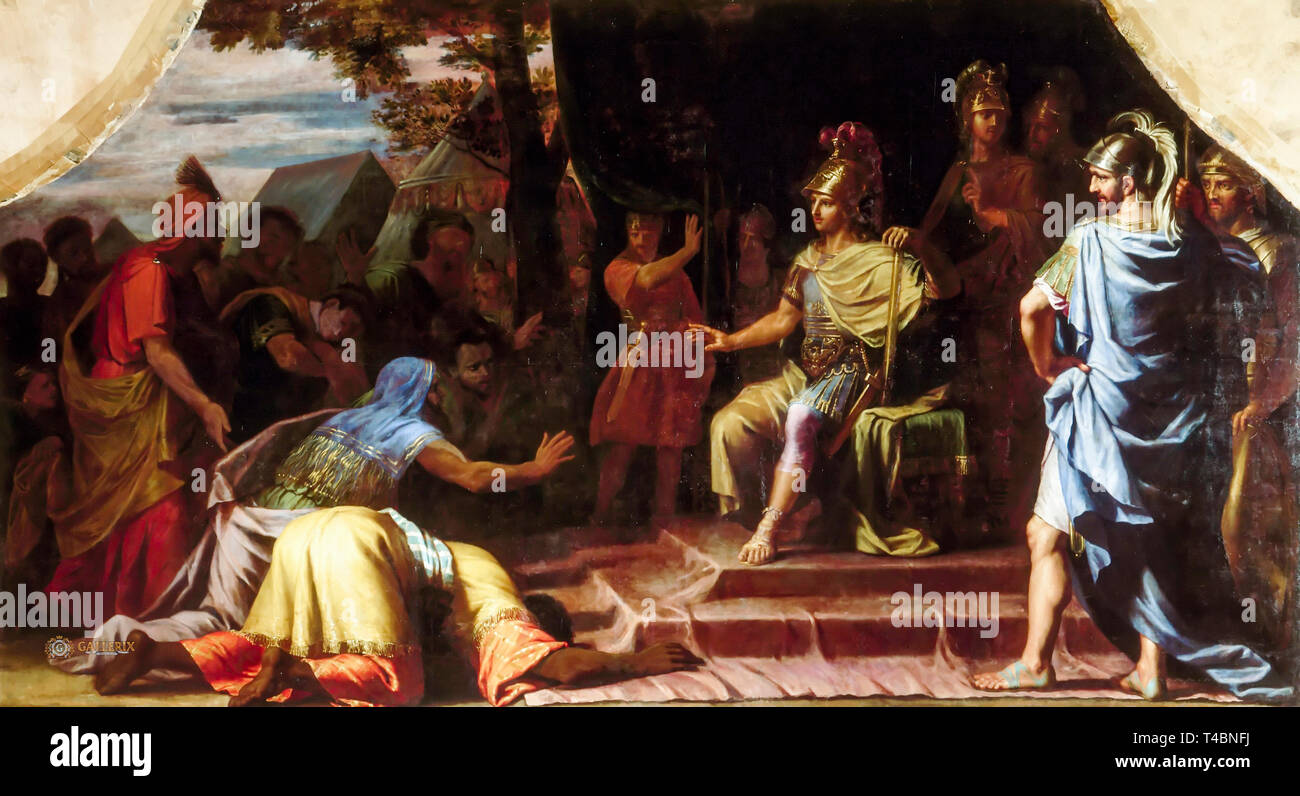 Alexander the Great Receiving News of the Death by Immolation of the Indian Gymnosophist Calanus, painting by Jean-Baptiste de Champaigne, 1672 Stock Photohttps://www.alamy.com/image-license-details/?v=1https://www.alamy.com/alexander-the-great-receiving-news-of-the-death-by-immolation-of-the-indian-gymnosophist-calanus-painting-by-jean-baptiste-de-champaigne-1672-image243662150.html
Alexander the Great Receiving News of the Death by Immolation of the Indian Gymnosophist Calanus, painting by Jean-Baptiste de Champaigne, 1672 Stock Photohttps://www.alamy.com/image-license-details/?v=1https://www.alamy.com/alexander-the-great-receiving-news-of-the-death-by-immolation-of-the-indian-gymnosophist-calanus-painting-by-jean-baptiste-de-champaigne-1672-image243662150.htmlRMT4BNFJ–Alexander the Great Receiving News of the Death by Immolation of the Indian Gymnosophist Calanus, painting by Jean-Baptiste de Champaigne, 1672
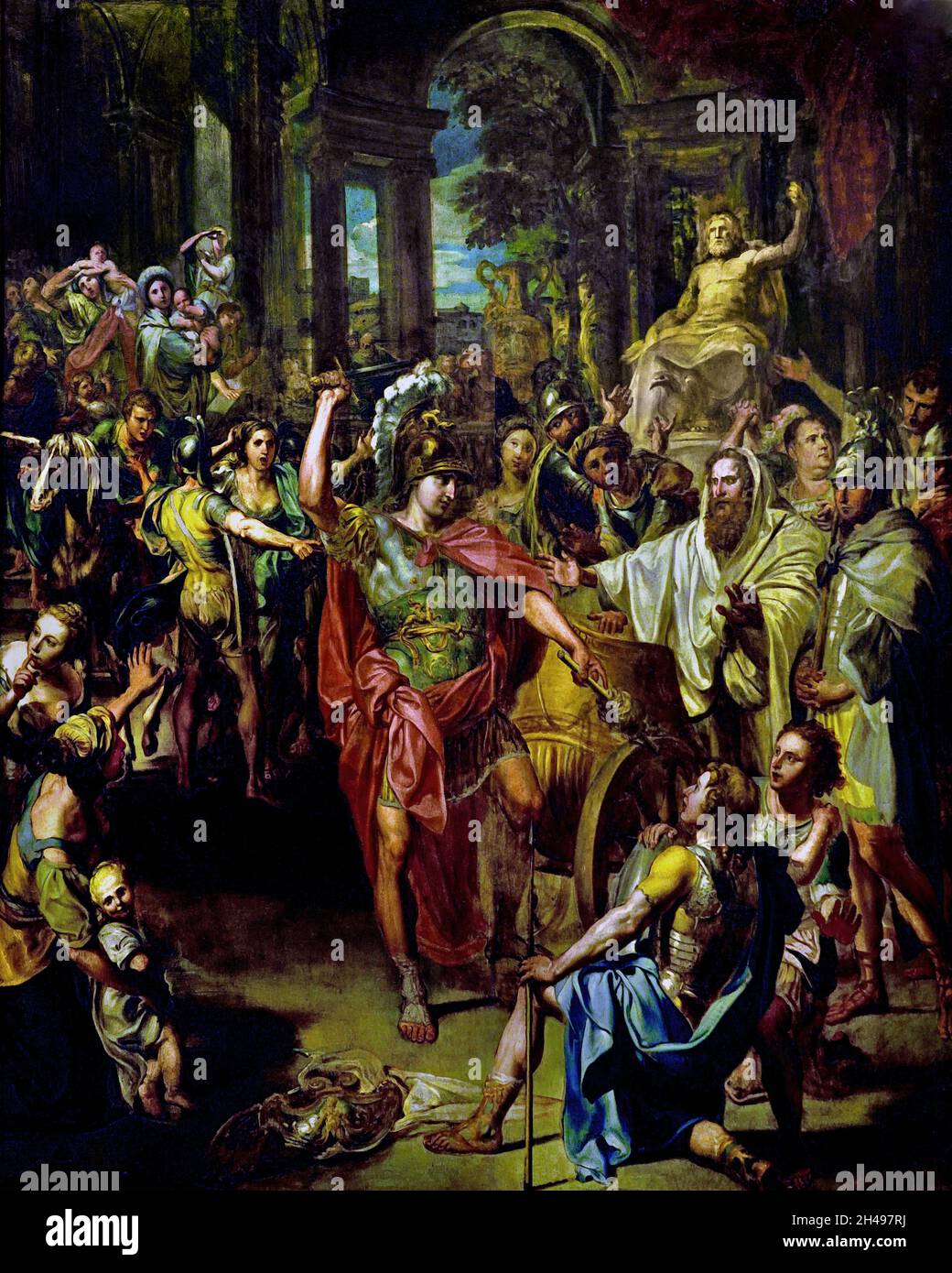 Alessandro scioglie il nodo di Gordio - Alexander the Great Cutting the Gordian Knot. by Gregorio De Ferrari (1647–1726), Italy, Italian, Genoa, Italy, Italian, Alexander the Great, Alexander III of Macedon, 356 BC – 323 BC king of the Ancient Greek kingdom of Macedon from 336 BC until his death in 323 BC. He was one of the greatest military leaders of all time. Greek Greece Stock Photohttps://www.alamy.com/image-license-details/?v=1https://www.alamy.com/alessandro-scioglie-il-nodo-di-gordio-alexander-the-great-cutting-the-gordian-knot-by-gregorio-de-ferrari-16471726-italy-italian-genoa-italy-italian-alexander-the-great-alexander-iii-of-macedon-356-bc-323-bc-king-of-the-ancient-greek-kingdom-of-macedon-from-336-bc-until-his-death-in-323-bc-he-was-one-of-the-greatest-military-leaders-of-all-time-greek-greece-image450131910.html
Alessandro scioglie il nodo di Gordio - Alexander the Great Cutting the Gordian Knot. by Gregorio De Ferrari (1647–1726), Italy, Italian, Genoa, Italy, Italian, Alexander the Great, Alexander III of Macedon, 356 BC – 323 BC king of the Ancient Greek kingdom of Macedon from 336 BC until his death in 323 BC. He was one of the greatest military leaders of all time. Greek Greece Stock Photohttps://www.alamy.com/image-license-details/?v=1https://www.alamy.com/alessandro-scioglie-il-nodo-di-gordio-alexander-the-great-cutting-the-gordian-knot-by-gregorio-de-ferrari-16471726-italy-italian-genoa-italy-italian-alexander-the-great-alexander-iii-of-macedon-356-bc-323-bc-king-of-the-ancient-greek-kingdom-of-macedon-from-336-bc-until-his-death-in-323-bc-he-was-one-of-the-greatest-military-leaders-of-all-time-greek-greece-image450131910.htmlRM2H497RJ–Alessandro scioglie il nodo di Gordio - Alexander the Great Cutting the Gordian Knot. by Gregorio De Ferrari (1647–1726), Italy, Italian, Genoa, Italy, Italian, Alexander the Great, Alexander III of Macedon, 356 BC – 323 BC king of the Ancient Greek kingdom of Macedon from 336 BC until his death in 323 BC. He was one of the greatest military leaders of all time. Greek Greece
 Comic History of Greece from the earliest times to the death of Alexander the Great ... Illustrated, etc' Stock Photohttps://www.alamy.com/image-license-details/?v=1https://www.alamy.com/comic-history-of-greece-from-the-earliest-times-to-the-death-of-alexander-image65007684.html
Comic History of Greece from the earliest times to the death of Alexander the Great ... Illustrated, etc' Stock Photohttps://www.alamy.com/image-license-details/?v=1https://www.alamy.com/comic-history-of-greece-from-the-earliest-times-to-the-death-of-alexander-image65007684.htmlRMDNN9Y0–Comic History of Greece from the earliest times to the death of Alexander the Great ... Illustrated, etc'
 Silver Tetradrachm of Alexander the Great Stock Photohttps://www.alamy.com/image-license-details/?v=1https://www.alamy.com/stock-photo-silver-tetradrachm-of-alexander-the-great-135093935.html
Silver Tetradrachm of Alexander the Great Stock Photohttps://www.alamy.com/image-license-details/?v=1https://www.alamy.com/stock-photo-silver-tetradrachm-of-alexander-the-great-135093935.htmlRMHRP1KB–Silver Tetradrachm of Alexander the Great
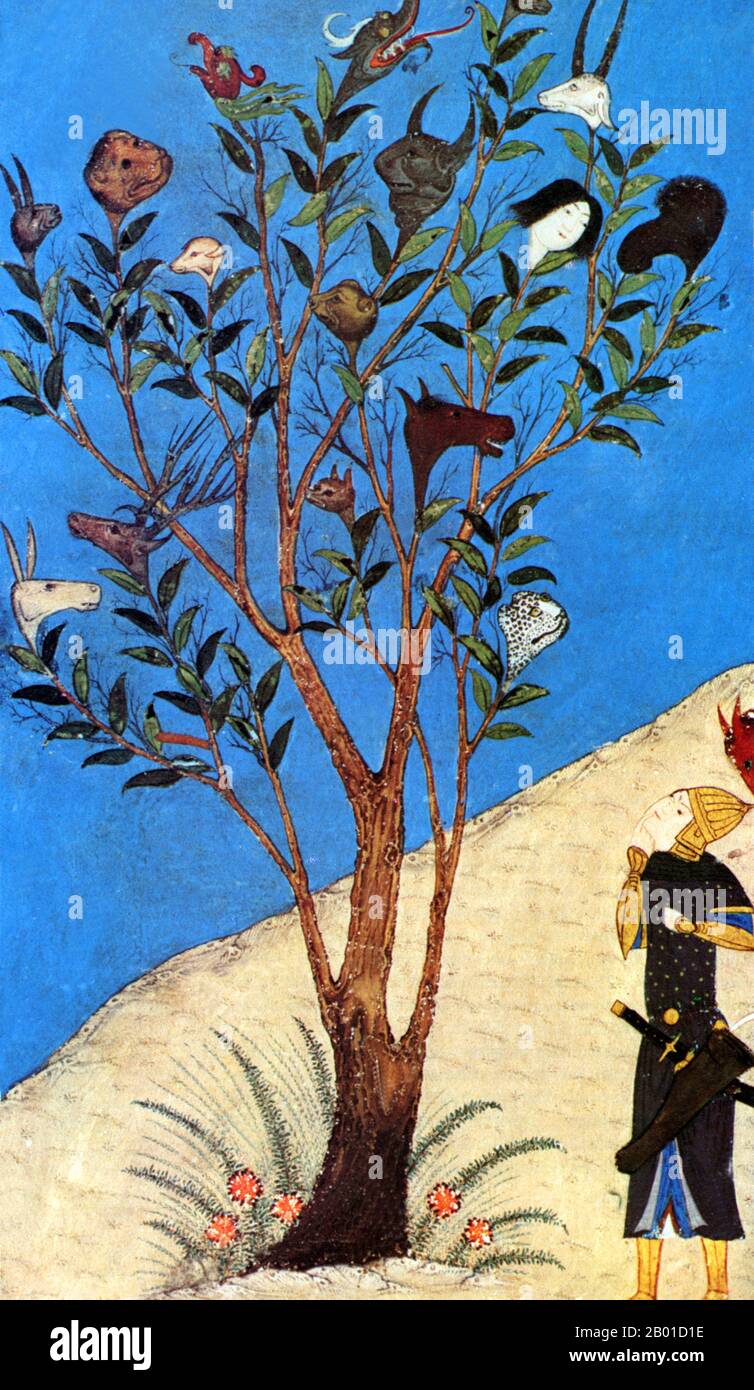 Iran: Alexander the Great (Iskandar) at the Talking Tree. Miniature painting from a Timurid copy of Firdausi's Shahnameh, c. 1420-1425. Towards the end of his travels, Eskandar, or Alexander the Great, came to a town at the edge of the world. The local curiosity was a tree with two trunks of talking heads; the male trunk spoke by day and the female at night. Intrigued, Eskandar visited the tree and heard a voice prophesying his death. He is shown here standing before the tree in bewilderment, his finger to his lips. Stock Photohttps://www.alamy.com/image-license-details/?v=1https://www.alamy.com/iran-alexander-the-great-iskandar-at-the-talking-tree-miniature-painting-from-a-timurid-copy-of-firdausis-shahnameh-c-1420-1425-towards-the-end-of-his-travels-eskandar-or-alexander-the-great-came-to-a-town-at-the-edge-of-the-world-the-local-curiosity-was-a-tree-with-two-trunks-of-talking-heads-the-male-trunk-spoke-by-day-and-the-female-at-night-intrigued-eskandar-visited-the-tree-and-heard-a-voice-prophesying-his-death-he-is-shown-here-standing-before-the-tree-in-bewilderment-his-finger-to-his-lips-image344239546.html
Iran: Alexander the Great (Iskandar) at the Talking Tree. Miniature painting from a Timurid copy of Firdausi's Shahnameh, c. 1420-1425. Towards the end of his travels, Eskandar, or Alexander the Great, came to a town at the edge of the world. The local curiosity was a tree with two trunks of talking heads; the male trunk spoke by day and the female at night. Intrigued, Eskandar visited the tree and heard a voice prophesying his death. He is shown here standing before the tree in bewilderment, his finger to his lips. Stock Photohttps://www.alamy.com/image-license-details/?v=1https://www.alamy.com/iran-alexander-the-great-iskandar-at-the-talking-tree-miniature-painting-from-a-timurid-copy-of-firdausis-shahnameh-c-1420-1425-towards-the-end-of-his-travels-eskandar-or-alexander-the-great-came-to-a-town-at-the-edge-of-the-world-the-local-curiosity-was-a-tree-with-two-trunks-of-talking-heads-the-male-trunk-spoke-by-day-and-the-female-at-night-intrigued-eskandar-visited-the-tree-and-heard-a-voice-prophesying-his-death-he-is-shown-here-standing-before-the-tree-in-bewilderment-his-finger-to-his-lips-image344239546.htmlRM2B01D1E–Iran: Alexander the Great (Iskandar) at the Talking Tree. Miniature painting from a Timurid copy of Firdausi's Shahnameh, c. 1420-1425. Towards the end of his travels, Eskandar, or Alexander the Great, came to a town at the edge of the world. The local curiosity was a tree with two trunks of talking heads; the male trunk spoke by day and the female at night. Intrigued, Eskandar visited the tree and heard a voice prophesying his death. He is shown here standing before the tree in bewilderment, his finger to his lips.
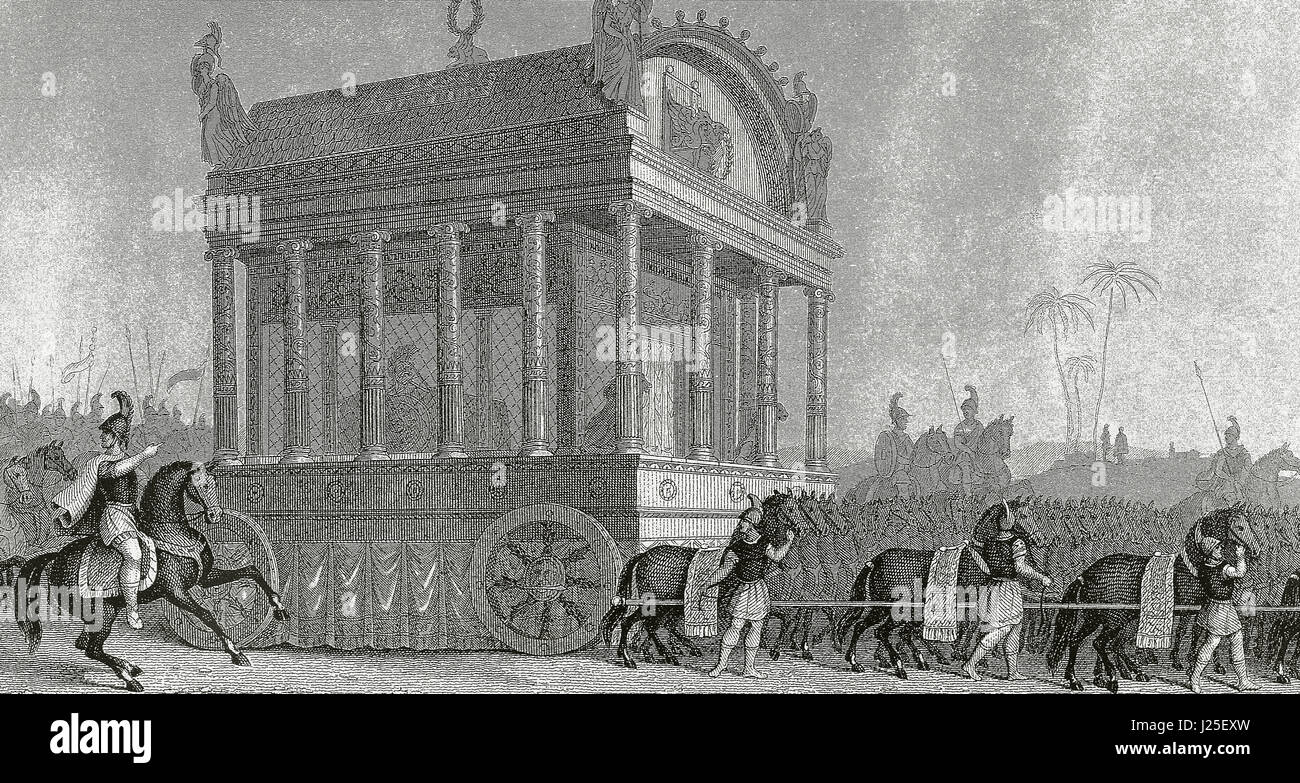 Alexander III the Great (356-323 B.C.). King of Macedonia (336-323 B.C.). Death of Alexander. Funeral procession. Engraving. Stock Photohttps://www.alamy.com/image-license-details/?v=1https://www.alamy.com/stock-photo-alexander-iii-the-great-356-323-bc-king-of-macedonia-336-323-bc-death-139033745.html
Alexander III the Great (356-323 B.C.). King of Macedonia (336-323 B.C.). Death of Alexander. Funeral procession. Engraving. Stock Photohttps://www.alamy.com/image-license-details/?v=1https://www.alamy.com/stock-photo-alexander-iii-the-great-356-323-bc-king-of-macedonia-336-323-bc-death-139033745.htmlRMJ25EXW–Alexander III the Great (356-323 B.C.). King of Macedonia (336-323 B.C.). Death of Alexander. Funeral procession. Engraving.
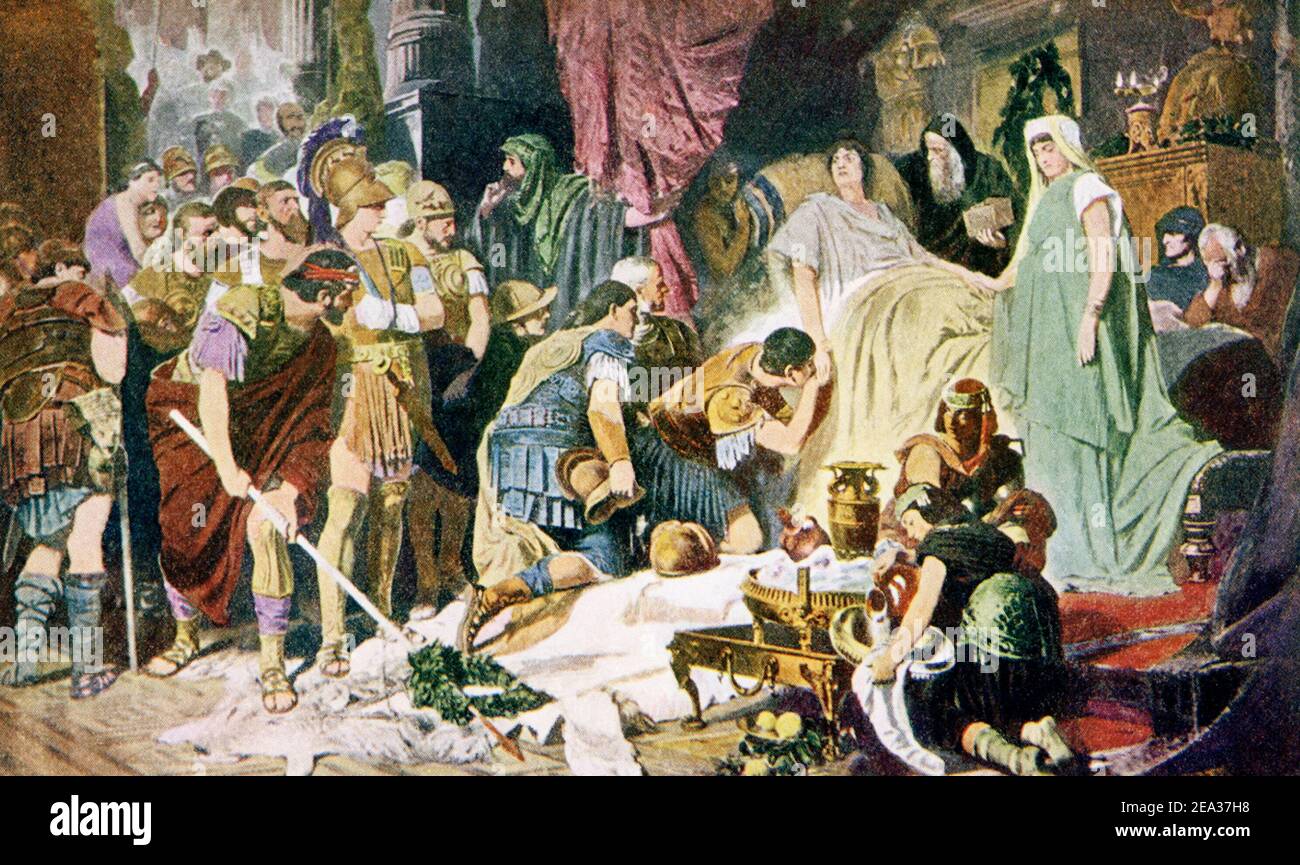 Alexander the Great (356–323 B.C.) was the son of Philip II. He was the king of Macedon from 336 to 323 B.C. Considered one of the greatest generals of all time, he conquered and ruled land from Macedonia and Greece in the west to India in the east. Alexander the Great fell ill in Babylon on his return to Greece and Macedonia. The year was 323 B.C., and here Alexander is shown on his deathbed. With him is his wife Roxanne, carrying their child, and his generals (the future diadochoi who fight one another for control of his empire) and other followers. Stock Photohttps://www.alamy.com/image-license-details/?v=1https://www.alamy.com/alexander-the-great-356323-bc-was-the-son-of-philip-ii-he-was-the-king-of-macedon-from-336-to-323-bc-considered-one-of-the-greatest-generals-of-all-time-he-conquered-and-ruled-land-from-macedonia-and-greece-in-the-west-to-india-in-the-east-alexander-the-great-fell-ill-in-babylon-on-his-return-to-greece-and-macedonia-the-year-was-323-bc-and-here-alexander-is-shown-on-his-deathbed-with-him-is-his-wife-roxanne-carrying-their-child-and-his-generals-the-future-diadochoi-who-fight-one-another-for-control-of-his-empire-and-other-followers-image402056852.html
Alexander the Great (356–323 B.C.) was the son of Philip II. He was the king of Macedon from 336 to 323 B.C. Considered one of the greatest generals of all time, he conquered and ruled land from Macedonia and Greece in the west to India in the east. Alexander the Great fell ill in Babylon on his return to Greece and Macedonia. The year was 323 B.C., and here Alexander is shown on his deathbed. With him is his wife Roxanne, carrying their child, and his generals (the future diadochoi who fight one another for control of his empire) and other followers. Stock Photohttps://www.alamy.com/image-license-details/?v=1https://www.alamy.com/alexander-the-great-356323-bc-was-the-son-of-philip-ii-he-was-the-king-of-macedon-from-336-to-323-bc-considered-one-of-the-greatest-generals-of-all-time-he-conquered-and-ruled-land-from-macedonia-and-greece-in-the-west-to-india-in-the-east-alexander-the-great-fell-ill-in-babylon-on-his-return-to-greece-and-macedonia-the-year-was-323-bc-and-here-alexander-is-shown-on-his-deathbed-with-him-is-his-wife-roxanne-carrying-their-child-and-his-generals-the-future-diadochoi-who-fight-one-another-for-control-of-his-empire-and-other-followers-image402056852.htmlRF2EA37H8–Alexander the Great (356–323 B.C.) was the son of Philip II. He was the king of Macedon from 336 to 323 B.C. Considered one of the greatest generals of all time, he conquered and ruled land from Macedonia and Greece in the west to India in the east. Alexander the Great fell ill in Babylon on his return to Greece and Macedonia. The year was 323 B.C., and here Alexander is shown on his deathbed. With him is his wife Roxanne, carrying their child, and his generals (the future diadochoi who fight one another for control of his empire) and other followers.
 Alexander the Great discovering the body of Darius King of Persia 331 BC. Hand-colored woodcut of a Gustave Dore illustration Stock Photohttps://www.alamy.com/image-license-details/?v=1https://www.alamy.com/alexander-the-great-discovering-the-body-of-darius-king-of-persia-image4938797.html
Alexander the Great discovering the body of Darius King of Persia 331 BC. Hand-colored woodcut of a Gustave Dore illustration Stock Photohttps://www.alamy.com/image-license-details/?v=1https://www.alamy.com/alexander-the-great-discovering-the-body-of-darius-king-of-persia-image4938797.htmlRMAM2M2E–Alexander the Great discovering the body of Darius King of Persia 331 BC. Hand-colored woodcut of a Gustave Dore illustration
 Image from page 357 of 'Comic History of Greece from the earliest times to the death of Alexander the Great . Illustrated, etc' . Stock Photohttps://www.alamy.com/image-license-details/?v=1https://www.alamy.com/image-from-page-357-of-comic-history-of-greece-from-the-earliest-times-to-the-death-of-alexander-the-great-illustrated-etc-image217053542.html
Image from page 357 of 'Comic History of Greece from the earliest times to the death of Alexander the Great . Illustrated, etc' . Stock Photohttps://www.alamy.com/image-license-details/?v=1https://www.alamy.com/image-from-page-357-of-comic-history-of-greece-from-the-earliest-times-to-the-death-of-alexander-the-great-illustrated-etc-image217053542.htmlRMPH3J06–Image from page 357 of 'Comic History of Greece from the earliest times to the death of Alexander the Great . Illustrated, etc' .
 Alexander the Great kills Clitus, 328BC Stock Photohttps://www.alamy.com/image-license-details/?v=1https://www.alamy.com/stock-photo-alexander-the-great-kills-clitus-328bc-56691274.html
Alexander the Great kills Clitus, 328BC Stock Photohttps://www.alamy.com/image-license-details/?v=1https://www.alamy.com/stock-photo-alexander-the-great-kills-clitus-328bc-56691274.htmlRMD86E8A–Alexander the Great kills Clitus, 328BC
 The Death of Alexander the Great, Unknown, Ghent, Belgium, about 1475, Tempera colors, gold leaf, and gold paint on parchment, Leaf: 43.8 x 30.5 cm (17 1/4 x 12 in Stock Photohttps://www.alamy.com/image-license-details/?v=1https://www.alamy.com/the-death-of-alexander-the-great-unknown-ghent-belgium-about-1475-tempera-colors-gold-leaf-and-gold-paint-on-parchment-leaf-438-x-305-cm-17-14-x-12-in-image261260471.html
The Death of Alexander the Great, Unknown, Ghent, Belgium, about 1475, Tempera colors, gold leaf, and gold paint on parchment, Leaf: 43.8 x 30.5 cm (17 1/4 x 12 in Stock Photohttps://www.alamy.com/image-license-details/?v=1https://www.alamy.com/the-death-of-alexander-the-great-unknown-ghent-belgium-about-1475-tempera-colors-gold-leaf-and-gold-paint-on-parchment-leaf-438-x-305-cm-17-14-x-12-in-image261260471.htmlRMW51CB3–The Death of Alexander the Great, Unknown, Ghent, Belgium, about 1475, Tempera colors, gold leaf, and gold paint on parchment, Leaf: 43.8 x 30.5 cm (17 1/4 x 12 in
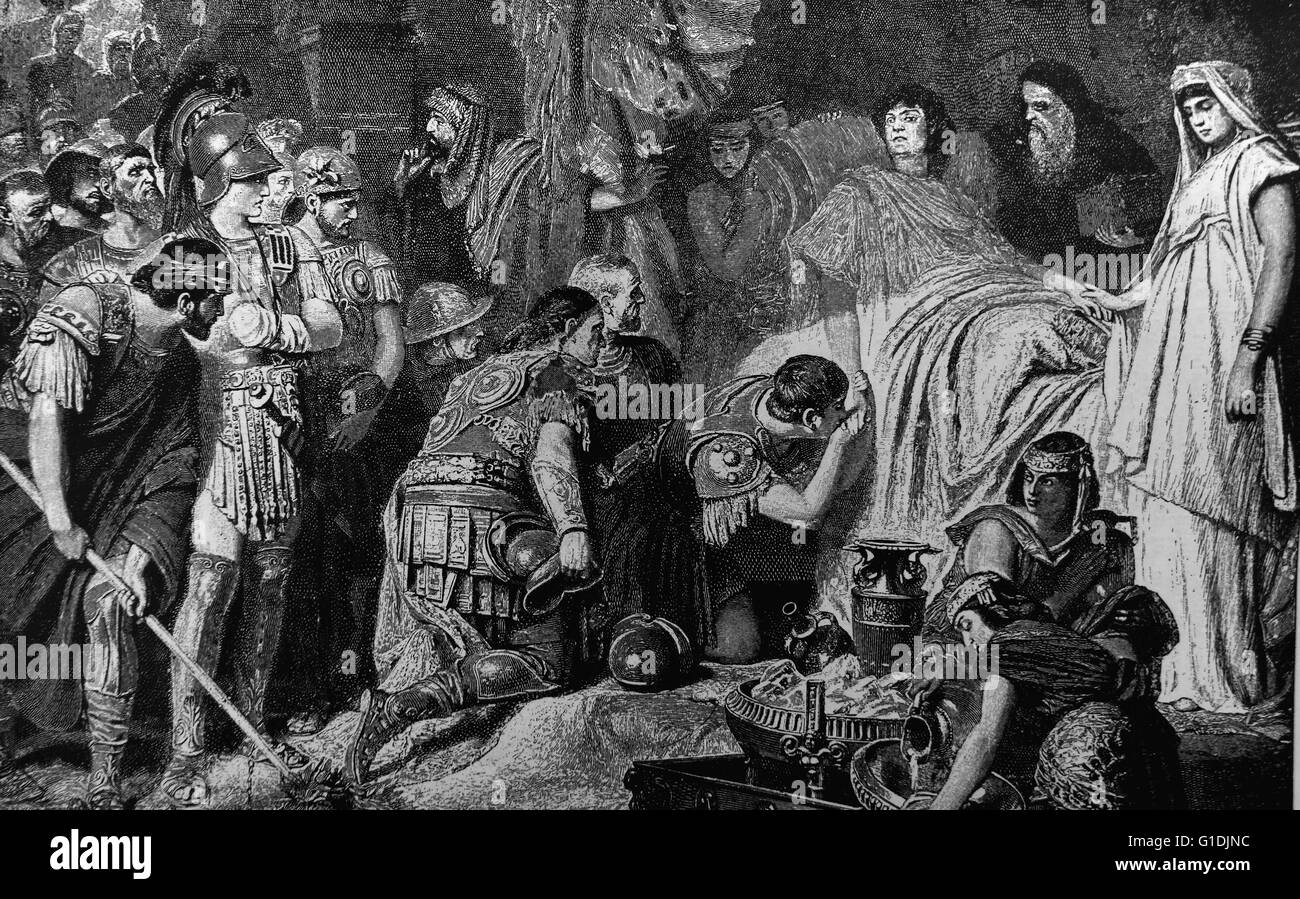 Painting depicting the death of Alexander III of Macedon, (356-323 BC) commonly known as Alexander the Great, was a King of the Ancient Greek kingdom of Macedon and a member of the Argead dynasty, an ancient Greek royal house, at Babylon Stock Photohttps://www.alamy.com/image-license-details/?v=1https://www.alamy.com/stock-photo-painting-depicting-the-death-of-alexander-iii-of-macedon-356-323-bc-104176952.html
Painting depicting the death of Alexander III of Macedon, (356-323 BC) commonly known as Alexander the Great, was a King of the Ancient Greek kingdom of Macedon and a member of the Argead dynasty, an ancient Greek royal house, at Babylon Stock Photohttps://www.alamy.com/image-license-details/?v=1https://www.alamy.com/stock-photo-painting-depicting-the-death-of-alexander-iii-of-macedon-356-323-bc-104176952.htmlRMG1DJNC–Painting depicting the death of Alexander III of Macedon, (356-323 BC) commonly known as Alexander the Great, was a King of the Ancient Greek kingdom of Macedon and a member of the Argead dynasty, an ancient Greek royal house, at Babylon
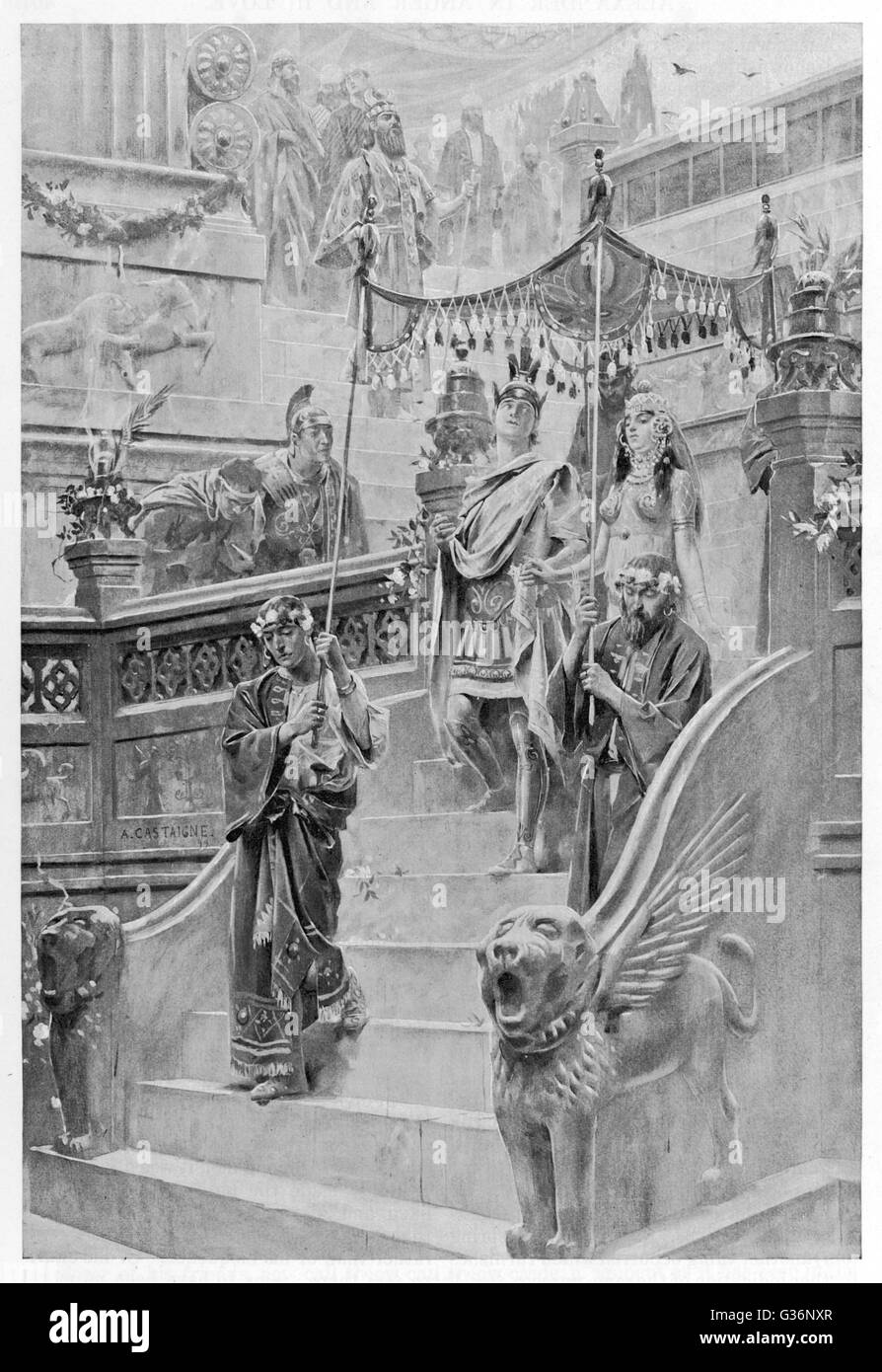 Alexander the Great, King of Macedon, marries Roxana Stock Photohttps://www.alamy.com/image-license-details/?v=1https://www.alamy.com/stock-photo-alexander-the-great-king-of-macedon-marries-roxana-105255103.html
Alexander the Great, King of Macedon, marries Roxana Stock Photohttps://www.alamy.com/image-license-details/?v=1https://www.alamy.com/stock-photo-alexander-the-great-king-of-macedon-marries-roxana-105255103.htmlRMG36NXR–Alexander the Great, King of Macedon, marries Roxana
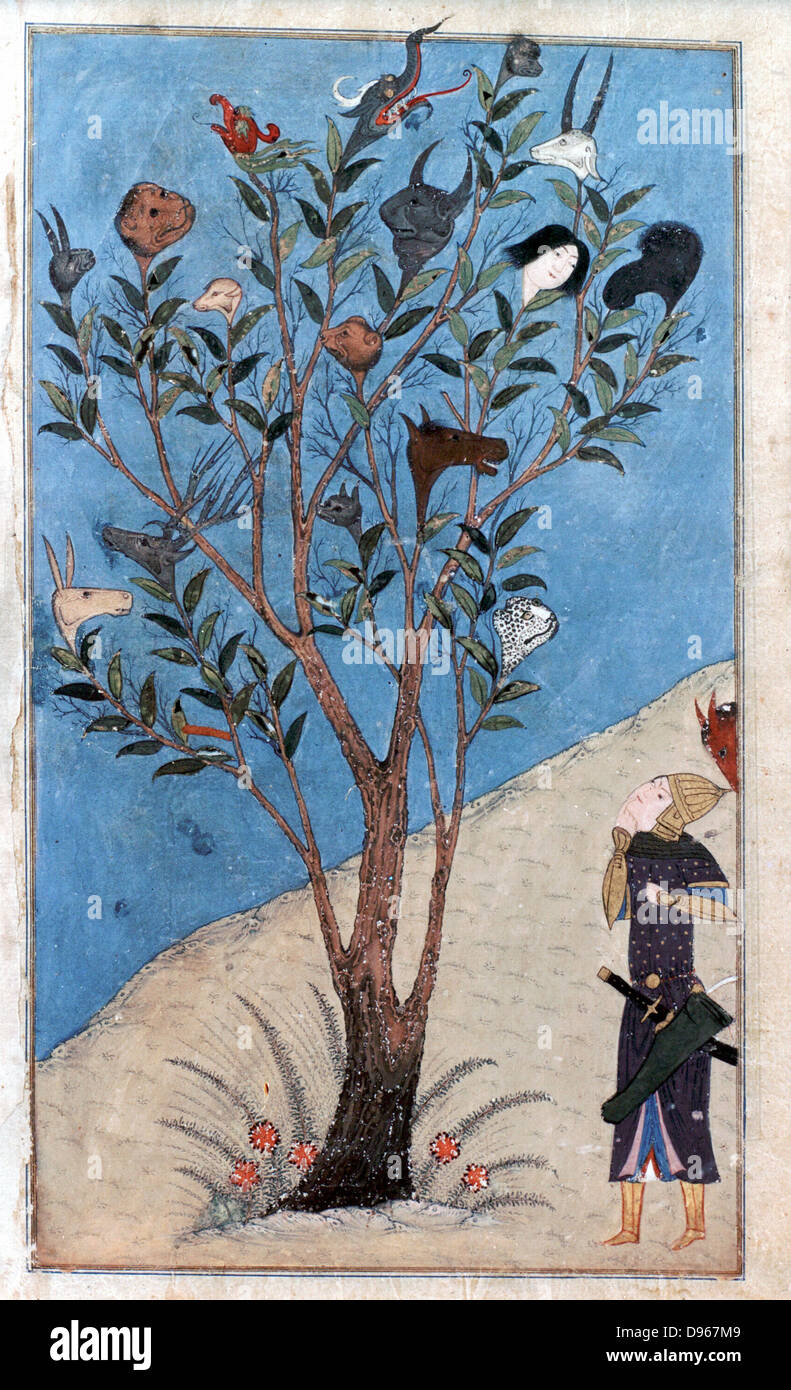 Alexander the Great (Alexander III of Macedon) 356-323 BC. Alexander being told that, great conqueror though he is, he himself will be conquered by death. Persian manuscript of 1425. Stock Photohttps://www.alamy.com/image-license-details/?v=1https://www.alamy.com/stock-photo-alexander-the-great-alexander-iii-of-macedon-356-323-bc-alexander-57300777.html
Alexander the Great (Alexander III of Macedon) 356-323 BC. Alexander being told that, great conqueror though he is, he himself will be conquered by death. Persian manuscript of 1425. Stock Photohttps://www.alamy.com/image-license-details/?v=1https://www.alamy.com/stock-photo-alexander-the-great-alexander-iii-of-macedon-356-323-bc-alexander-57300777.htmlRMD967M9–Alexander the Great (Alexander III of Macedon) 356-323 BC. Alexander being told that, great conqueror though he is, he himself will be conquered by death. Persian manuscript of 1425.
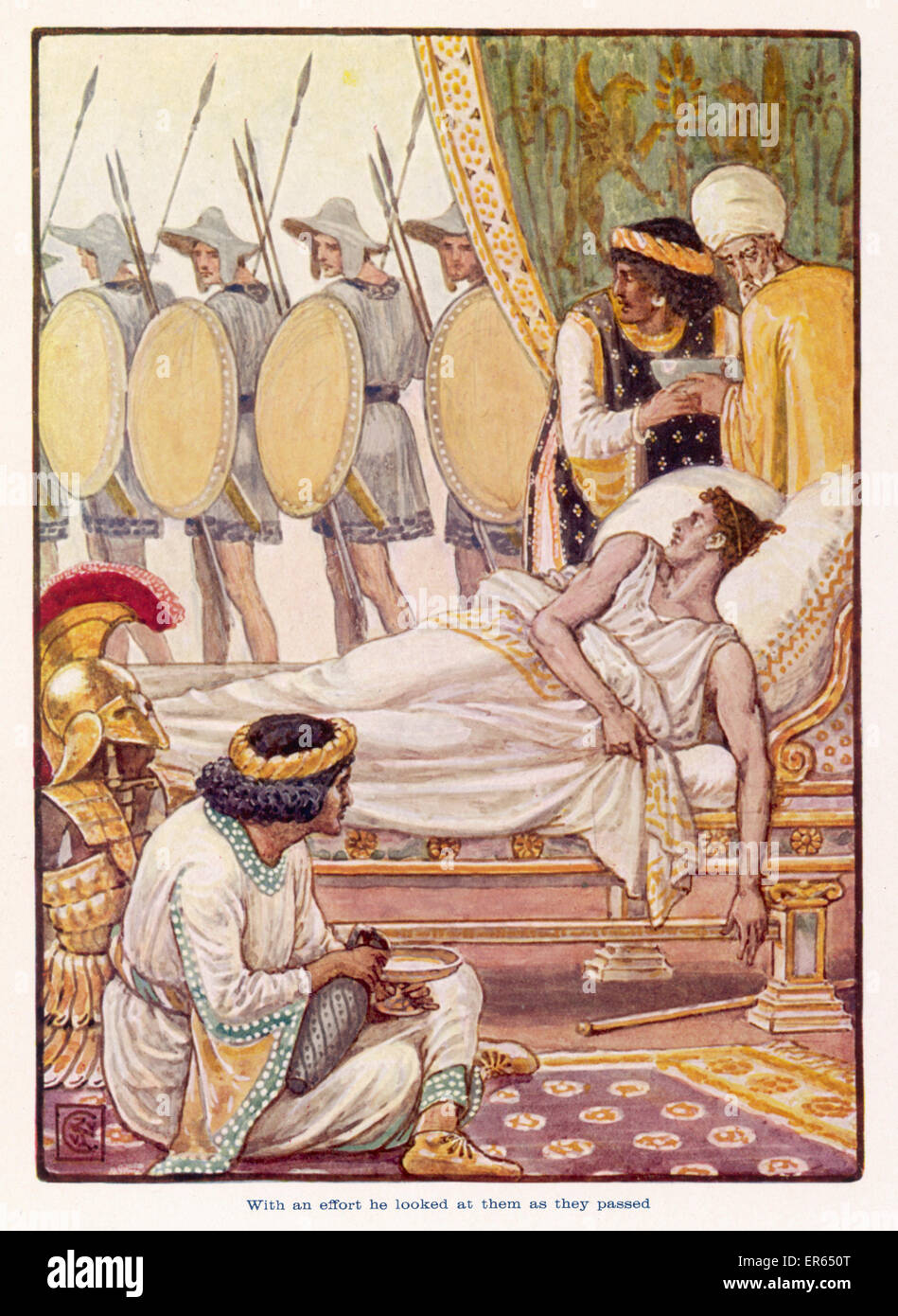 ALEXANDER THE GREAT Dying of a fever at the age of 33, Alexander watches his faithful troops filing by his bed to pay their last respects as he lies on his deathbed. 323 BC Stock Photohttps://www.alamy.com/image-license-details/?v=1https://www.alamy.com/stock-photo-alexander-the-great-dying-of-a-fever-at-the-age-of-33-alexander-watches-83114216.html
ALEXANDER THE GREAT Dying of a fever at the age of 33, Alexander watches his faithful troops filing by his bed to pay their last respects as he lies on his deathbed. 323 BC Stock Photohttps://www.alamy.com/image-license-details/?v=1https://www.alamy.com/stock-photo-alexander-the-great-dying-of-a-fever-at-the-age-of-33-alexander-watches-83114216.htmlRMER650T–ALEXANDER THE GREAT Dying of a fever at the age of 33, Alexander watches his faithful troops filing by his bed to pay their last respects as he lies on his deathbed. 323 BC
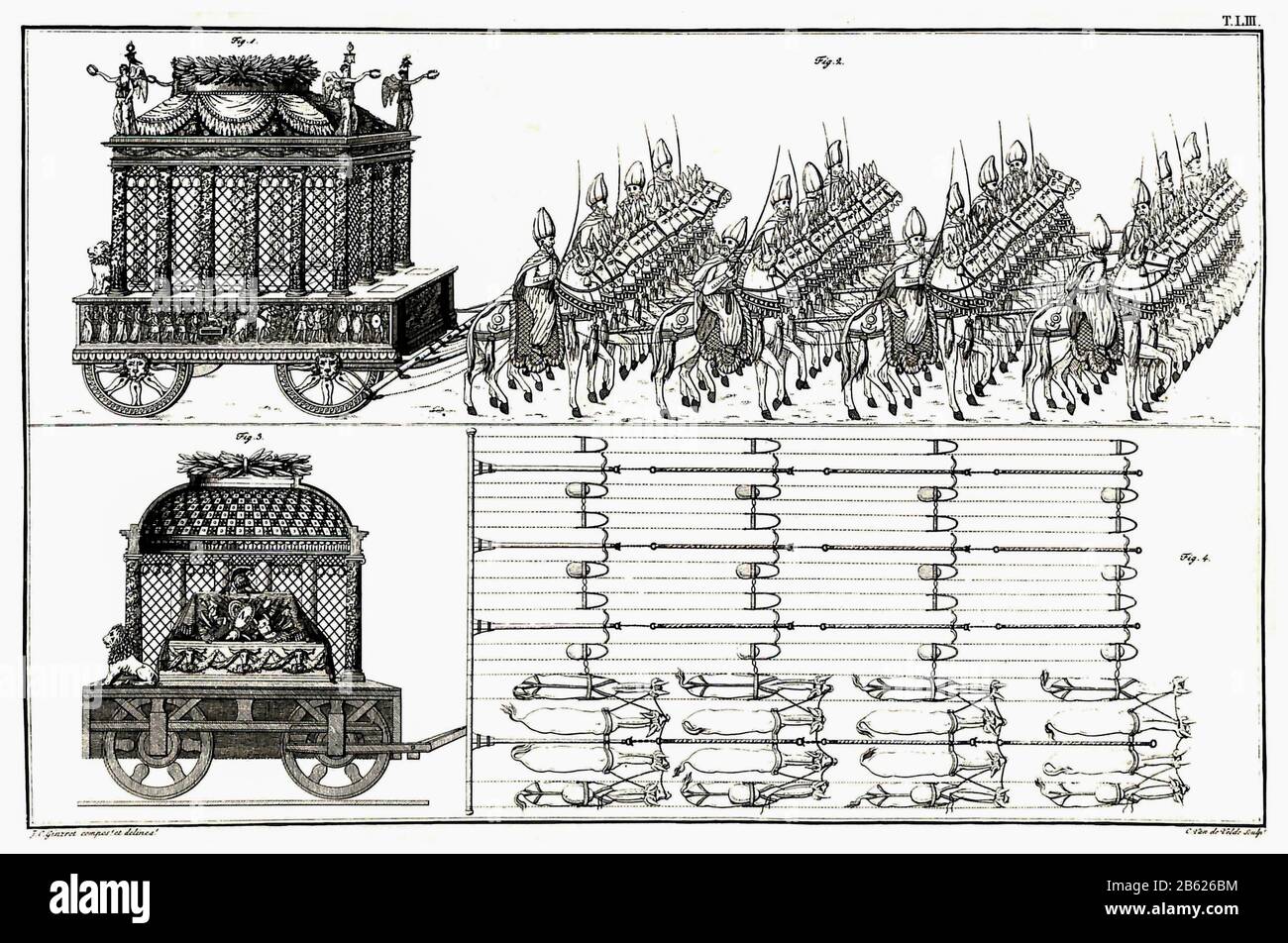 Funeral wagon of Alexander the Great, illustration by Johann Christian Ginzrot, 1817 Stock Photohttps://www.alamy.com/image-license-details/?v=1https://www.alamy.com/funeral-wagon-of-alexander-the-great-illustration-by-johann-christian-ginzrot-1817-image347944232.html
Funeral wagon of Alexander the Great, illustration by Johann Christian Ginzrot, 1817 Stock Photohttps://www.alamy.com/image-license-details/?v=1https://www.alamy.com/funeral-wagon-of-alexander-the-great-illustration-by-johann-christian-ginzrot-1817-image347944232.htmlRM2B626BM–Funeral wagon of Alexander the Great, illustration by Johann Christian Ginzrot, 1817
 The Death of Alexander the Great. Unknown Stock Photohttps://www.alamy.com/image-license-details/?v=1https://www.alamy.com/the-death-of-alexander-the-great-unknown-image416608416.html
The Death of Alexander the Great. Unknown Stock Photohttps://www.alamy.com/image-license-details/?v=1https://www.alamy.com/the-death-of-alexander-the-great-unknown-image416608416.htmlRM2F5P480–The Death of Alexander the Great. Unknown
 Ancient Greek. Tetradrachm (Coin) Portraying Alexander the Great. 297 BC–281 BC. Ephesus. Silver Following the premature death of Alexander the Great in 323 BC, his generals, friends, and heirs engaged in forty years of wars over his empire. Lysimachus (r. 323–281 BC), one of Alexander’s companions and bodyguards, used the king’s image on his own coins in order to cast himself in the role of successor and legitimize his claim to the kingdom of Thrace. Alexander, responsible for establishing the conventions of royal portraiture, is depicted in his preferred manner youthful and clean-shaven, wit Stock Photohttps://www.alamy.com/image-license-details/?v=1https://www.alamy.com/ancient-greek-tetradrachm-coin-portraying-alexander-the-great-297-bc281-bc-ephesus-silver-following-the-premature-death-of-alexander-the-great-in-323-bc-his-generals-friends-and-heirs-engaged-in-forty-years-of-wars-over-his-empire-lysimachus-r-323281-bc-one-of-alexanders-companions-and-bodyguards-used-the-kings-image-on-his-own-coins-in-order-to-cast-himself-in-the-role-of-successor-and-legitimize-his-claim-to-the-kingdom-of-thrace-alexander-responsible-for-establishing-the-conventions-of-royal-portraiture-is-depicted-in-his-preferred-manner-youthful-and-clean-shaven-wit-image337978943.html
Ancient Greek. Tetradrachm (Coin) Portraying Alexander the Great. 297 BC–281 BC. Ephesus. Silver Following the premature death of Alexander the Great in 323 BC, his generals, friends, and heirs engaged in forty years of wars over his empire. Lysimachus (r. 323–281 BC), one of Alexander’s companions and bodyguards, used the king’s image on his own coins in order to cast himself in the role of successor and legitimize his claim to the kingdom of Thrace. Alexander, responsible for establishing the conventions of royal portraiture, is depicted in his preferred manner youthful and clean-shaven, wit Stock Photohttps://www.alamy.com/image-license-details/?v=1https://www.alamy.com/ancient-greek-tetradrachm-coin-portraying-alexander-the-great-297-bc281-bc-ephesus-silver-following-the-premature-death-of-alexander-the-great-in-323-bc-his-generals-friends-and-heirs-engaged-in-forty-years-of-wars-over-his-empire-lysimachus-r-323281-bc-one-of-alexanders-companions-and-bodyguards-used-the-kings-image-on-his-own-coins-in-order-to-cast-himself-in-the-role-of-successor-and-legitimize-his-claim-to-the-kingdom-of-thrace-alexander-responsible-for-establishing-the-conventions-of-royal-portraiture-is-depicted-in-his-preferred-manner-youthful-and-clean-shaven-wit-image337978943.htmlRM2AHT7GF–Ancient Greek. Tetradrachm (Coin) Portraying Alexander the Great. 297 BC–281 BC. Ephesus. Silver Following the premature death of Alexander the Great in 323 BC, his generals, friends, and heirs engaged in forty years of wars over his empire. Lysimachus (r. 323–281 BC), one of Alexander’s companions and bodyguards, used the king’s image on his own coins in order to cast himself in the role of successor and legitimize his claim to the kingdom of Thrace. Alexander, responsible for establishing the conventions of royal portraiture, is depicted in his preferred manner youthful and clean-shaven, wit
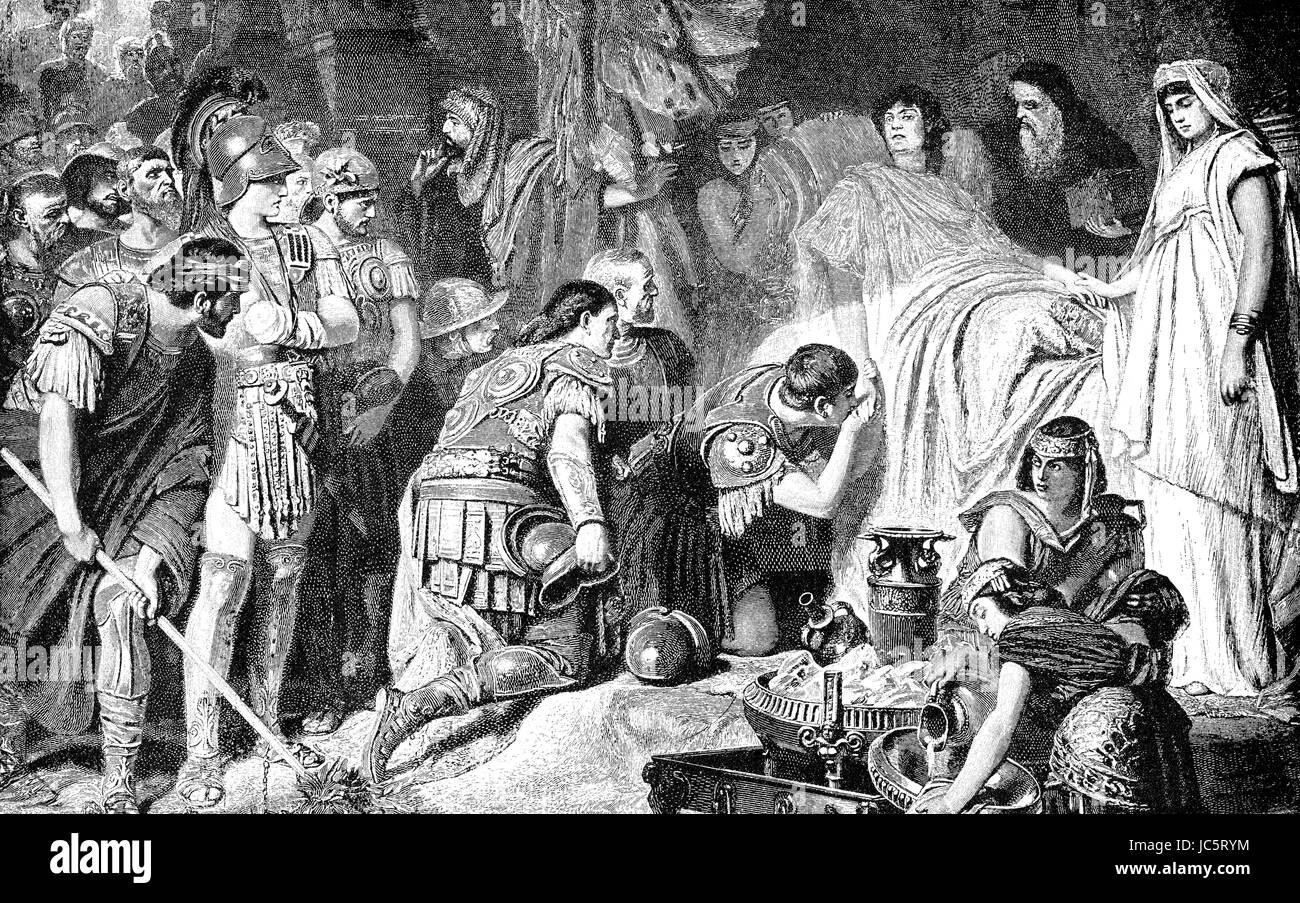 The death of Alexander the Great in 323 BC Stock Photohttps://www.alamy.com/image-license-details/?v=1https://www.alamy.com/stock-photo-the-death-of-alexander-the-great-in-323-bc-145187384.html
The death of Alexander the Great in 323 BC Stock Photohttps://www.alamy.com/image-license-details/?v=1https://www.alamy.com/stock-photo-the-death-of-alexander-the-great-in-323-bc-145187384.htmlRMJC5RYM–The death of Alexander the Great in 323 BC
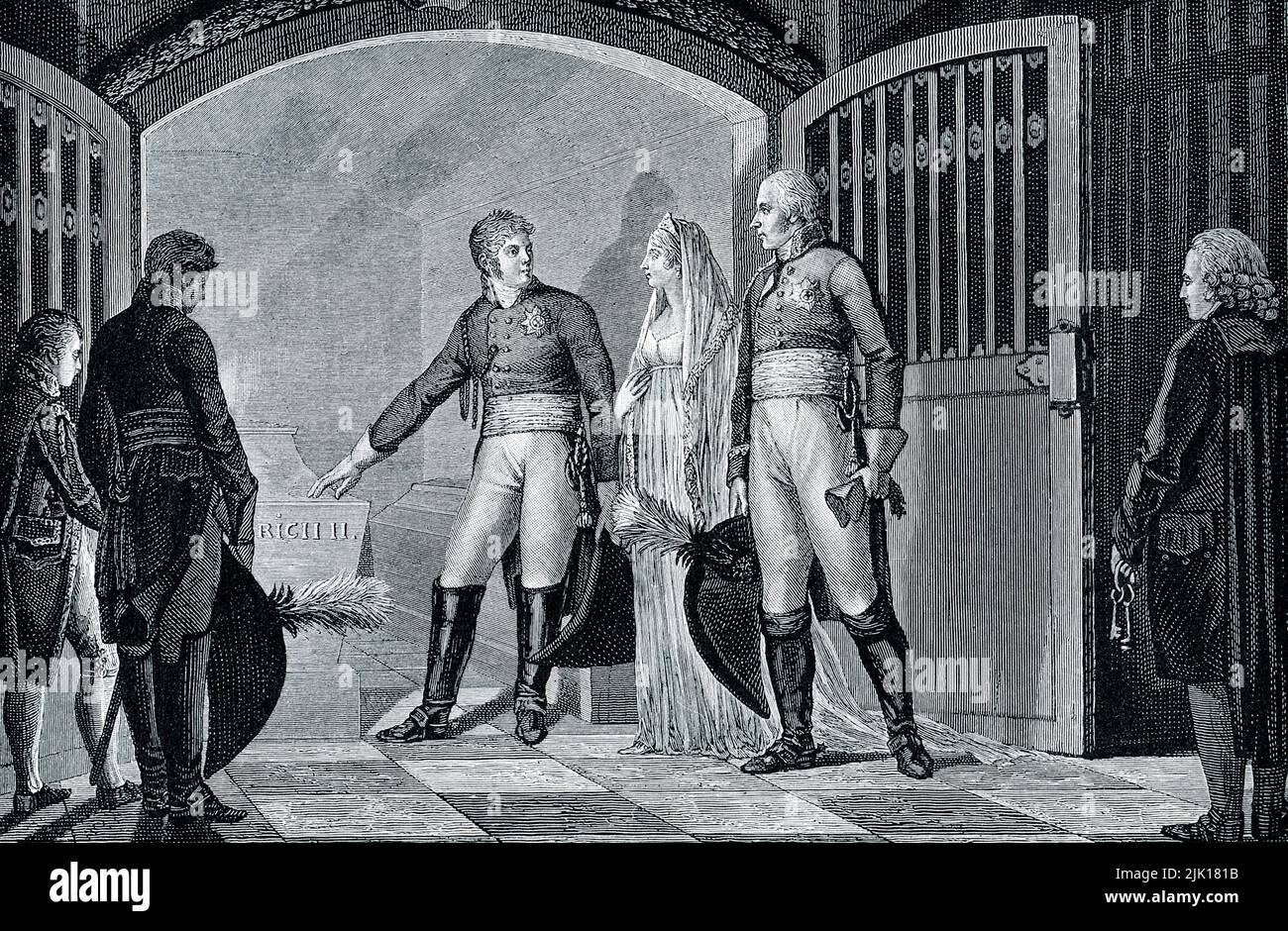 The 1906 caption reads: “ALEXANDER'S OATH AT THE TOMB OF FREDERICK THE GREAT.—Alexander I., who became Czar through the tragic death of Paul, joined Austria and Prussia in opposing Napoleon. With Louise and Frederick William, the sovereigns of Prussia, he went down into the tomb of Prussia's hero, Frederick the Great, and there with solemn enthusiasm the monarchs swore to stand together in resistance to French aggression.” Alexander I was Emperor of Russia from 1801 to his death in 1825. Stock Photohttps://www.alamy.com/image-license-details/?v=1https://www.alamy.com/the-1906-caption-reads-alexanders-oath-at-the-tomb-of-frederick-the-greatalexander-i-who-became-czar-through-the-tragic-death-of-paul-joined-austria-and-prussia-in-opposing-napoleon-with-louise-and-frederick-william-the-sovereigns-of-prussia-he-went-down-into-the-tomb-of-prussias-hero-frederick-the-great-and-there-with-solemn-enthusiasm-the-monarchs-swore-to-stand-together-in-resistance-to-french-aggression-alexander-i-was-emperor-of-russia-from-1801-to-his-death-in-1825-image476386663.html
The 1906 caption reads: “ALEXANDER'S OATH AT THE TOMB OF FREDERICK THE GREAT.—Alexander I., who became Czar through the tragic death of Paul, joined Austria and Prussia in opposing Napoleon. With Louise and Frederick William, the sovereigns of Prussia, he went down into the tomb of Prussia's hero, Frederick the Great, and there with solemn enthusiasm the monarchs swore to stand together in resistance to French aggression.” Alexander I was Emperor of Russia from 1801 to his death in 1825. Stock Photohttps://www.alamy.com/image-license-details/?v=1https://www.alamy.com/the-1906-caption-reads-alexanders-oath-at-the-tomb-of-frederick-the-greatalexander-i-who-became-czar-through-the-tragic-death-of-paul-joined-austria-and-prussia-in-opposing-napoleon-with-louise-and-frederick-william-the-sovereigns-of-prussia-he-went-down-into-the-tomb-of-prussias-hero-frederick-the-great-and-there-with-solemn-enthusiasm-the-monarchs-swore-to-stand-together-in-resistance-to-french-aggression-alexander-i-was-emperor-of-russia-from-1801-to-his-death-in-1825-image476386663.htmlRF2JK181B–The 1906 caption reads: “ALEXANDER'S OATH AT THE TOMB OF FREDERICK THE GREAT.—Alexander I., who became Czar through the tragic death of Paul, joined Austria and Prussia in opposing Napoleon. With Louise and Frederick William, the sovereigns of Prussia, he went down into the tomb of Prussia's hero, Frederick the Great, and there with solemn enthusiasm the monarchs swore to stand together in resistance to French aggression.” Alexander I was Emperor of Russia from 1801 to his death in 1825.
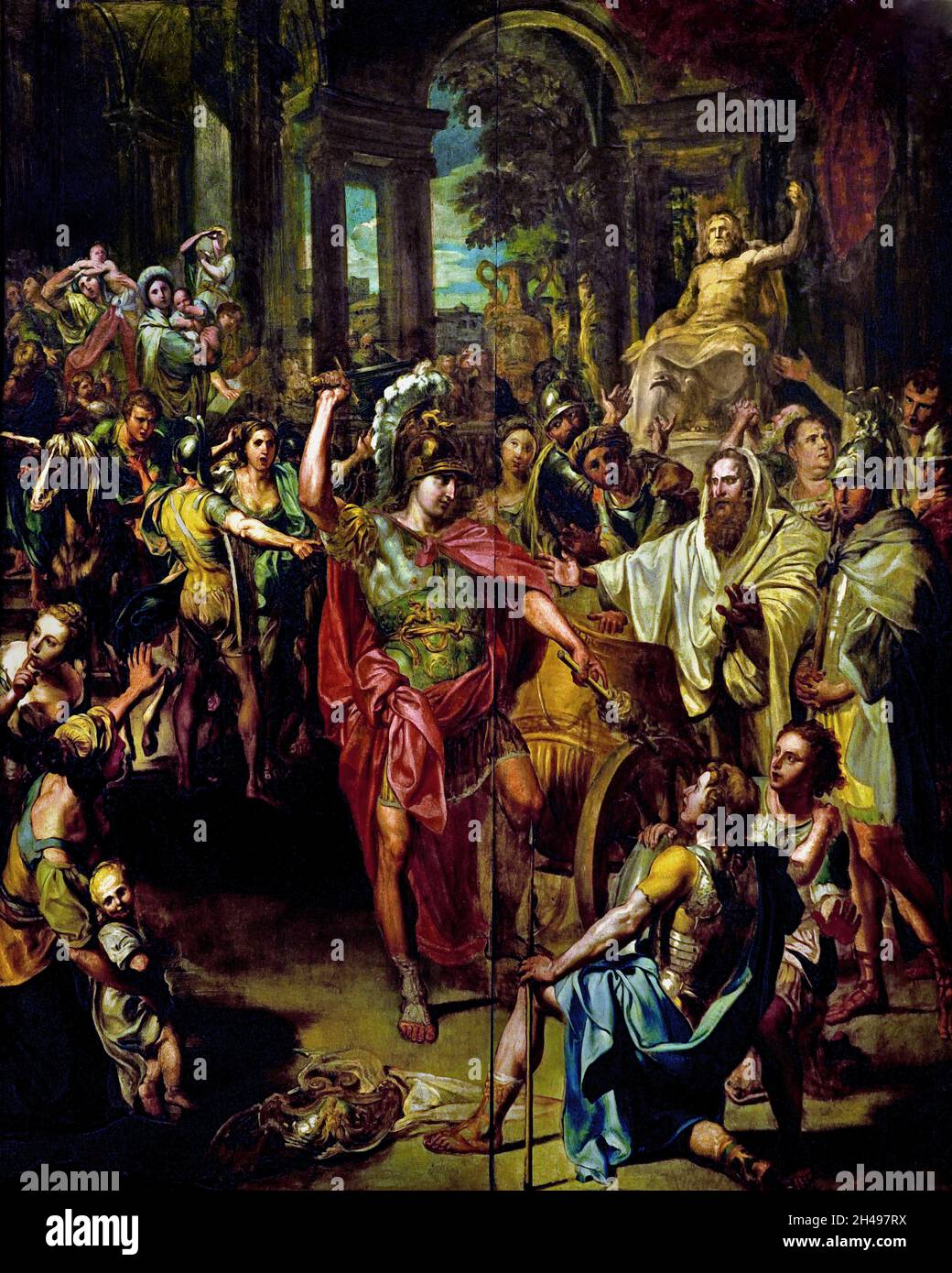 Alessandro scioglie il nodo di Gordio - Alexander the Great Cutting the Gordian Knot. by Gregorio De Ferrari (1647–1726), Italy, Italian, Genoa, Italy, Italian, Alexander the Great, Alexander III of Macedon, 356 BC – 323 BC king of the Ancient Greek kingdom of Macedon from 336 BC until his death in 323 BC. He was one of the greatest military leaders of all time. Greek Greece Stock Photohttps://www.alamy.com/image-license-details/?v=1https://www.alamy.com/alessandro-scioglie-il-nodo-di-gordio-alexander-the-great-cutting-the-gordian-knot-by-gregorio-de-ferrari-16471726-italy-italian-genoa-italy-italian-alexander-the-great-alexander-iii-of-macedon-356-bc-323-bc-king-of-the-ancient-greek-kingdom-of-macedon-from-336-bc-until-his-death-in-323-bc-he-was-one-of-the-greatest-military-leaders-of-all-time-greek-greece-image450131918.html
Alessandro scioglie il nodo di Gordio - Alexander the Great Cutting the Gordian Knot. by Gregorio De Ferrari (1647–1726), Italy, Italian, Genoa, Italy, Italian, Alexander the Great, Alexander III of Macedon, 356 BC – 323 BC king of the Ancient Greek kingdom of Macedon from 336 BC until his death in 323 BC. He was one of the greatest military leaders of all time. Greek Greece Stock Photohttps://www.alamy.com/image-license-details/?v=1https://www.alamy.com/alessandro-scioglie-il-nodo-di-gordio-alexander-the-great-cutting-the-gordian-knot-by-gregorio-de-ferrari-16471726-italy-italian-genoa-italy-italian-alexander-the-great-alexander-iii-of-macedon-356-bc-323-bc-king-of-the-ancient-greek-kingdom-of-macedon-from-336-bc-until-his-death-in-323-bc-he-was-one-of-the-greatest-military-leaders-of-all-time-greek-greece-image450131918.htmlRM2H497RX–Alessandro scioglie il nodo di Gordio - Alexander the Great Cutting the Gordian Knot. by Gregorio De Ferrari (1647–1726), Italy, Italian, Genoa, Italy, Italian, Alexander the Great, Alexander III of Macedon, 356 BC – 323 BC king of the Ancient Greek kingdom of Macedon from 336 BC until his death in 323 BC. He was one of the greatest military leaders of all time. Greek Greece
 Comic History of Greece from the earliest times to the death of Alexander the Great ... Illustrated, etc Image taken from page 336 of 'Comic History of Greece Stock Photohttps://www.alamy.com/image-license-details/?v=1https://www.alamy.com/stock-photo-comic-history-of-greece-from-the-earliest-times-to-the-death-of-alexander-85969206.html
Comic History of Greece from the earliest times to the death of Alexander the Great ... Illustrated, etc Image taken from page 336 of 'Comic History of Greece Stock Photohttps://www.alamy.com/image-license-details/?v=1https://www.alamy.com/stock-photo-comic-history-of-greece-from-the-earliest-times-to-the-death-of-alexander-85969206.htmlRMEYT6GP–Comic History of Greece from the earliest times to the death of Alexander the Great ... Illustrated, etc Image taken from page 336 of 'Comic History of Greece
 Alexander the Great, Greek King of Macedon Stock Photohttps://www.alamy.com/image-license-details/?v=1https://www.alamy.com/stock-photo-alexander-the-great-greek-king-of-macedon-134992823.html
Alexander the Great, Greek King of Macedon Stock Photohttps://www.alamy.com/image-license-details/?v=1https://www.alamy.com/stock-photo-alexander-the-great-greek-king-of-macedon-134992823.htmlRMHRHCM7–Alexander the Great, Greek King of Macedon
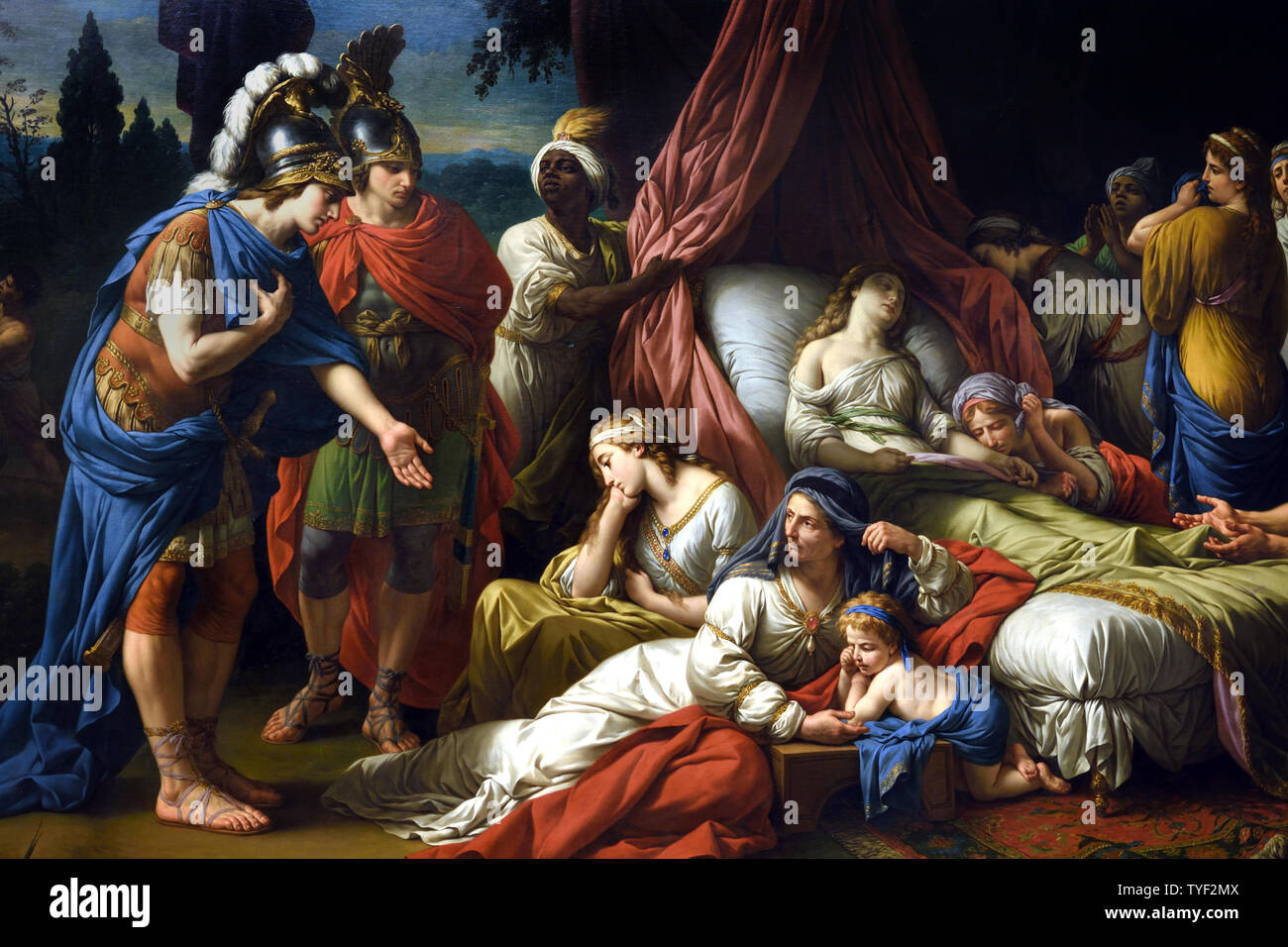 The death of Darius's wife 1784-1785 Louis LAGRENÉE, says the Elder 1724 - 1805 ( After having defeated Darius, king of Persia (330 BC), Alexander the Great collects himself before the body of the wife of his enemy, who died in captivity. ) Stock Photohttps://www.alamy.com/image-license-details/?v=1https://www.alamy.com/the-death-of-dariuss-wife-1784-1785-louis-lagrene-says-the-elder-1724-1805-after-having-defeated-darius-king-of-persia-330-bc-alexander-the-great-collects-himself-before-the-body-of-the-wife-of-his-enemy-who-died-in-captivity-image257872298.html
The death of Darius's wife 1784-1785 Louis LAGRENÉE, says the Elder 1724 - 1805 ( After having defeated Darius, king of Persia (330 BC), Alexander the Great collects himself before the body of the wife of his enemy, who died in captivity. ) Stock Photohttps://www.alamy.com/image-license-details/?v=1https://www.alamy.com/the-death-of-dariuss-wife-1784-1785-louis-lagrene-says-the-elder-1724-1805-after-having-defeated-darius-king-of-persia-330-bc-alexander-the-great-collects-himself-before-the-body-of-the-wife-of-his-enemy-who-died-in-captivity-image257872298.htmlRMTYF2MX–The death of Darius's wife 1784-1785 Louis LAGRENÉE, says the Elder 1724 - 1805 ( After having defeated Darius, king of Persia (330 BC), Alexander the Great collects himself before the body of the wife of his enemy, who died in captivity. )
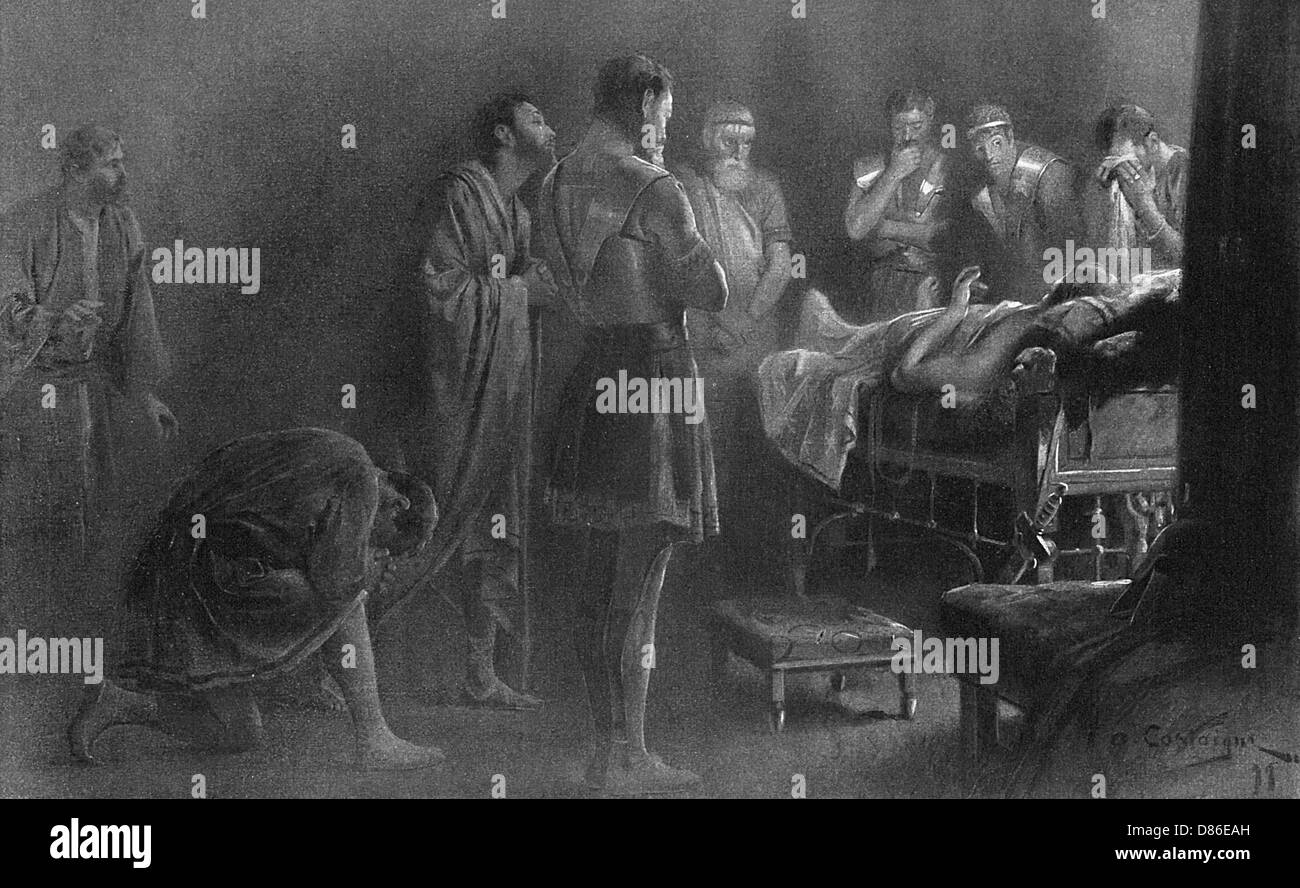 Alexander The Great On His Death Bed Stock Photohttps://www.alamy.com/image-license-details/?v=1https://www.alamy.com/stock-photo-alexander-the-great-on-his-death-bed-56691337.html
Alexander The Great On His Death Bed Stock Photohttps://www.alamy.com/image-license-details/?v=1https://www.alamy.com/stock-photo-alexander-the-great-on-his-death-bed-56691337.htmlRMD86EAH–Alexander The Great On His Death Bed
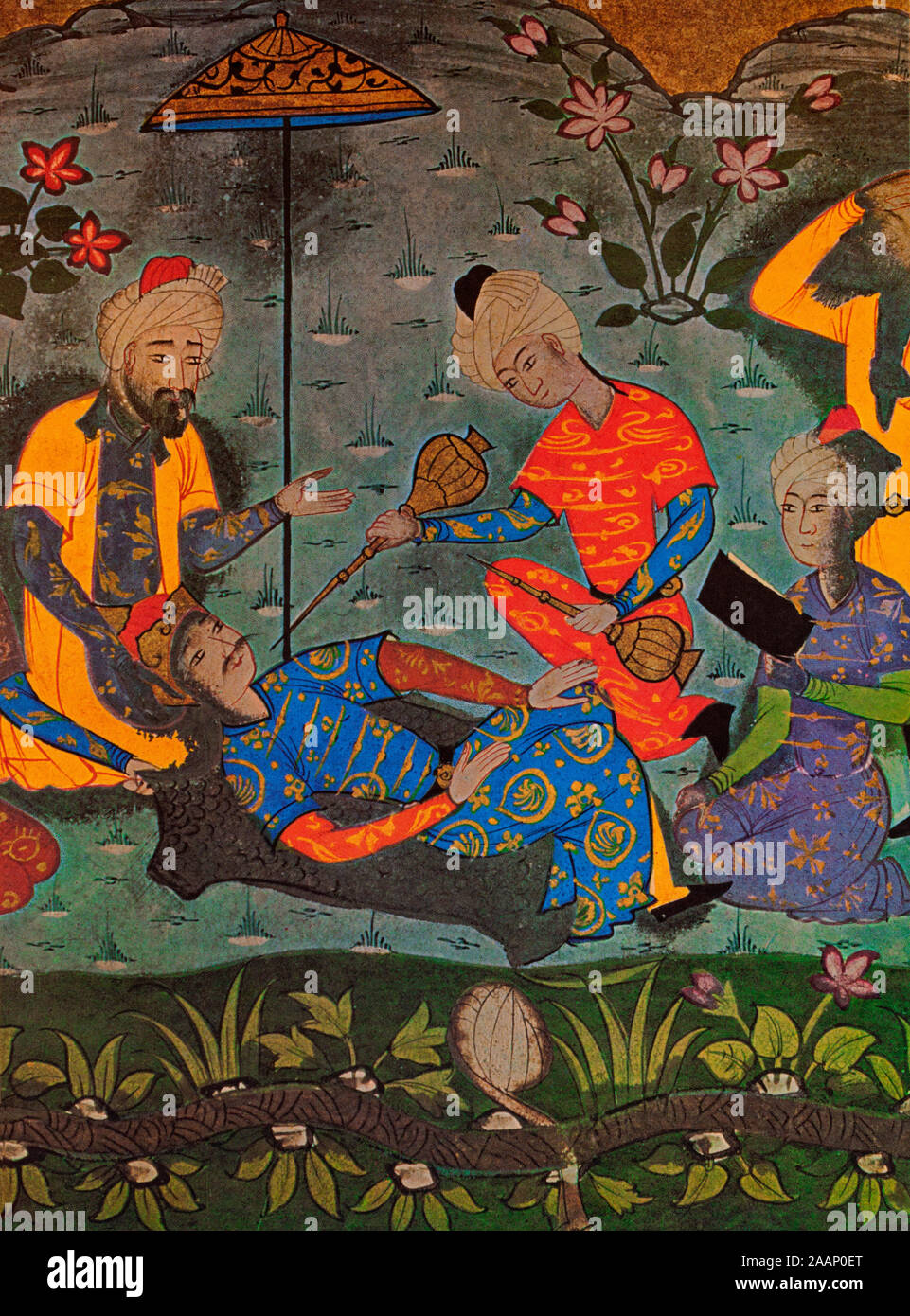 Alexander the Great, said, became a figure of Persian mythology.This Persian miniature show his death on either 10 or 11 June 323 BC, in the palace of Nebuchadnezzar II, in Babylon, at age 32. There are two different versions of Alexander's death; Plutarch's account is that roughly 14 days before his death, Alexander spent the night and next day drinking, developed a fever and died. Stock Photohttps://www.alamy.com/image-license-details/?v=1https://www.alamy.com/alexander-the-great-said-became-a-figure-of-persian-mythologythis-persian-miniature-show-his-death-on-either-10-or-11-june-323-bc-in-the-palace-of-nebuchadnezzar-ii-in-babylon-at-age-32-there-are-two-different-versions-of-alexanders-death-plutarchs-account-is-that-roughly-14-days-before-his-death-alexander-spent-the-night-and-next-day-drinking-developed-a-fever-and-died-image333626912.html
Alexander the Great, said, became a figure of Persian mythology.This Persian miniature show his death on either 10 or 11 June 323 BC, in the palace of Nebuchadnezzar II, in Babylon, at age 32. There are two different versions of Alexander's death; Plutarch's account is that roughly 14 days before his death, Alexander spent the night and next day drinking, developed a fever and died. Stock Photohttps://www.alamy.com/image-license-details/?v=1https://www.alamy.com/alexander-the-great-said-became-a-figure-of-persian-mythologythis-persian-miniature-show-his-death-on-either-10-or-11-june-323-bc-in-the-palace-of-nebuchadnezzar-ii-in-babylon-at-age-32-there-are-two-different-versions-of-alexanders-death-plutarchs-account-is-that-roughly-14-days-before-his-death-alexander-spent-the-night-and-next-day-drinking-developed-a-fever-and-died-image333626912.htmlRM2AAP0ET–Alexander the Great, said, became a figure of Persian mythology.This Persian miniature show his death on either 10 or 11 June 323 BC, in the palace of Nebuchadnezzar II, in Babylon, at age 32. There are two different versions of Alexander's death; Plutarch's account is that roughly 14 days before his death, Alexander spent the night and next day drinking, developed a fever and died.
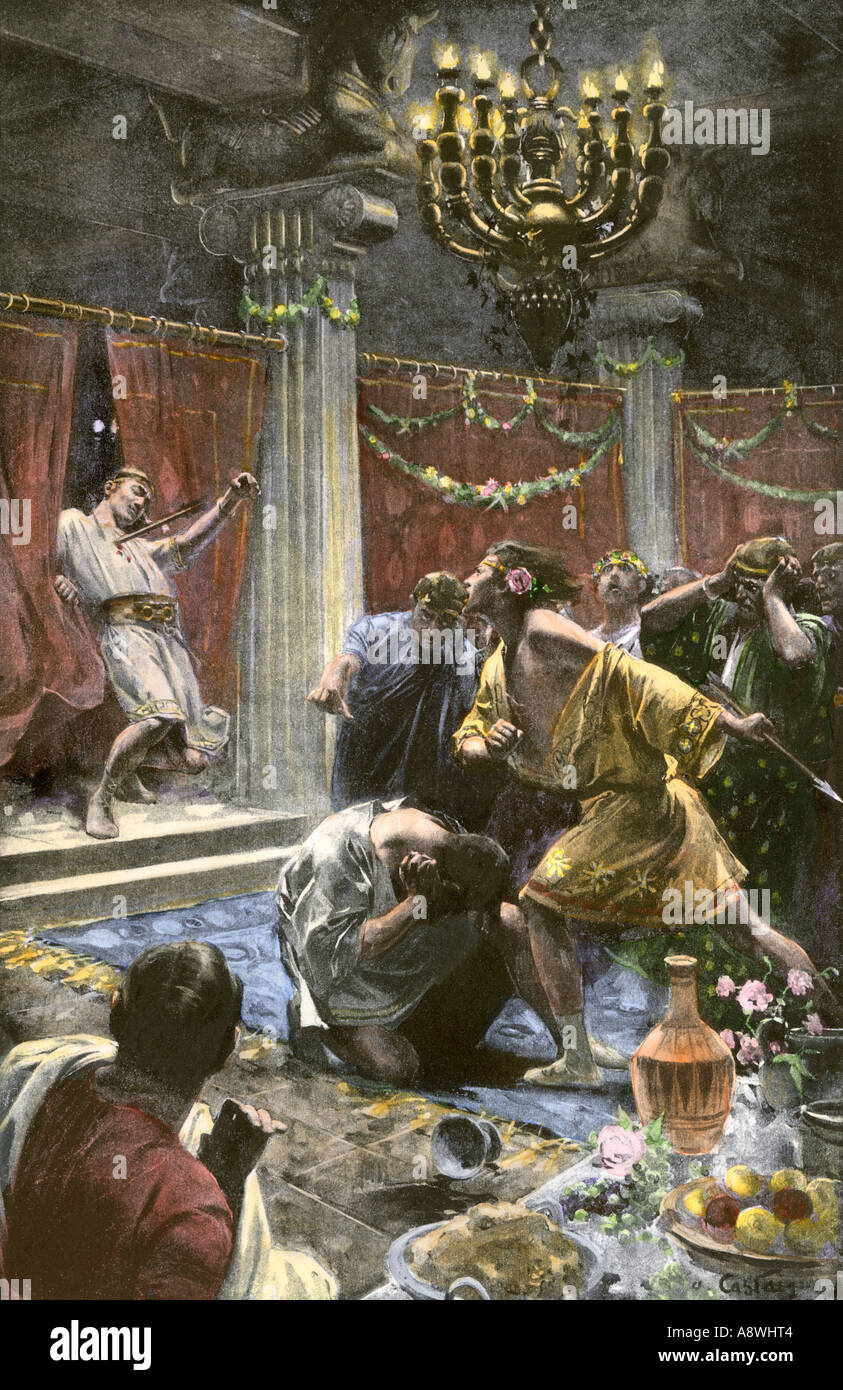 Alexander the Great murdering Clitus in a drunken rage. Hand-colored halftone of an illustration Stock Photohttps://www.alamy.com/image-license-details/?v=1https://www.alamy.com/alexander-the-great-murdering-clitus-in-a-drunken-rage-hand-colored-image6961731.html
Alexander the Great murdering Clitus in a drunken rage. Hand-colored halftone of an illustration Stock Photohttps://www.alamy.com/image-license-details/?v=1https://www.alamy.com/alexander-the-great-murdering-clitus-in-a-drunken-rage-hand-colored-image6961731.htmlRMA8WHT4–Alexander the Great murdering Clitus in a drunken rage. Hand-colored halftone of an illustration
 Image from page 336 of 'Comic History of Greece from the earliest times to the death of Alexander the Great . Illustrated, etc' . Stock Photohttps://www.alamy.com/image-license-details/?v=1https://www.alamy.com/image-from-page-336-of-comic-history-of-greece-from-the-earliest-times-to-the-death-of-alexander-the-great-illustrated-etc-image217052956.html
Image from page 336 of 'Comic History of Greece from the earliest times to the death of Alexander the Great . Illustrated, etc' . Stock Photohttps://www.alamy.com/image-license-details/?v=1https://www.alamy.com/image-from-page-336-of-comic-history-of-greece-from-the-earliest-times-to-the-death-of-alexander-the-great-illustrated-etc-image217052956.htmlRMPH3H78–Image from page 336 of 'Comic History of Greece from the earliest times to the death of Alexander the Great . Illustrated, etc' .
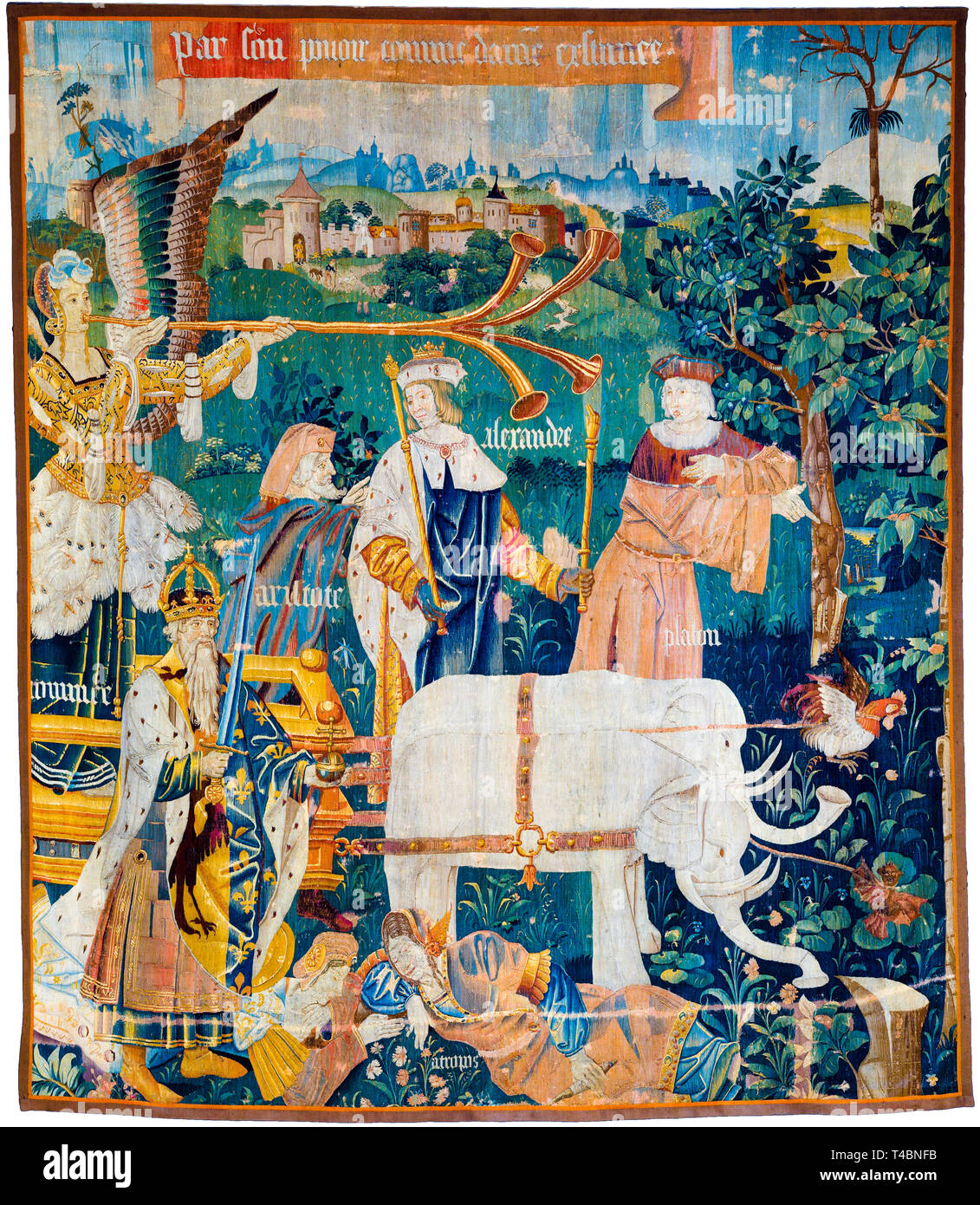 Tapestry featuring Alexander the Great, Plato, Aristotle, Charlemagne, The Triumph of Fame over Death, c. 1500 Stock Photohttps://www.alamy.com/image-license-details/?v=1https://www.alamy.com/tapestry-featuring-alexander-the-great-plato-aristotle-charlemagne-the-triumph-of-fame-over-death-c-1500-image243662143.html
Tapestry featuring Alexander the Great, Plato, Aristotle, Charlemagne, The Triumph of Fame over Death, c. 1500 Stock Photohttps://www.alamy.com/image-license-details/?v=1https://www.alamy.com/tapestry-featuring-alexander-the-great-plato-aristotle-charlemagne-the-triumph-of-fame-over-death-c-1500-image243662143.htmlRMT4BNFB–Tapestry featuring Alexander the Great, Plato, Aristotle, Charlemagne, The Triumph of Fame over Death, c. 1500
 Death of Alexander the Great Fatum Graecorum The fall of world empires in classical antiquity (series title), Round show. Alexander the Great on his deathbed, surrounded by his soldiers mourning his death. The print is based on a lost bas-relief by Gerard de Lairesse and is part of a four-part series on the demise of world empires in classical antiquity., Death of Alexander: Alexander on his deathbed, Johannes Glauber, 1684 - 1726, paper, etching, h 308 mm × w 313 mm Stock Photohttps://www.alamy.com/image-license-details/?v=1https://www.alamy.com/death-of-alexander-the-great-fatum-graecorum-the-fall-of-world-empires-in-classical-antiquity-series-title-round-show-alexander-the-great-on-his-deathbed-surrounded-by-his-soldiers-mourning-his-death-the-print-is-based-on-a-lost-bas-relief-by-gerard-de-lairesse-and-is-part-of-a-four-part-series-on-the-demise-of-world-empires-in-classical-antiquity-death-of-alexander-alexander-on-his-deathbed-johannes-glauber-1684-1726-paper-etching-h-308-mm-w-313-mm-image261405530.html
Death of Alexander the Great Fatum Graecorum The fall of world empires in classical antiquity (series title), Round show. Alexander the Great on his deathbed, surrounded by his soldiers mourning his death. The print is based on a lost bas-relief by Gerard de Lairesse and is part of a four-part series on the demise of world empires in classical antiquity., Death of Alexander: Alexander on his deathbed, Johannes Glauber, 1684 - 1726, paper, etching, h 308 mm × w 313 mm Stock Photohttps://www.alamy.com/image-license-details/?v=1https://www.alamy.com/death-of-alexander-the-great-fatum-graecorum-the-fall-of-world-empires-in-classical-antiquity-series-title-round-show-alexander-the-great-on-his-deathbed-surrounded-by-his-soldiers-mourning-his-death-the-print-is-based-on-a-lost-bas-relief-by-gerard-de-lairesse-and-is-part-of-a-four-part-series-on-the-demise-of-world-empires-in-classical-antiquity-death-of-alexander-alexander-on-his-deathbed-johannes-glauber-1684-1726-paper-etching-h-308-mm-w-313-mm-image261405530.htmlRMW581BP–Death of Alexander the Great Fatum Graecorum The fall of world empires in classical antiquity (series title), Round show. Alexander the Great on his deathbed, surrounded by his soldiers mourning his death. The print is based on a lost bas-relief by Gerard de Lairesse and is part of a four-part series on the demise of world empires in classical antiquity., Death of Alexander: Alexander on his deathbed, Johannes Glauber, 1684 - 1726, paper, etching, h 308 mm × w 313 mm
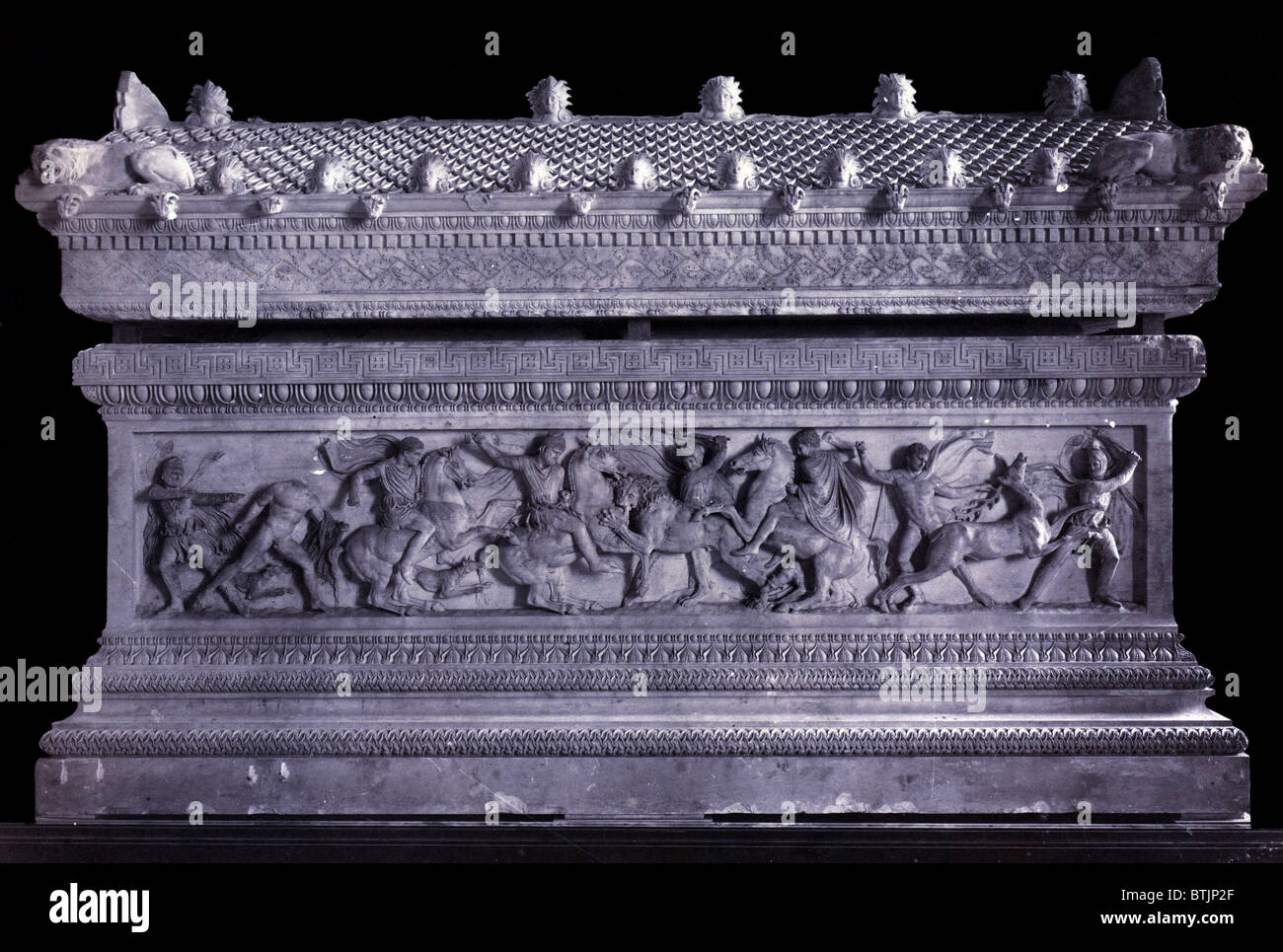 The tomb of Alexander the Great, Constantinople, photograph circa 1880-1910. Stock Photohttps://www.alamy.com/image-license-details/?v=1https://www.alamy.com/stock-photo-the-tomb-of-alexander-the-great-constantinople-photograph-circa-1880-32374567.html
The tomb of Alexander the Great, Constantinople, photograph circa 1880-1910. Stock Photohttps://www.alamy.com/image-license-details/?v=1https://www.alamy.com/stock-photo-the-tomb-of-alexander-the-great-constantinople-photograph-circa-1880-32374567.htmlRMBTJP2F–The tomb of Alexander the Great, Constantinople, photograph circa 1880-1910.
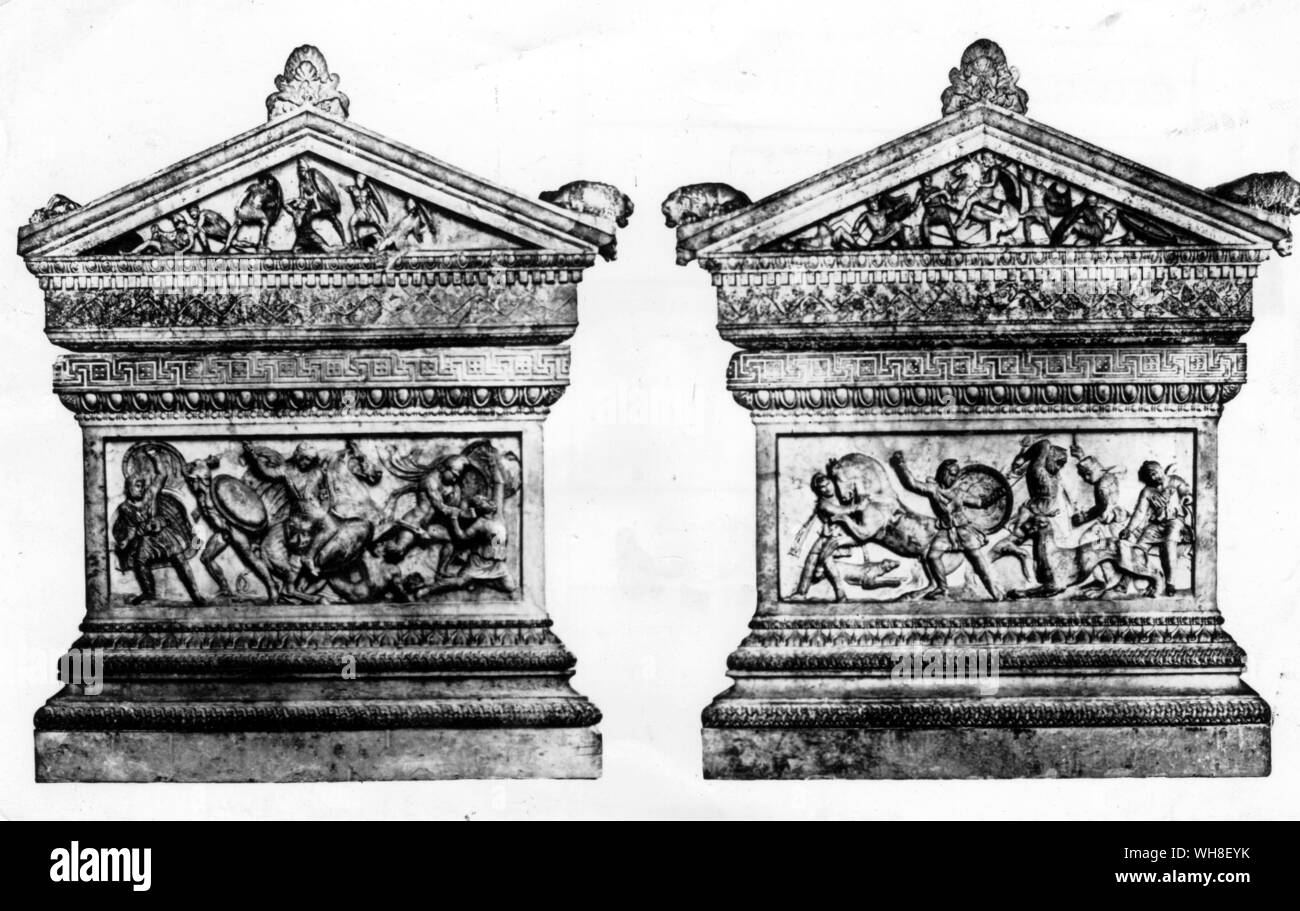 Alexander's Tomb Sarcophagus. Alexander the Great (356 BC-323 BC), King of Macedon 336-323 BC, is considered one of the most successful military commanders in world history, conquering most of the known world before his death. . . Stock Photohttps://www.alamy.com/image-license-details/?v=1https://www.alamy.com/alexanders-tomb-sarcophagus-alexander-the-great-356-bc-323-bc-king-of-macedon-336-323-bc-is-considered-one-of-the-most-successful-military-commanders-in-world-history-conquering-most-of-the-known-world-before-his-death-image268792039.html
Alexander's Tomb Sarcophagus. Alexander the Great (356 BC-323 BC), King of Macedon 336-323 BC, is considered one of the most successful military commanders in world history, conquering most of the known world before his death. . . Stock Photohttps://www.alamy.com/image-license-details/?v=1https://www.alamy.com/alexanders-tomb-sarcophagus-alexander-the-great-356-bc-323-bc-king-of-macedon-336-323-bc-is-considered-one-of-the-most-successful-military-commanders-in-world-history-conquering-most-of-the-known-world-before-his-death-image268792039.htmlRMWH8EYK–Alexander's Tomb Sarcophagus. Alexander the Great (356 BC-323 BC), King of Macedon 336-323 BC, is considered one of the most successful military commanders in world history, conquering most of the known world before his death. . .
 Philip II of Macedon (382 BCE ? 336 BCE ) king (basileus) of Macedonia from 359 BCE until his death in 336 BCE . He was a member of the Argead dynasty, founders of the ancient kingdom, and the father of Alexander the Great. Stock Photohttps://www.alamy.com/image-license-details/?v=1https://www.alamy.com/philip-ii-of-macedon-382-bce-336-bce-king-basileus-of-macedonia-from-359-bce-until-his-death-in-336-bce-he-was-a-member-of-the-argead-dynasty-founders-of-the-ancient-kingdom-and-the-father-of-alexander-the-great-image634298832.html
Philip II of Macedon (382 BCE ? 336 BCE ) king (basileus) of Macedonia from 359 BCE until his death in 336 BCE . He was a member of the Argead dynasty, founders of the ancient kingdom, and the father of Alexander the Great. Stock Photohttps://www.alamy.com/image-license-details/?v=1https://www.alamy.com/philip-ii-of-macedon-382-bce-336-bce-king-basileus-of-macedonia-from-359-bce-until-his-death-in-336-bce-he-was-a-member-of-the-argead-dynasty-founders-of-the-ancient-kingdom-and-the-father-of-alexander-the-great-image634298832.htmlRM2YRXPHM–Philip II of Macedon (382 BCE ? 336 BCE ) king (basileus) of Macedonia from 359 BCE until his death in 336 BCE . He was a member of the Argead dynasty, founders of the ancient kingdom, and the father of Alexander the Great.
 The Death of Alexander the Great; Miroir Historial, about 1475. Stock Photohttps://www.alamy.com/image-license-details/?v=1https://www.alamy.com/the-death-of-alexander-the-great-miroir-historial-about-1475-image631207657.html
The Death of Alexander the Great; Miroir Historial, about 1475. Stock Photohttps://www.alamy.com/image-license-details/?v=1https://www.alamy.com/the-death-of-alexander-the-great-miroir-historial-about-1475-image631207657.htmlRM2YJWYPH–The Death of Alexander the Great; Miroir Historial, about 1475.
 Halftone of Alexander the Great striking down a Persian, a portion of the eastern frieze of The Sarchophagus of Alexander. Stock Photohttps://www.alamy.com/image-license-details/?v=1https://www.alamy.com/halftone-of-alexander-the-great-striking-down-a-persian-a-portion-of-the-eastern-frieze-of-the-sarchophagus-of-alexander-image258894052.html
Halftone of Alexander the Great striking down a Persian, a portion of the eastern frieze of The Sarchophagus of Alexander. Stock Photohttps://www.alamy.com/image-license-details/?v=1https://www.alamy.com/halftone-of-alexander-the-great-striking-down-a-persian-a-portion-of-the-eastern-frieze-of-the-sarchophagus-of-alexander-image258894052.htmlRMW15J04–Halftone of Alexander the Great striking down a Persian, a portion of the eastern frieze of The Sarchophagus of Alexander.
 Anton Kern (Zuschreibung Kutschera) Death of Alexander the Great. Feder in brown Stock Photohttps://www.alamy.com/image-license-details/?v=1https://www.alamy.com/anton-kern-zuschreibung-kutschera-death-of-alexander-the-great-feder-in-brown-image572667252.html
Anton Kern (Zuschreibung Kutschera) Death of Alexander the Great. Feder in brown Stock Photohttps://www.alamy.com/image-license-details/?v=1https://www.alamy.com/anton-kern-zuschreibung-kutschera-death-of-alexander-the-great-feder-in-brown-image572667252.htmlRM2T7K6WT–Anton Kern (Zuschreibung Kutschera) Death of Alexander the Great. Feder in brown
 Ancient Greek. Tetradrachm (Coin) Portraying Alexander the Great. 336 BC–323 BC. Syria. Silver Coinage of Hellenistic RulersThe Hellenistic period spans the nearly three hundred years between the death of Alexander the Great ofMacedonia (323 B.C.) and that of Cleopatra VII of Egypt (30 B.C.), a descendant of one of Alexander’s generals. The term Hellenistic is derived from Hellas, an ancient Greek word for Greece. It is used to describe both chronologically and culturally the era following Alexander’s conquest of Egypt and Asia, which resulted in the spread of Greek culture across a vast area. Stock Photohttps://www.alamy.com/image-license-details/?v=1https://www.alamy.com/ancient-greek-tetradrachm-coin-portraying-alexander-the-great-336-bc323-bc-syria-silver-coinage-of-hellenistic-rulersthe-hellenistic-period-spans-the-nearly-three-hundred-years-between-the-death-of-alexander-the-great-ofmacedonia-323-bc-and-that-of-cleopatra-vii-of-egypt-30-bc-a-descendant-of-one-of-alexanders-generals-the-term-hellenistic-is-derived-from-hellas-an-ancient-greek-word-for-greece-it-is-used-to-describe-both-chronologically-and-culturally-the-era-following-alexanders-conquest-of-egypt-and-asia-which-resulted-in-the-spread-of-greek-culture-across-a-vast-area-image338009590.html
Ancient Greek. Tetradrachm (Coin) Portraying Alexander the Great. 336 BC–323 BC. Syria. Silver Coinage of Hellenistic RulersThe Hellenistic period spans the nearly three hundred years between the death of Alexander the Great ofMacedonia (323 B.C.) and that of Cleopatra VII of Egypt (30 B.C.), a descendant of one of Alexander’s generals. The term Hellenistic is derived from Hellas, an ancient Greek word for Greece. It is used to describe both chronologically and culturally the era following Alexander’s conquest of Egypt and Asia, which resulted in the spread of Greek culture across a vast area. Stock Photohttps://www.alamy.com/image-license-details/?v=1https://www.alamy.com/ancient-greek-tetradrachm-coin-portraying-alexander-the-great-336-bc323-bc-syria-silver-coinage-of-hellenistic-rulersthe-hellenistic-period-spans-the-nearly-three-hundred-years-between-the-death-of-alexander-the-great-ofmacedonia-323-bc-and-that-of-cleopatra-vii-of-egypt-30-bc-a-descendant-of-one-of-alexanders-generals-the-term-hellenistic-is-derived-from-hellas-an-ancient-greek-word-for-greece-it-is-used-to-describe-both-chronologically-and-culturally-the-era-following-alexanders-conquest-of-egypt-and-asia-which-resulted-in-the-spread-of-greek-culture-across-a-vast-area-image338009590.htmlRM2AHWJK2–Ancient Greek. Tetradrachm (Coin) Portraying Alexander the Great. 336 BC–323 BC. Syria. Silver Coinage of Hellenistic RulersThe Hellenistic period spans the nearly three hundred years between the death of Alexander the Great ofMacedonia (323 B.C.) and that of Cleopatra VII of Egypt (30 B.C.), a descendant of one of Alexander’s generals. The term Hellenistic is derived from Hellas, an ancient Greek word for Greece. It is used to describe both chronologically and culturally the era following Alexander’s conquest of Egypt and Asia, which resulted in the spread of Greek culture across a vast area.
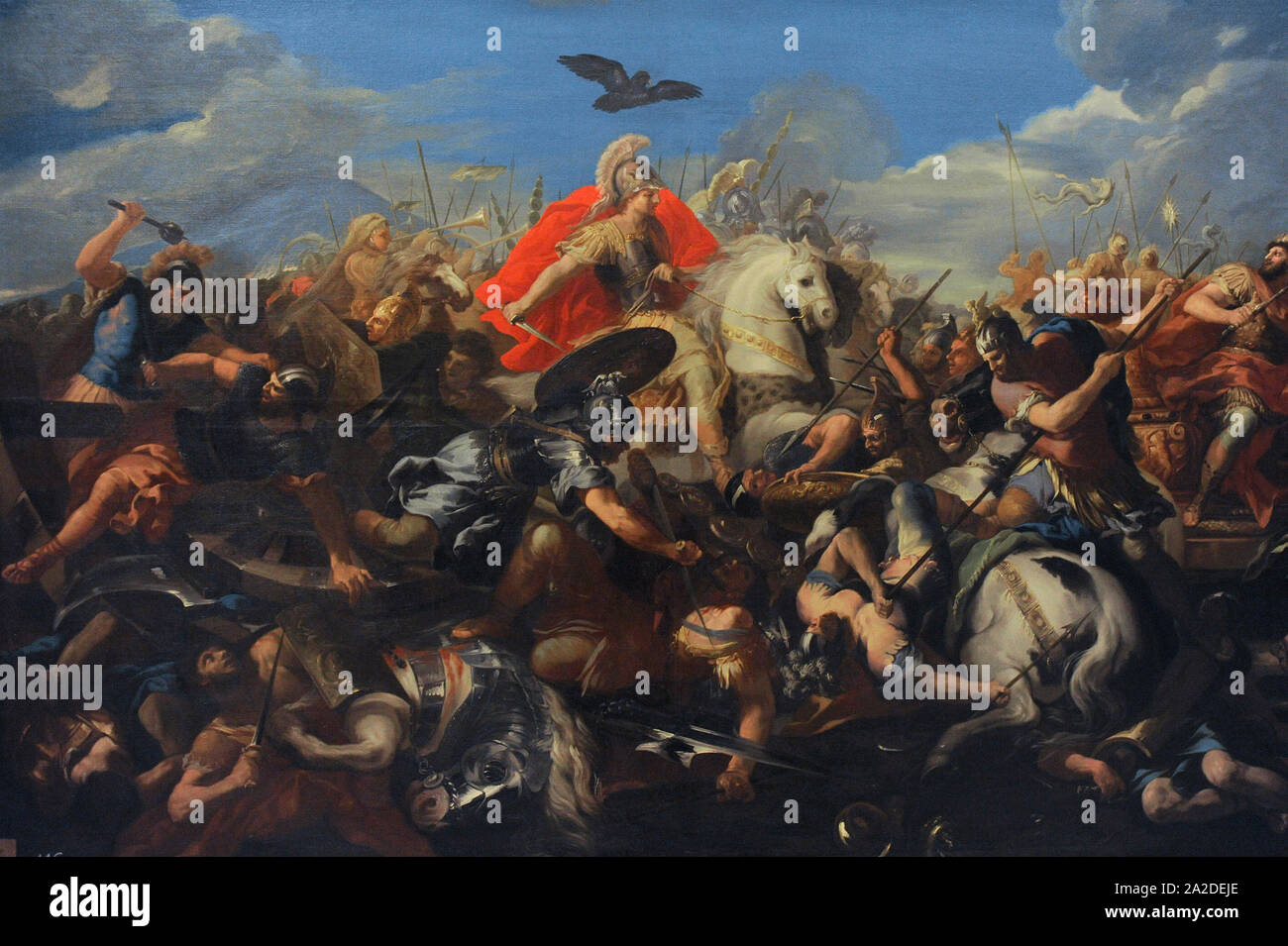 Battle of Arbelas or Battle of Gaugamela (331 BC). Combat between Alexander the Great and the Persian King Darius III. Painting by Jose del Castillo (1737-1793). San Fernando Royal Academy of Fine Arts. Madrid. Spain. Stock Photohttps://www.alamy.com/image-license-details/?v=1https://www.alamy.com/battle-of-arbelas-or-battle-of-gaugamela-331-bc-combat-between-alexander-the-great-and-the-persian-king-darius-iii-painting-by-jose-del-castillo-1737-1793-san-fernando-royal-academy-of-fine-arts-madrid-spain-image328523174.html
Battle of Arbelas or Battle of Gaugamela (331 BC). Combat between Alexander the Great and the Persian King Darius III. Painting by Jose del Castillo (1737-1793). San Fernando Royal Academy of Fine Arts. Madrid. Spain. Stock Photohttps://www.alamy.com/image-license-details/?v=1https://www.alamy.com/battle-of-arbelas-or-battle-of-gaugamela-331-bc-combat-between-alexander-the-great-and-the-persian-king-darius-iii-painting-by-jose-del-castillo-1737-1793-san-fernando-royal-academy-of-fine-arts-madrid-spain-image328523174.htmlRM2A2DEJE–Battle of Arbelas or Battle of Gaugamela (331 BC). Combat between Alexander the Great and the Persian King Darius III. Painting by Jose del Castillo (1737-1793). San Fernando Royal Academy of Fine Arts. Madrid. Spain.
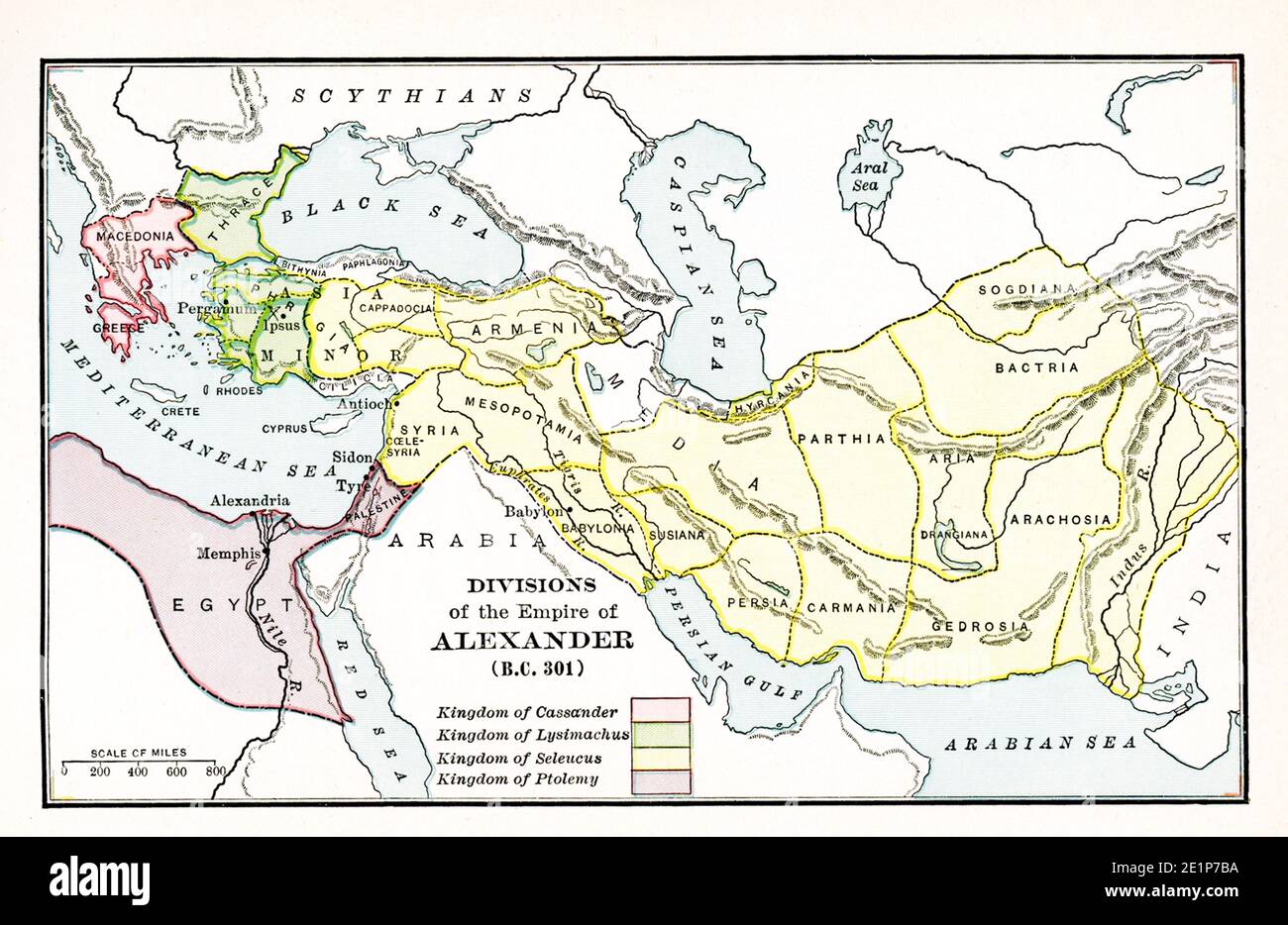 Map of the Divisions of the Empire of Alexander in BC 301. The legend reads: Pink: Kingdom of Cassander; Green: Kingdom of Lysimachus; Yellow: Kingdom of Seleucus; Purple: Kingdom of Ptolemy. Alexander the Great fell ill in Babylon on his return to Greece and Macedonia. The year was 323 B.C. This map shows the divisions of Alexander’s empire among the diadochoi (successors) at the time of his death. Stock Photohttps://www.alamy.com/image-license-details/?v=1https://www.alamy.com/map-of-the-divisions-of-the-empire-of-alexander-in-bc-301-the-legend-reads-pink-kingdom-of-cassander-green-kingdom-of-lysimachus-yellow-kingdom-of-seleucus-purple-kingdom-of-ptolemy-alexander-the-great-fell-ill-in-babylon-on-his-return-to-greece-and-macedonia-the-year-was-323-bc-this-map-shows-the-divisions-of-alexanders-empire-among-the-diadochoi-successors-at-the-time-of-his-death-image396941870.html
Map of the Divisions of the Empire of Alexander in BC 301. The legend reads: Pink: Kingdom of Cassander; Green: Kingdom of Lysimachus; Yellow: Kingdom of Seleucus; Purple: Kingdom of Ptolemy. Alexander the Great fell ill in Babylon on his return to Greece and Macedonia. The year was 323 B.C. This map shows the divisions of Alexander’s empire among the diadochoi (successors) at the time of his death. Stock Photohttps://www.alamy.com/image-license-details/?v=1https://www.alamy.com/map-of-the-divisions-of-the-empire-of-alexander-in-bc-301-the-legend-reads-pink-kingdom-of-cassander-green-kingdom-of-lysimachus-yellow-kingdom-of-seleucus-purple-kingdom-of-ptolemy-alexander-the-great-fell-ill-in-babylon-on-his-return-to-greece-and-macedonia-the-year-was-323-bc-this-map-shows-the-divisions-of-alexanders-empire-among-the-diadochoi-successors-at-the-time-of-his-death-image396941870.htmlRF2E1P7BA–Map of the Divisions of the Empire of Alexander in BC 301. The legend reads: Pink: Kingdom of Cassander; Green: Kingdom of Lysimachus; Yellow: Kingdom of Seleucus; Purple: Kingdom of Ptolemy. Alexander the Great fell ill in Babylon on his return to Greece and Macedonia. The year was 323 B.C. This map shows the divisions of Alexander’s empire among the diadochoi (successors) at the time of his death.
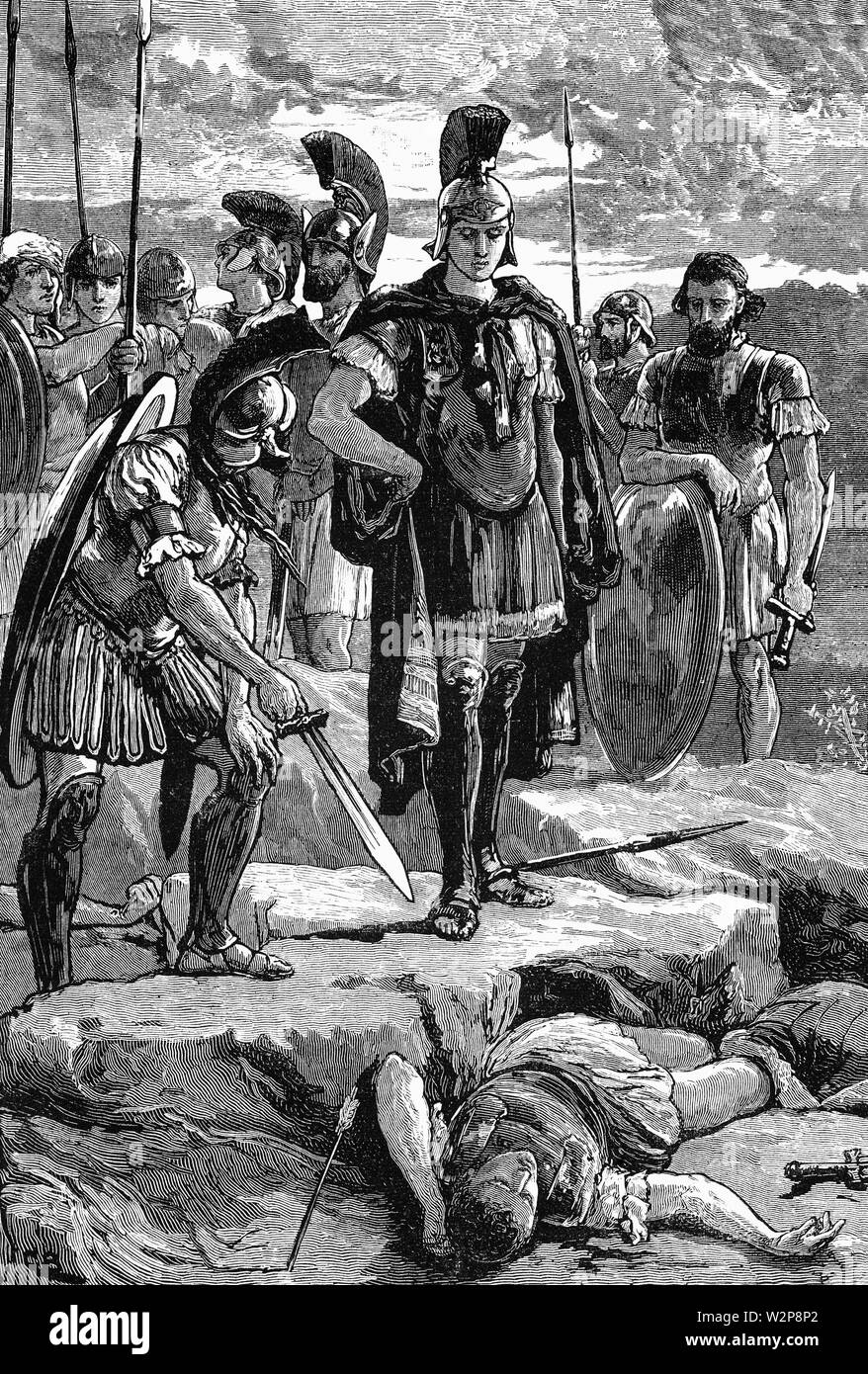 In the early Summer of 330, Alexander hunted down the Persian king Darius III Codomannus in the desert east of modern Tehran (ancient Rhagae). It appears that when the first Macedonian horsemen appeared, the Persian courtiers decided to kill their own king rather than allow him to be captured. When Alexander was close upon them, two courtiers, Nabarzanes and Barsaentes, struck him down, left him, and made their escape. The wound proved fatal, and Darius died shortly afterwards, before Alexander could see him. Stock Photohttps://www.alamy.com/image-license-details/?v=1https://www.alamy.com/in-the-early-summer-of-330-alexander-hunted-down-the-persian-king-darius-iii-codomannus-in-the-desert-east-of-modern-tehran-ancient-rhagae-it-appears-that-when-the-first-macedonian-horsemen-appeared-the-persian-courtiers-decided-to-kill-their-own-king-rather-than-allow-him-to-be-captured-when-alexander-was-close-upon-them-two-courtiers-nabarzanes-and-barsaentes-struck-him-down-left-him-and-made-their-escape-the-wound-proved-fatal-and-darius-died-shortly-afterwards-before-alexander-could-see-him-image259874666.html
In the early Summer of 330, Alexander hunted down the Persian king Darius III Codomannus in the desert east of modern Tehran (ancient Rhagae). It appears that when the first Macedonian horsemen appeared, the Persian courtiers decided to kill their own king rather than allow him to be captured. When Alexander was close upon them, two courtiers, Nabarzanes and Barsaentes, struck him down, left him, and made their escape. The wound proved fatal, and Darius died shortly afterwards, before Alexander could see him. Stock Photohttps://www.alamy.com/image-license-details/?v=1https://www.alamy.com/in-the-early-summer-of-330-alexander-hunted-down-the-persian-king-darius-iii-codomannus-in-the-desert-east-of-modern-tehran-ancient-rhagae-it-appears-that-when-the-first-macedonian-horsemen-appeared-the-persian-courtiers-decided-to-kill-their-own-king-rather-than-allow-him-to-be-captured-when-alexander-was-close-upon-them-two-courtiers-nabarzanes-and-barsaentes-struck-him-down-left-him-and-made-their-escape-the-wound-proved-fatal-and-darius-died-shortly-afterwards-before-alexander-could-see-him-image259874666.htmlRMW2P8P2–In the early Summer of 330, Alexander hunted down the Persian king Darius III Codomannus in the desert east of modern Tehran (ancient Rhagae). It appears that when the first Macedonian horsemen appeared, the Persian courtiers decided to kill their own king rather than allow him to be captured. When Alexander was close upon them, two courtiers, Nabarzanes and Barsaentes, struck him down, left him, and made their escape. The wound proved fatal, and Darius died shortly afterwards, before Alexander could see him.
 Comic History of Greece from the earliest times to the death of Alexander the Great ... Illustrated, etc Image taken from page 357 of 'Comic History of Greece Stock Photohttps://www.alamy.com/image-license-details/?v=1https://www.alamy.com/stock-photo-comic-history-of-greece-from-the-earliest-times-to-the-death-of-alexander-85969614.html
Comic History of Greece from the earliest times to the death of Alexander the Great ... Illustrated, etc Image taken from page 357 of 'Comic History of Greece Stock Photohttps://www.alamy.com/image-license-details/?v=1https://www.alamy.com/stock-photo-comic-history-of-greece-from-the-earliest-times-to-the-death-of-alexander-85969614.htmlRMEYT73A–Comic History of Greece from the earliest times to the death of Alexander the Great ... Illustrated, etc Image taken from page 357 of 'Comic History of Greece
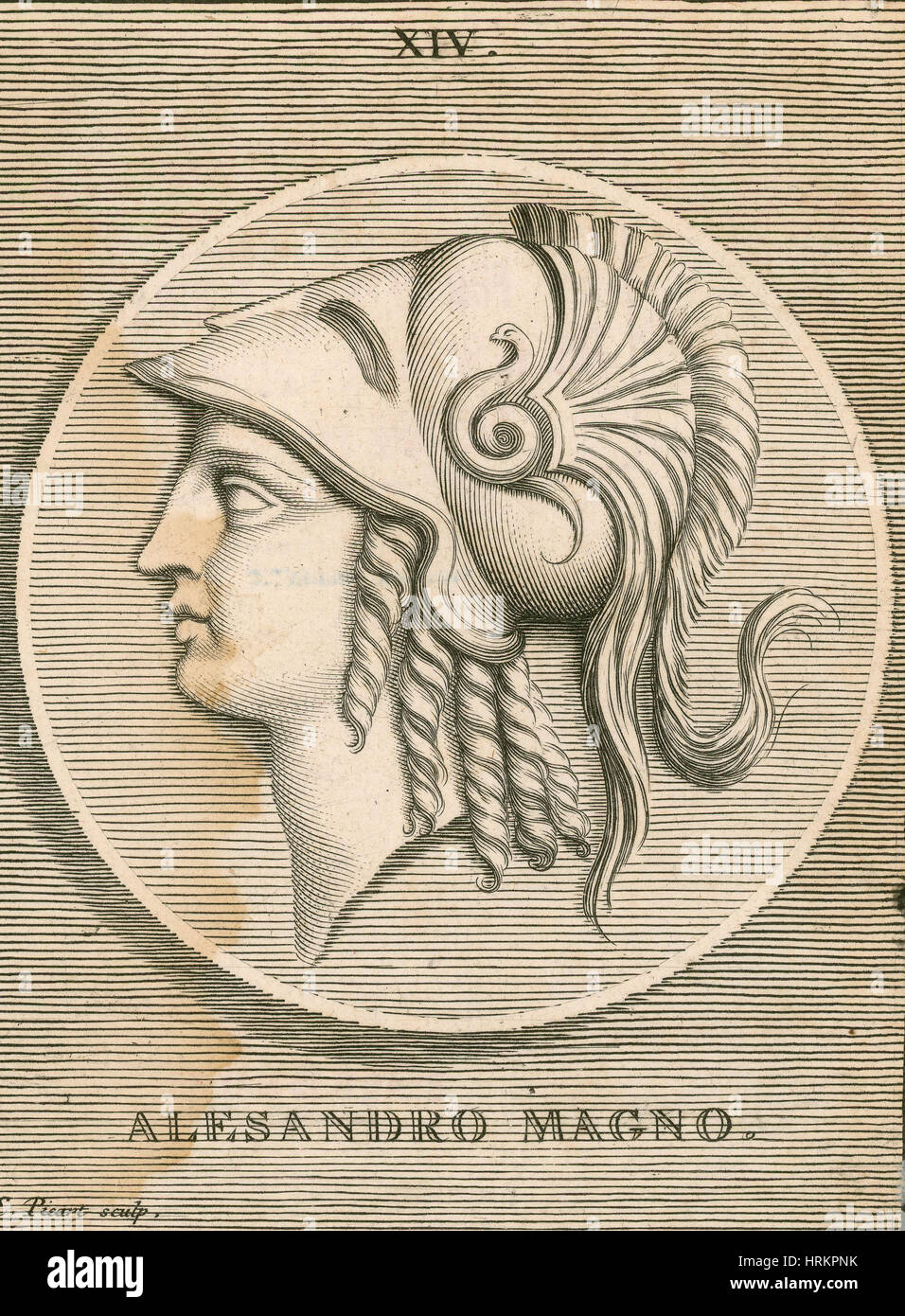 Alexander the Great, Greek King of Macedon Stock Photohttps://www.alamy.com/image-license-details/?v=1https://www.alamy.com/stock-photo-alexander-the-great-greek-king-of-macedon-135044607.html
Alexander the Great, Greek King of Macedon Stock Photohttps://www.alamy.com/image-license-details/?v=1https://www.alamy.com/stock-photo-alexander-the-great-greek-king-of-macedon-135044607.htmlRMHRKPNK–Alexander the Great, Greek King of Macedon
 The death of Darius's wife 1784-1785 Louis LAGRENÉE, says the Elder 1724 - 1805 ( After having defeated Darius, king of Persia (330 BC), Alexander the Great collects himself before the body of the wife of his enemy, who died in captivity. ) Stock Photohttps://www.alamy.com/image-license-details/?v=1https://www.alamy.com/the-death-of-dariuss-wife-1784-1785-louis-lagrene-says-the-elder-1724-1805-after-having-defeated-darius-king-of-persia-330-bc-alexander-the-great-collects-himself-before-the-body-of-the-wife-of-his-enemy-who-died-in-captivity-image257872344.html
The death of Darius's wife 1784-1785 Louis LAGRENÉE, says the Elder 1724 - 1805 ( After having defeated Darius, king of Persia (330 BC), Alexander the Great collects himself before the body of the wife of his enemy, who died in captivity. ) Stock Photohttps://www.alamy.com/image-license-details/?v=1https://www.alamy.com/the-death-of-dariuss-wife-1784-1785-louis-lagrene-says-the-elder-1724-1805-after-having-defeated-darius-king-of-persia-330-bc-alexander-the-great-collects-himself-before-the-body-of-the-wife-of-his-enemy-who-died-in-captivity-image257872344.htmlRMTYF2PG–The death of Darius's wife 1784-1785 Louis LAGRENÉE, says the Elder 1724 - 1805 ( After having defeated Darius, king of Persia (330 BC), Alexander the Great collects himself before the body of the wife of his enemy, who died in captivity. )
 Alexander The Great Dies Stock Photohttps://www.alamy.com/image-license-details/?v=1https://www.alamy.com/alexander-the-great-dies-image3176945.html
Alexander The Great Dies Stock Photohttps://www.alamy.com/image-license-details/?v=1https://www.alamy.com/alexander-the-great-dies-image3176945.htmlRMAYK9F2–Alexander The Great Dies
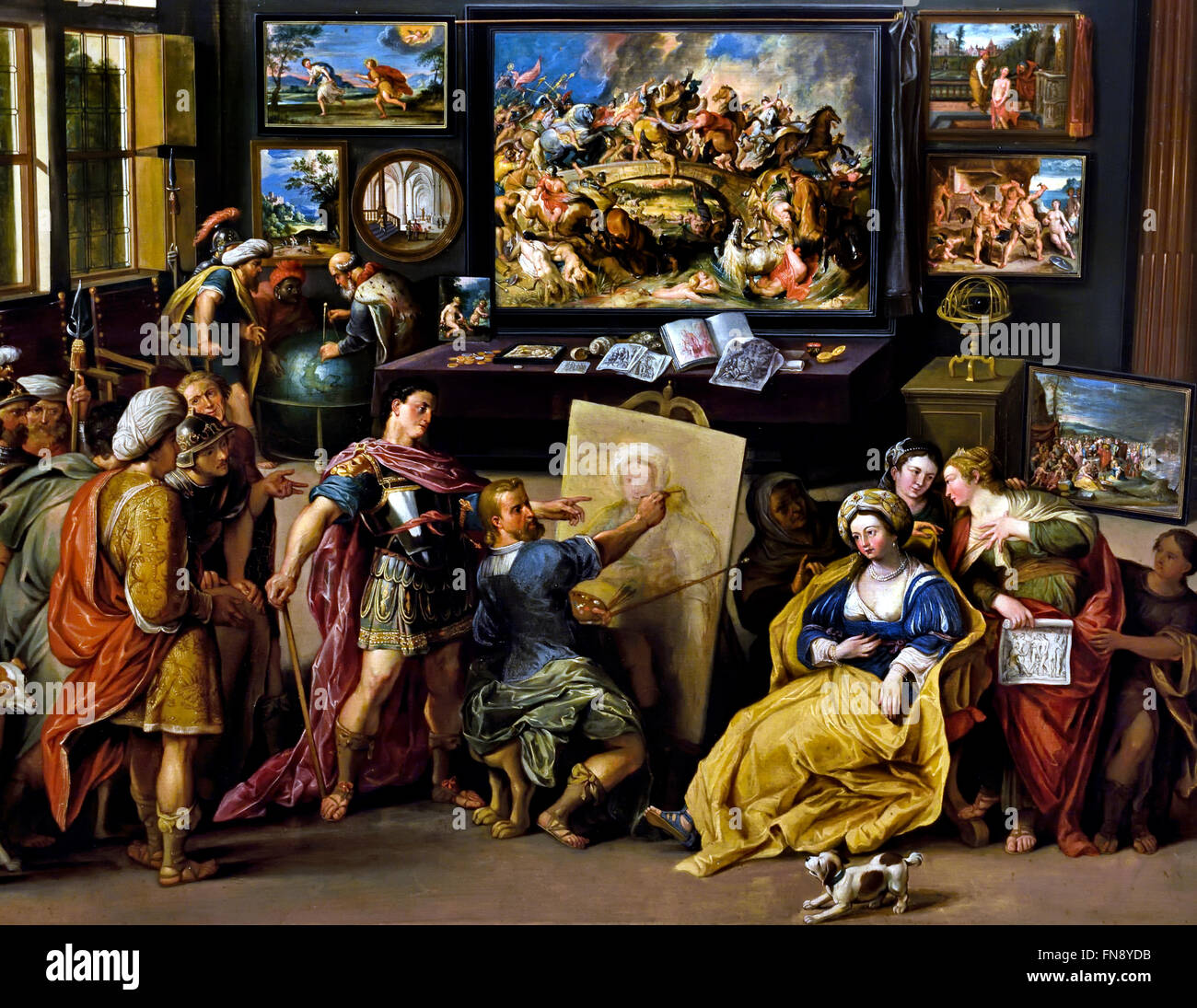 Apelles Painting Campaspe 1630 by Willem van Haecht 1593-1637 Dutch Netherlands Alexander the Great visits the studio of Apelles ( Alexander I was Emperor of Russia from 1801, the first King of Congress Poland from 1815, and the Grand Duke of Finland from 1809 to his death. ) Stock Photohttps://www.alamy.com/image-license-details/?v=1https://www.alamy.com/stock-photo-apelles-painting-campaspe-1630-by-willem-van-haecht-1593-1637-dutch-99156775.html
Apelles Painting Campaspe 1630 by Willem van Haecht 1593-1637 Dutch Netherlands Alexander the Great visits the studio of Apelles ( Alexander I was Emperor of Russia from 1801, the first King of Congress Poland from 1815, and the Grand Duke of Finland from 1809 to his death. ) Stock Photohttps://www.alamy.com/image-license-details/?v=1https://www.alamy.com/stock-photo-apelles-painting-campaspe-1630-by-willem-van-haecht-1593-1637-dutch-99156775.htmlRMFN8YDB–Apelles Painting Campaspe 1630 by Willem van Haecht 1593-1637 Dutch Netherlands Alexander the Great visits the studio of Apelles ( Alexander I was Emperor of Russia from 1801, the first King of Congress Poland from 1815, and the Grand Duke of Finland from 1809 to his death. )
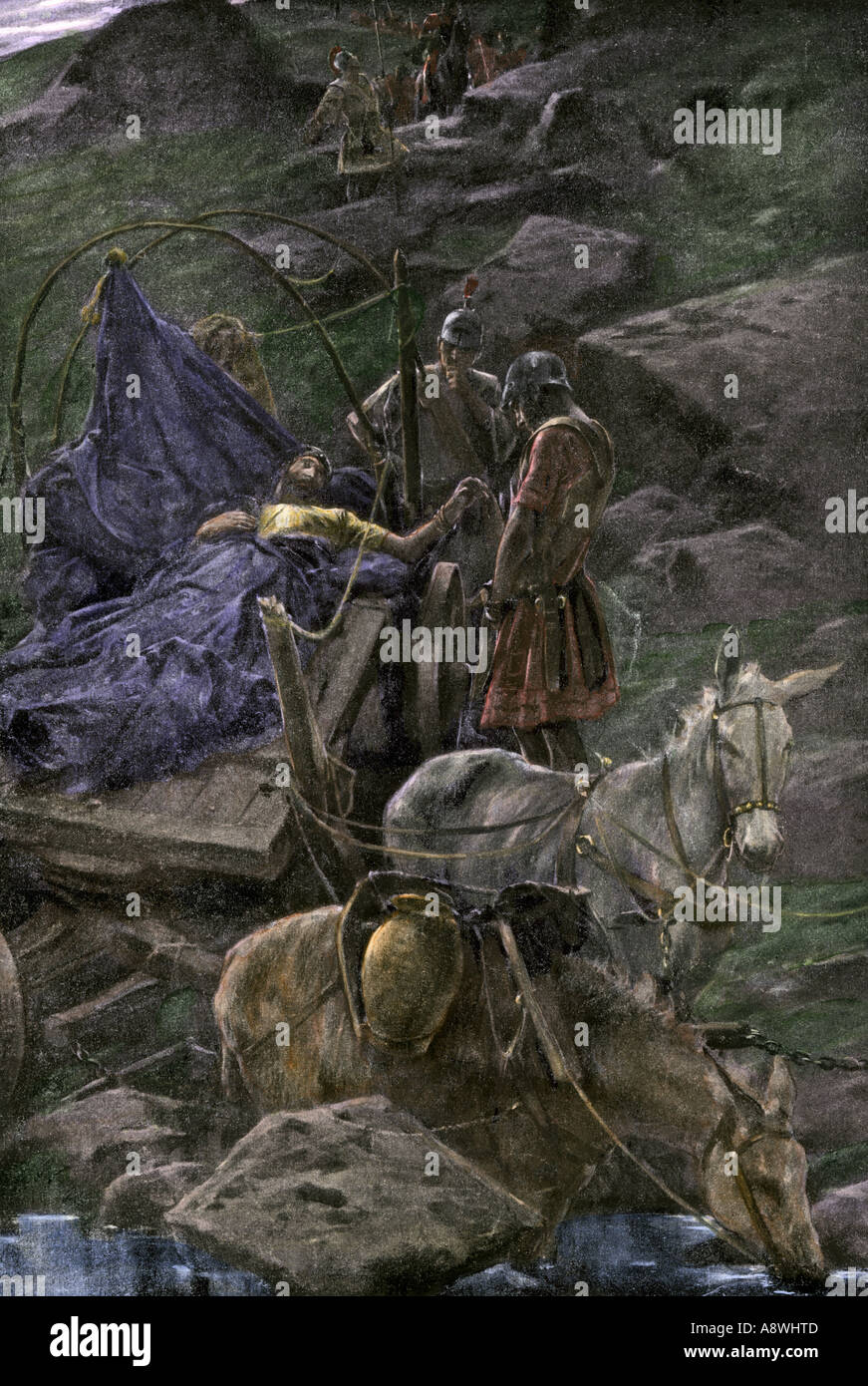 Alexander the Great meeting the dying Persian king Darius III who had been murdered by Bessus 330 BC. Hand-colored halftone of an illustration Stock Photohttps://www.alamy.com/image-license-details/?v=1https://www.alamy.com/alexander-the-great-meeting-the-dying-persian-king-darius-iii-who-image6961740.html
Alexander the Great meeting the dying Persian king Darius III who had been murdered by Bessus 330 BC. Hand-colored halftone of an illustration Stock Photohttps://www.alamy.com/image-license-details/?v=1https://www.alamy.com/alexander-the-great-meeting-the-dying-persian-king-darius-iii-who-image6961740.htmlRMA8WHTD–Alexander the Great meeting the dying Persian king Darius III who had been murdered by Bessus 330 BC. Hand-colored halftone of an illustration
 Image from page 309 of 'Comic History of Greece from the earliest times to the death of Alexander the Great . Illustrated, etc' . Stock Photohttps://www.alamy.com/image-license-details/?v=1https://www.alamy.com/image-from-page-309-of-comic-history-of-greece-from-the-earliest-times-to-the-death-of-alexander-the-great-illustrated-etc-image217052088.html
Image from page 309 of 'Comic History of Greece from the earliest times to the death of Alexander the Great . Illustrated, etc' . Stock Photohttps://www.alamy.com/image-license-details/?v=1https://www.alamy.com/image-from-page-309-of-comic-history-of-greece-from-the-earliest-times-to-the-death-of-alexander-the-great-illustrated-etc-image217052088.htmlRMPH3G48–Image from page 309 of 'Comic History of Greece from the earliest times to the death of Alexander the Great . Illustrated, etc' .
![The 1906 caption reads: “DEATH OF PAUL I.—Paul I., Czar of Russia in Napoleon's early days of triumph, was half insane, and so wavering in his attitude toward France that his subjects were in despair. The leading men of the empire went one night to his bedroom to persuade him to abdicate in favor of his son Alexander. Just what happened at that interview the public may never know; but Paul became violent, there was a struggle, the lights went out, and when they were relit the Czar lay upon the floor strangled to death [1801].” Stock Photo The 1906 caption reads: “DEATH OF PAUL I.—Paul I., Czar of Russia in Napoleon's early days of triumph, was half insane, and so wavering in his attitude toward France that his subjects were in despair. The leading men of the empire went one night to his bedroom to persuade him to abdicate in favor of his son Alexander. Just what happened at that interview the public may never know; but Paul became violent, there was a struggle, the lights went out, and when they were relit the Czar lay upon the floor strangled to death [1801].” Stock Photo](https://c8.alamy.com/comp/2JJ0NGN/the-1906-caption-reads-death-of-paul-ipaul-i-czar-of-russia-in-napoleons-early-days-of-triumph-was-half-insane-and-so-wavering-in-his-attitude-toward-france-that-his-subjects-were-in-despair-the-leading-men-of-the-empire-went-one-night-to-his-bedroom-to-persuade-him-to-abdicate-in-favor-of-his-son-alexander-just-what-happened-at-that-interview-the-public-may-never-know-but-paul-became-violent-there-was-a-struggle-the-lights-went-out-and-when-they-were-relit-the-czar-lay-upon-the-floor-strangled-to-death-1801-2JJ0NGN.jpg) The 1906 caption reads: “DEATH OF PAUL I.—Paul I., Czar of Russia in Napoleon's early days of triumph, was half insane, and so wavering in his attitude toward France that his subjects were in despair. The leading men of the empire went one night to his bedroom to persuade him to abdicate in favor of his son Alexander. Just what happened at that interview the public may never know; but Paul became violent, there was a struggle, the lights went out, and when they were relit the Czar lay upon the floor strangled to death [1801].” Stock Photohttps://www.alamy.com/image-license-details/?v=1https://www.alamy.com/the-1906-caption-reads-death-of-paul-ipaul-i-czar-of-russia-in-napoleons-early-days-of-triumph-was-half-insane-and-so-wavering-in-his-attitude-toward-france-that-his-subjects-were-in-despair-the-leading-men-of-the-empire-went-one-night-to-his-bedroom-to-persuade-him-to-abdicate-in-favor-of-his-son-alexander-just-what-happened-at-that-interview-the-public-may-never-know-but-paul-became-violent-there-was-a-struggle-the-lights-went-out-and-when-they-were-relit-the-czar-lay-upon-the-floor-strangled-to-death-1801-image475760677.html
The 1906 caption reads: “DEATH OF PAUL I.—Paul I., Czar of Russia in Napoleon's early days of triumph, was half insane, and so wavering in his attitude toward France that his subjects were in despair. The leading men of the empire went one night to his bedroom to persuade him to abdicate in favor of his son Alexander. Just what happened at that interview the public may never know; but Paul became violent, there was a struggle, the lights went out, and when they were relit the Czar lay upon the floor strangled to death [1801].” Stock Photohttps://www.alamy.com/image-license-details/?v=1https://www.alamy.com/the-1906-caption-reads-death-of-paul-ipaul-i-czar-of-russia-in-napoleons-early-days-of-triumph-was-half-insane-and-so-wavering-in-his-attitude-toward-france-that-his-subjects-were-in-despair-the-leading-men-of-the-empire-went-one-night-to-his-bedroom-to-persuade-him-to-abdicate-in-favor-of-his-son-alexander-just-what-happened-at-that-interview-the-public-may-never-know-but-paul-became-violent-there-was-a-struggle-the-lights-went-out-and-when-they-were-relit-the-czar-lay-upon-the-floor-strangled-to-death-1801-image475760677.htmlRF2JJ0NGN–The 1906 caption reads: “DEATH OF PAUL I.—Paul I., Czar of Russia in Napoleon's early days of triumph, was half insane, and so wavering in his attitude toward France that his subjects were in despair. The leading men of the empire went one night to his bedroom to persuade him to abdicate in favor of his son Alexander. Just what happened at that interview the public may never know; but Paul became violent, there was a struggle, the lights went out, and when they were relit the Czar lay upon the floor strangled to death [1801].”
 Illuminated Manuscript, Five poems (quintet), A man tells Alexander the Great a story of a country in which there is no death, This illuminated and illustrated Safavid copy of the Khamsah (quintet) of Niẓāmī Ganjavī (d. 605 AH / 1209 CE) dates to the eleventh century AH / seventeenth CE. The codex opens with a double-page illuminated frontispiece. Each of the five poems begins with an illuminated headpiece, and there are thirty-six illustrations. The lacquer binding is not original to the manuscript Stock Photohttps://www.alamy.com/image-license-details/?v=1https://www.alamy.com/illuminated-manuscript-five-poems-quintet-a-man-tells-alexander-the-great-a-story-of-a-country-in-which-there-is-no-death-this-illuminated-and-illustrated-safavid-copy-of-the-khamsah-quintet-of-nim-ganjav-d-605-ah-1209-ce-dates-to-the-eleventh-century-ah-seventeenth-ce-the-codex-opens-with-a-double-page-illuminated-frontispiece-each-of-the-five-poems-begins-with-an-illuminated-headpiece-and-there-are-thirty-six-illustrations-the-lacquer-binding-is-not-original-to-the-manuscript-image573474147.html
Illuminated Manuscript, Five poems (quintet), A man tells Alexander the Great a story of a country in which there is no death, This illuminated and illustrated Safavid copy of the Khamsah (quintet) of Niẓāmī Ganjavī (d. 605 AH / 1209 CE) dates to the eleventh century AH / seventeenth CE. The codex opens with a double-page illuminated frontispiece. Each of the five poems begins with an illuminated headpiece, and there are thirty-six illustrations. The lacquer binding is not original to the manuscript Stock Photohttps://www.alamy.com/image-license-details/?v=1https://www.alamy.com/illuminated-manuscript-five-poems-quintet-a-man-tells-alexander-the-great-a-story-of-a-country-in-which-there-is-no-death-this-illuminated-and-illustrated-safavid-copy-of-the-khamsah-quintet-of-nim-ganjav-d-605-ah-1209-ce-dates-to-the-eleventh-century-ah-seventeenth-ce-the-codex-opens-with-a-double-page-illuminated-frontispiece-each-of-the-five-poems-begins-with-an-illuminated-headpiece-and-there-are-thirty-six-illustrations-the-lacquer-binding-is-not-original-to-the-manuscript-image573474147.htmlRM2T9003F–Illuminated Manuscript, Five poems (quintet), A man tells Alexander the Great a story of a country in which there is no death, This illuminated and illustrated Safavid copy of the Khamsah (quintet) of Niẓāmī Ganjavī (d. 605 AH / 1209 CE) dates to the eleventh century AH / seventeenth CE. The codex opens with a double-page illuminated frontispiece. Each of the five poems begins with an illuminated headpiece, and there are thirty-six illustrations. The lacquer binding is not original to the manuscript
 Inspired by Sarcophagus of Alexander, Gelatin silver photograph, ca. 1860-1880, Ottoman, sheet: height: 12 in., Alexander the Great, Ancient Greece, burial, death, mortality, resting place, tomb, Reimagined by Artotop. Classic art reinvented with a modern twist. Design of warm cheerful glowing of brightness and light ray radiance. Photography inspired by surrealism and futurism, embracing dynamic energy of modern technology, movement, speed and revolutionize culture Stock Photohttps://www.alamy.com/image-license-details/?v=1https://www.alamy.com/inspired-by-sarcophagus-of-alexander-gelatin-silver-photograph-ca-1860-1880-ottoman-sheet-height-12-in-alexander-the-great-ancient-greece-burial-death-mortality-resting-place-tomb-reimagined-by-artotop-classic-art-reinvented-with-a-modern-twist-design-of-warm-cheerful-glowing-of-brightness-and-light-ray-radiance-photography-inspired-by-surrealism-and-futurism-embracing-dynamic-energy-of-modern-technology-movement-speed-and-revolutionize-culture-image459246184.html
Inspired by Sarcophagus of Alexander, Gelatin silver photograph, ca. 1860-1880, Ottoman, sheet: height: 12 in., Alexander the Great, Ancient Greece, burial, death, mortality, resting place, tomb, Reimagined by Artotop. Classic art reinvented with a modern twist. Design of warm cheerful glowing of brightness and light ray radiance. Photography inspired by surrealism and futurism, embracing dynamic energy of modern technology, movement, speed and revolutionize culture Stock Photohttps://www.alamy.com/image-license-details/?v=1https://www.alamy.com/inspired-by-sarcophagus-of-alexander-gelatin-silver-photograph-ca-1860-1880-ottoman-sheet-height-12-in-alexander-the-great-ancient-greece-burial-death-mortality-resting-place-tomb-reimagined-by-artotop-classic-art-reinvented-with-a-modern-twist-design-of-warm-cheerful-glowing-of-brightness-and-light-ray-radiance-photography-inspired-by-surrealism-and-futurism-embracing-dynamic-energy-of-modern-technology-movement-speed-and-revolutionize-culture-image459246184.htmlRF2HK4D5C–Inspired by Sarcophagus of Alexander, Gelatin silver photograph, ca. 1860-1880, Ottoman, sheet: height: 12 in., Alexander the Great, Ancient Greece, burial, death, mortality, resting place, tomb, Reimagined by Artotop. Classic art reinvented with a modern twist. Design of warm cheerful glowing of brightness and light ray radiance. Photography inspired by surrealism and futurism, embracing dynamic energy of modern technology, movement, speed and revolutionize culture
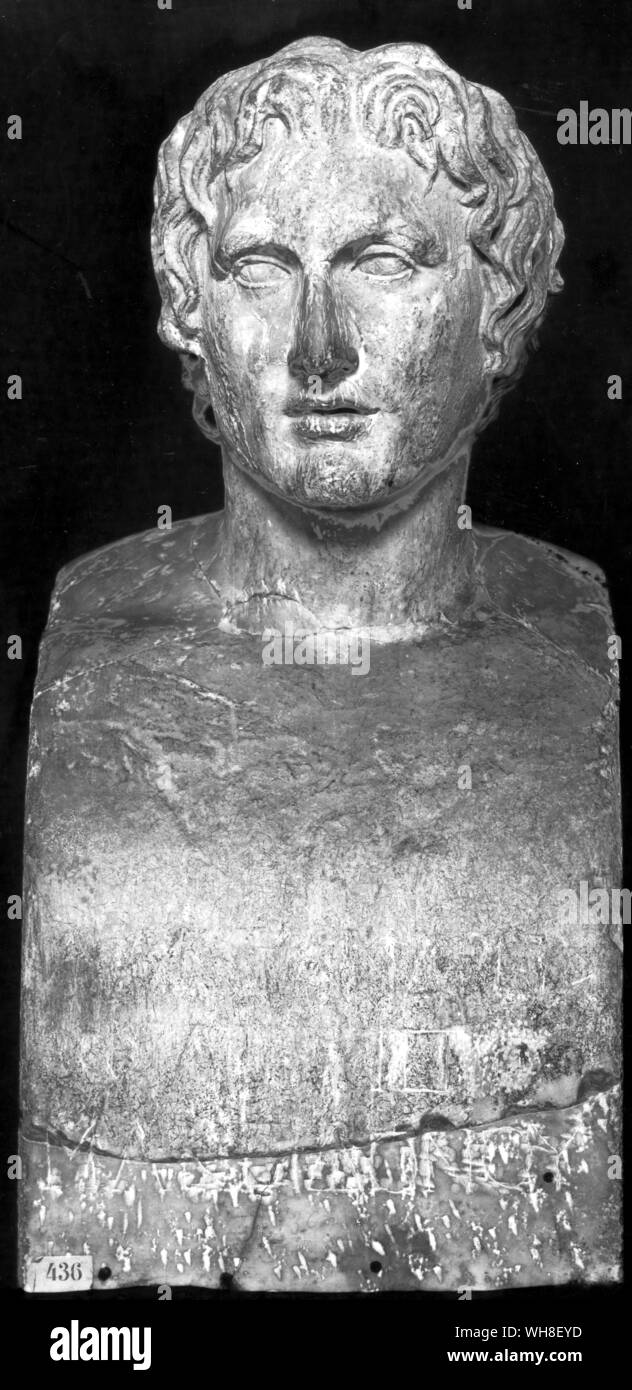 Alexander the Great (356 BC-323 BC), King of Macedon 336-323 BC, Azara Head. Considered one of the most successful military commanders in world history, conquering most of the known world before his death. The Nature of Alexander, by Mary Renault. Stock Photohttps://www.alamy.com/image-license-details/?v=1https://www.alamy.com/alexander-the-great-356-bc-323-bc-king-of-macedon-336-323-bc-azara-head-considered-one-of-the-most-successful-military-commanders-in-world-history-conquering-most-of-the-known-world-before-his-death-the-nature-of-alexander-by-mary-renault-image268792033.html
Alexander the Great (356 BC-323 BC), King of Macedon 336-323 BC, Azara Head. Considered one of the most successful military commanders in world history, conquering most of the known world before his death. The Nature of Alexander, by Mary Renault. Stock Photohttps://www.alamy.com/image-license-details/?v=1https://www.alamy.com/alexander-the-great-356-bc-323-bc-king-of-macedon-336-323-bc-azara-head-considered-one-of-the-most-successful-military-commanders-in-world-history-conquering-most-of-the-known-world-before-his-death-the-nature-of-alexander-by-mary-renault-image268792033.htmlRMWH8EYD–Alexander the Great (356 BC-323 BC), King of Macedon 336-323 BC, Azara Head. Considered one of the most successful military commanders in world history, conquering most of the known world before his death. The Nature of Alexander, by Mary Renault.
 Philip II of Macedon (382 BCE ? 336 BCE ) king (basileus) of Macedonia from 359 BCE until his death in 336 BCE . He was a member of the Argead dynasty, founders of the ancient kingdom, and the father of Alexander the Great. Philip II. 359 336 BCE . Gold Medallion of Tarsus Stock Photohttps://www.alamy.com/image-license-details/?v=1https://www.alamy.com/philip-ii-of-macedon-382-bce-336-bce-king-basileus-of-macedonia-from-359-bce-until-his-death-in-336-bce-he-was-a-member-of-the-argead-dynasty-founders-of-the-ancient-kingdom-and-the-father-of-alexander-the-great-philip-ii-359-336-bce-gold-medallion-of-tarsus-image634298819.html
Philip II of Macedon (382 BCE ? 336 BCE ) king (basileus) of Macedonia from 359 BCE until his death in 336 BCE . He was a member of the Argead dynasty, founders of the ancient kingdom, and the father of Alexander the Great. Philip II. 359 336 BCE . Gold Medallion of Tarsus Stock Photohttps://www.alamy.com/image-license-details/?v=1https://www.alamy.com/philip-ii-of-macedon-382-bce-336-bce-king-basileus-of-macedonia-from-359-bce-until-his-death-in-336-bce-he-was-a-member-of-the-argead-dynasty-founders-of-the-ancient-kingdom-and-the-father-of-alexander-the-great-philip-ii-359-336-bce-gold-medallion-of-tarsus-image634298819.htmlRM2YRXPH7–Philip II of Macedon (382 BCE ? 336 BCE ) king (basileus) of Macedonia from 359 BCE until his death in 336 BCE . He was a member of the Argead dynasty, founders of the ancient kingdom, and the father of Alexander the Great. Philip II. 359 336 BCE . Gold Medallion of Tarsus
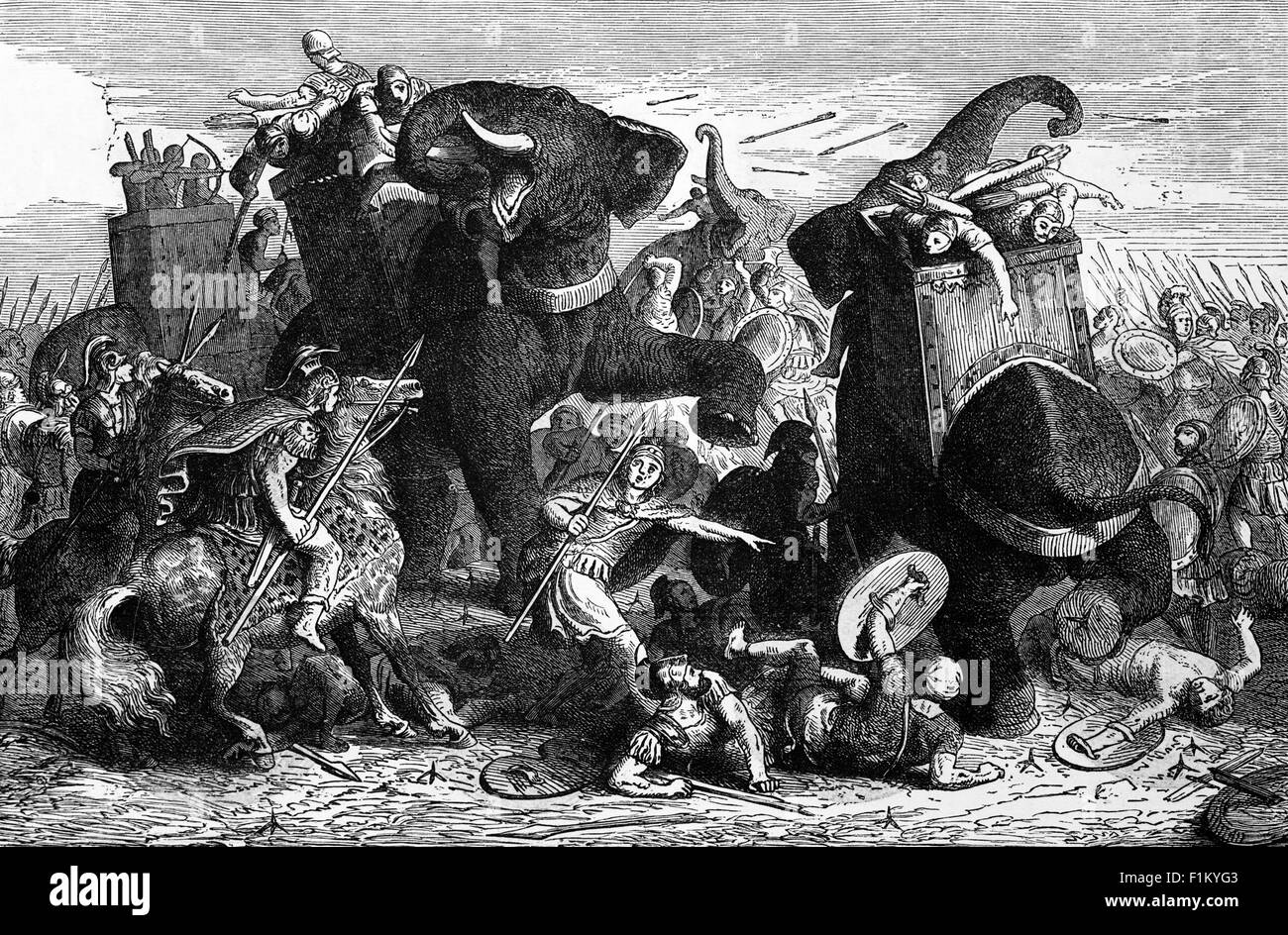 The Siege of Gaza of 332 BC, was a military event in the Egyptian campaign of Alexander the Great, who succeeded in reaching the walls by utilizing the engines he had employed against Tyre. After three unsuccessful assaults, the stronghold was taken by storm. The fortress controlled the main road that went from the Persian province of Syria to Egypt. Stock Photohttps://www.alamy.com/image-license-details/?v=1https://www.alamy.com/stock-photo-the-siege-of-gaza-of-332-bc-was-a-military-event-in-the-egyptian-campaign-87105203.html
The Siege of Gaza of 332 BC, was a military event in the Egyptian campaign of Alexander the Great, who succeeded in reaching the walls by utilizing the engines he had employed against Tyre. After three unsuccessful assaults, the stronghold was taken by storm. The fortress controlled the main road that went from the Persian province of Syria to Egypt. Stock Photohttps://www.alamy.com/image-license-details/?v=1https://www.alamy.com/stock-photo-the-siege-of-gaza-of-332-bc-was-a-military-event-in-the-egyptian-campaign-87105203.htmlRMF1KYG3–The Siege of Gaza of 332 BC, was a military event in the Egyptian campaign of Alexander the Great, who succeeded in reaching the walls by utilizing the engines he had employed against Tyre. After three unsuccessful assaults, the stronghold was taken by storm. The fortress controlled the main road that went from the Persian province of Syria to Egypt.
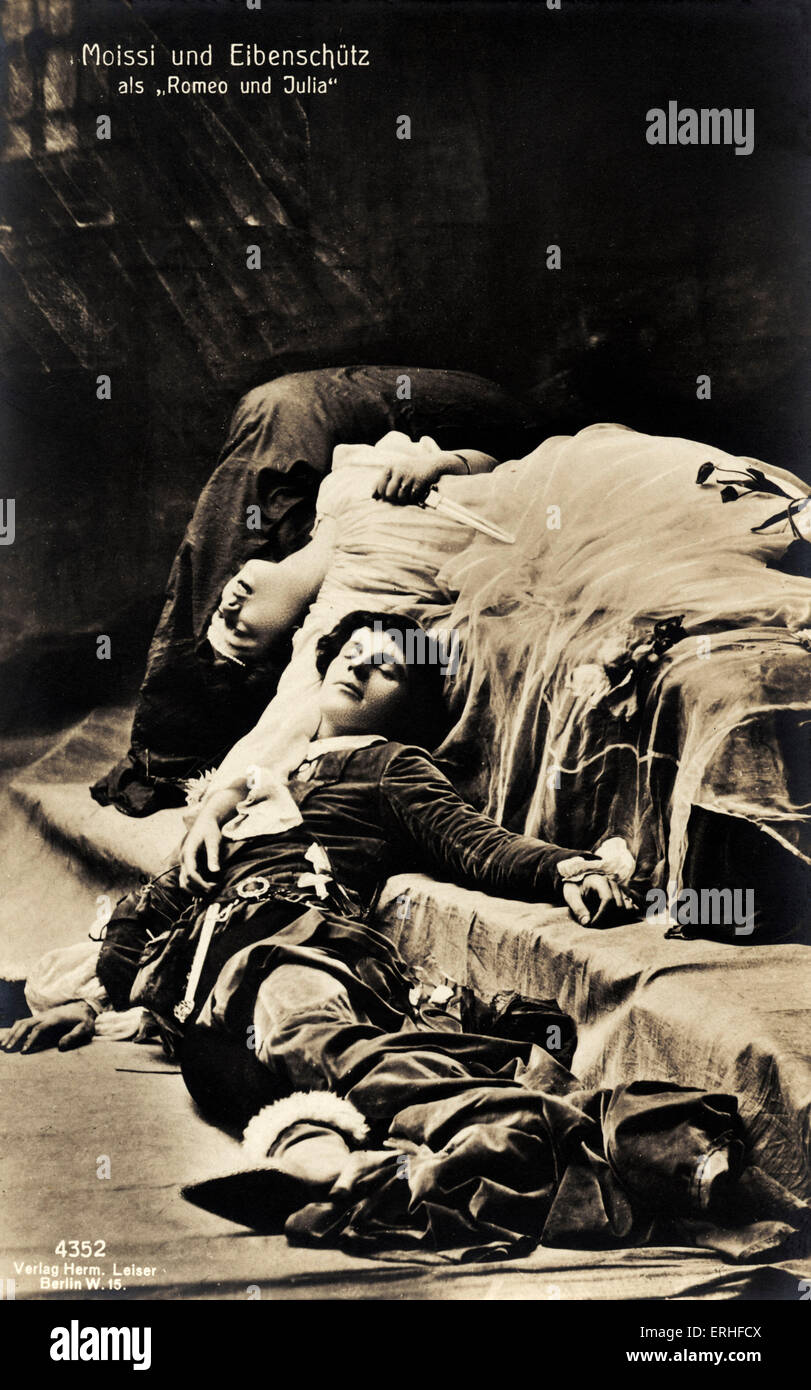 Alexander Moissi, with Eibenschutz as Romeo in Shakespeare play Romeo and Juliet. In death scene. Great Italian born German Stock Photohttps://www.alamy.com/image-license-details/?v=1https://www.alamy.com/stock-photo-alexander-moissi-with-eibenschutz-as-romeo-in-shakespeare-play-romeo-83363866.html
Alexander Moissi, with Eibenschutz as Romeo in Shakespeare play Romeo and Juliet. In death scene. Great Italian born German Stock Photohttps://www.alamy.com/image-license-details/?v=1https://www.alamy.com/stock-photo-alexander-moissi-with-eibenschutz-as-romeo-in-shakespeare-play-romeo-83363866.htmlRMERHFCX–Alexander Moissi, with Eibenschutz as Romeo in Shakespeare play Romeo and Juliet. In death scene. Great Italian born German
 Syria : aftery Death of Alexander the Great. Graduated margins oriented cities represented by small buildings according to their importance toponymy of the regions, some names of cities, mountains, lakes and rivers relieved by mountains of profile and shading hydrographic network shaded coasts shaded title framed on a costumbrista scene with Alexander the Great Digital copy. Madrid: Ministry of Culture Stock Photohttps://www.alamy.com/image-license-details/?v=1https://www.alamy.com/syria-aftery-death-of-alexander-the-great-graduated-margins-oriented-cities-represented-by-small-buildings-according-to-their-importance-toponymy-of-the-regions-some-names-of-cities-mountains-lakes-and-rivers-relieved-by-mountains-of-profile-and-shading-hydrographic-network-shaded-coasts-shaded-title-framed-on-a-costumbrista-scene-with-alexander-the-great-digital-copy-madrid-ministry-of-culture-image474618120.html
Syria : aftery Death of Alexander the Great. Graduated margins oriented cities represented by small buildings according to their importance toponymy of the regions, some names of cities, mountains, lakes and rivers relieved by mountains of profile and shading hydrographic network shaded coasts shaded title framed on a costumbrista scene with Alexander the Great Digital copy. Madrid: Ministry of Culture Stock Photohttps://www.alamy.com/image-license-details/?v=1https://www.alamy.com/syria-aftery-death-of-alexander-the-great-graduated-margins-oriented-cities-represented-by-small-buildings-according-to-their-importance-toponymy-of-the-regions-some-names-of-cities-mountains-lakes-and-rivers-relieved-by-mountains-of-profile-and-shading-hydrographic-network-shaded-coasts-shaded-title-framed-on-a-costumbrista-scene-with-alexander-the-great-digital-copy-madrid-ministry-of-culture-image474618120.htmlRM2JG4M74–Syria : aftery Death of Alexander the Great. Graduated margins oriented cities represented by small buildings according to their importance toponymy of the regions, some names of cities, mountains, lakes and rivers relieved by mountains of profile and shading hydrographic network shaded coasts shaded title framed on a costumbrista scene with Alexander the Great Digital copy. Madrid: Ministry of Culture
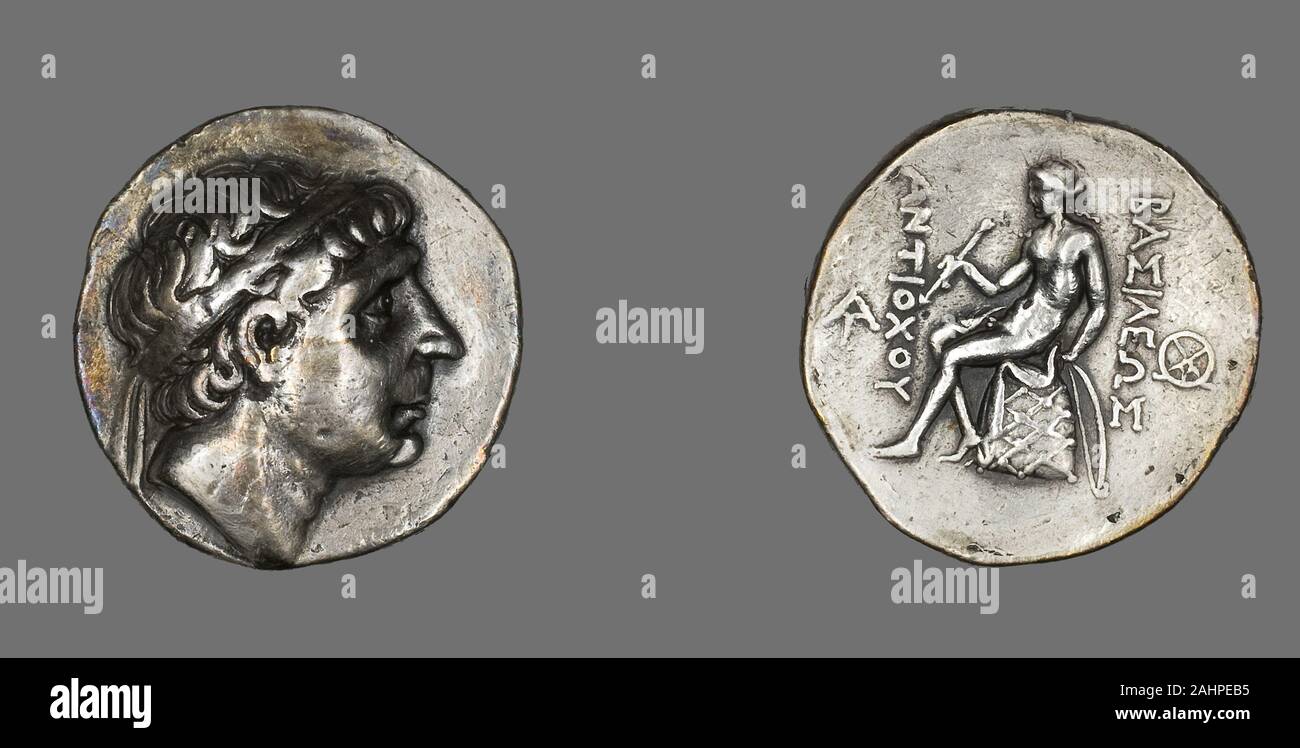 Ancient Greek. Tetradrachm (Coin) Portraying King Antiochus I Soter. 281 BC–261 BC. Ancient Near East. Silver Coinage of Hellenistic RulersThe Hellenistic period spans the nearly three hundred years between the death of Alexander the Great of Macedonia (323 B.C.) and that of Cleopatra VII of Egypt (30 B.C.), a descendant of one of Alexander’s generals. The term Hellenistic is derived from Hellas, an ancient Greek word for Greece. It is used to describe both chronologically and culturally the era following Alexander’s conquest of Egypt and Asia, which resulted in the spread of Greek culture acr Stock Photohttps://www.alamy.com/image-license-details/?v=1https://www.alamy.com/ancient-greek-tetradrachm-coin-portraying-king-antiochus-i-soter-281-bc261-bc-ancient-near-east-silver-coinage-of-hellenistic-rulersthe-hellenistic-period-spans-the-nearly-three-hundred-years-between-the-death-of-alexander-the-great-of-macedonia-323-bc-and-that-of-cleopatra-vii-of-egypt-30-bc-a-descendant-of-one-of-alexanders-generals-the-term-hellenistic-is-derived-from-hellas-an-ancient-greek-word-for-greece-it-is-used-to-describe-both-chronologically-and-culturally-the-era-following-alexanders-conquest-of-egypt-and-asia-which-resulted-in-the-spread-of-greek-culture-acr-image337940377.html
Ancient Greek. Tetradrachm (Coin) Portraying King Antiochus I Soter. 281 BC–261 BC. Ancient Near East. Silver Coinage of Hellenistic RulersThe Hellenistic period spans the nearly three hundred years between the death of Alexander the Great of Macedonia (323 B.C.) and that of Cleopatra VII of Egypt (30 B.C.), a descendant of one of Alexander’s generals. The term Hellenistic is derived from Hellas, an ancient Greek word for Greece. It is used to describe both chronologically and culturally the era following Alexander’s conquest of Egypt and Asia, which resulted in the spread of Greek culture acr Stock Photohttps://www.alamy.com/image-license-details/?v=1https://www.alamy.com/ancient-greek-tetradrachm-coin-portraying-king-antiochus-i-soter-281-bc261-bc-ancient-near-east-silver-coinage-of-hellenistic-rulersthe-hellenistic-period-spans-the-nearly-three-hundred-years-between-the-death-of-alexander-the-great-of-macedonia-323-bc-and-that-of-cleopatra-vii-of-egypt-30-bc-a-descendant-of-one-of-alexanders-generals-the-term-hellenistic-is-derived-from-hellas-an-ancient-greek-word-for-greece-it-is-used-to-describe-both-chronologically-and-culturally-the-era-following-alexanders-conquest-of-egypt-and-asia-which-resulted-in-the-spread-of-greek-culture-acr-image337940377.htmlRM2AHPEB5–Ancient Greek. Tetradrachm (Coin) Portraying King Antiochus I Soter. 281 BC–261 BC. Ancient Near East. Silver Coinage of Hellenistic RulersThe Hellenistic period spans the nearly three hundred years between the death of Alexander the Great of Macedonia (323 B.C.) and that of Cleopatra VII of Egypt (30 B.C.), a descendant of one of Alexander’s generals. The term Hellenistic is derived from Hellas, an ancient Greek word for Greece. It is used to describe both chronologically and culturally the era following Alexander’s conquest of Egypt and Asia, which resulted in the spread of Greek culture acr
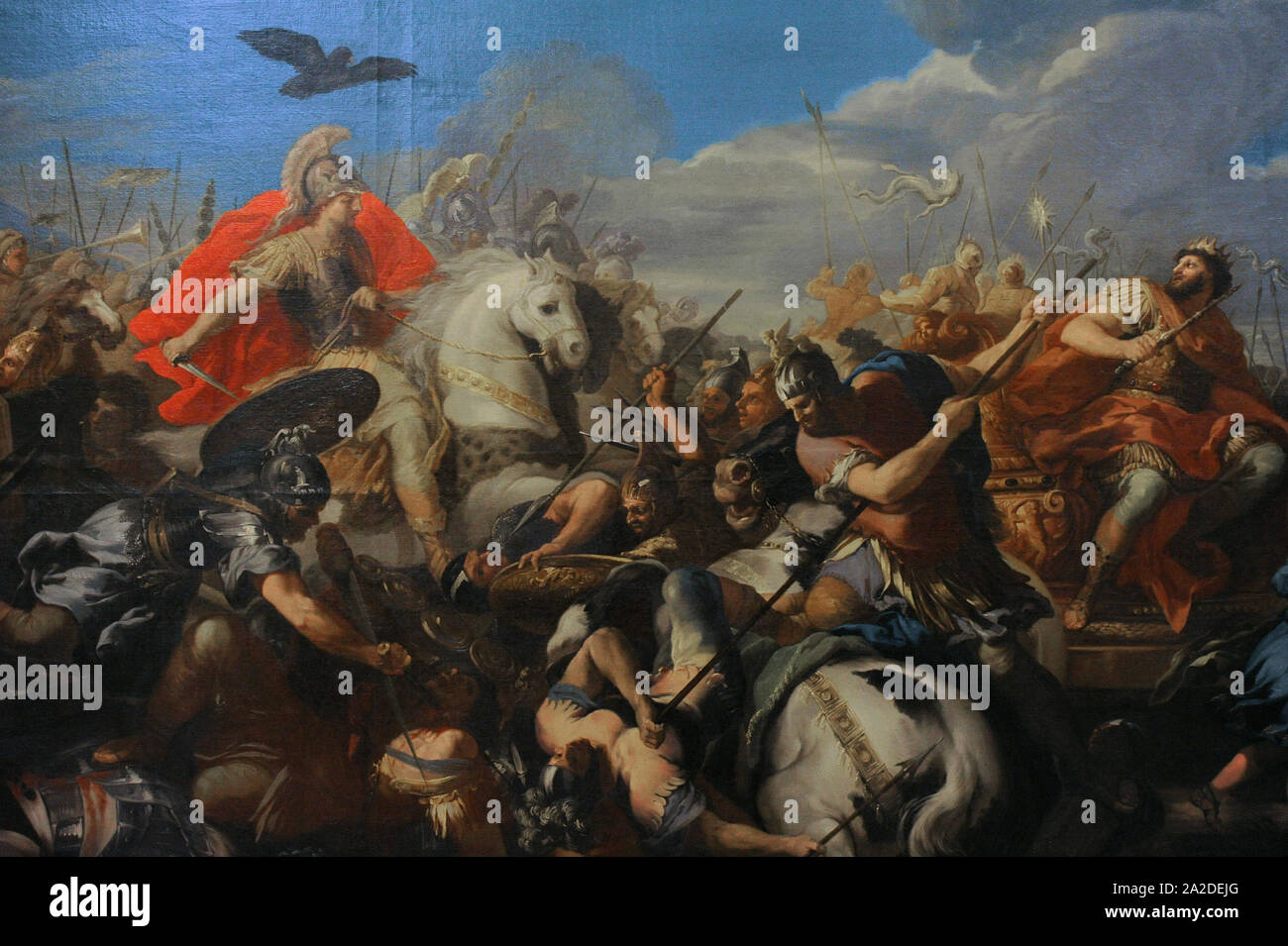 Battle of Arbelas or Battle of Gaugamela (331 BC). Combat between Alexander the Great and the Persian King Darius III. Painting by Jose del Castillo (1737-1793). Detail. San Fernando Royal Academy of Fine Arts. Madrid. Spain. Stock Photohttps://www.alamy.com/image-license-details/?v=1https://www.alamy.com/battle-of-arbelas-or-battle-of-gaugamela-331-bc-combat-between-alexander-the-great-and-the-persian-king-darius-iii-painting-by-jose-del-castillo-1737-1793-detail-san-fernando-royal-academy-of-fine-arts-madrid-spain-image328523176.html
Battle of Arbelas or Battle of Gaugamela (331 BC). Combat between Alexander the Great and the Persian King Darius III. Painting by Jose del Castillo (1737-1793). Detail. San Fernando Royal Academy of Fine Arts. Madrid. Spain. Stock Photohttps://www.alamy.com/image-license-details/?v=1https://www.alamy.com/battle-of-arbelas-or-battle-of-gaugamela-331-bc-combat-between-alexander-the-great-and-the-persian-king-darius-iii-painting-by-jose-del-castillo-1737-1793-detail-san-fernando-royal-academy-of-fine-arts-madrid-spain-image328523176.htmlRM2A2DEJG–Battle of Arbelas or Battle of Gaugamela (331 BC). Combat between Alexander the Great and the Persian King Darius III. Painting by Jose del Castillo (1737-1793). Detail. San Fernando Royal Academy of Fine Arts. Madrid. Spain.
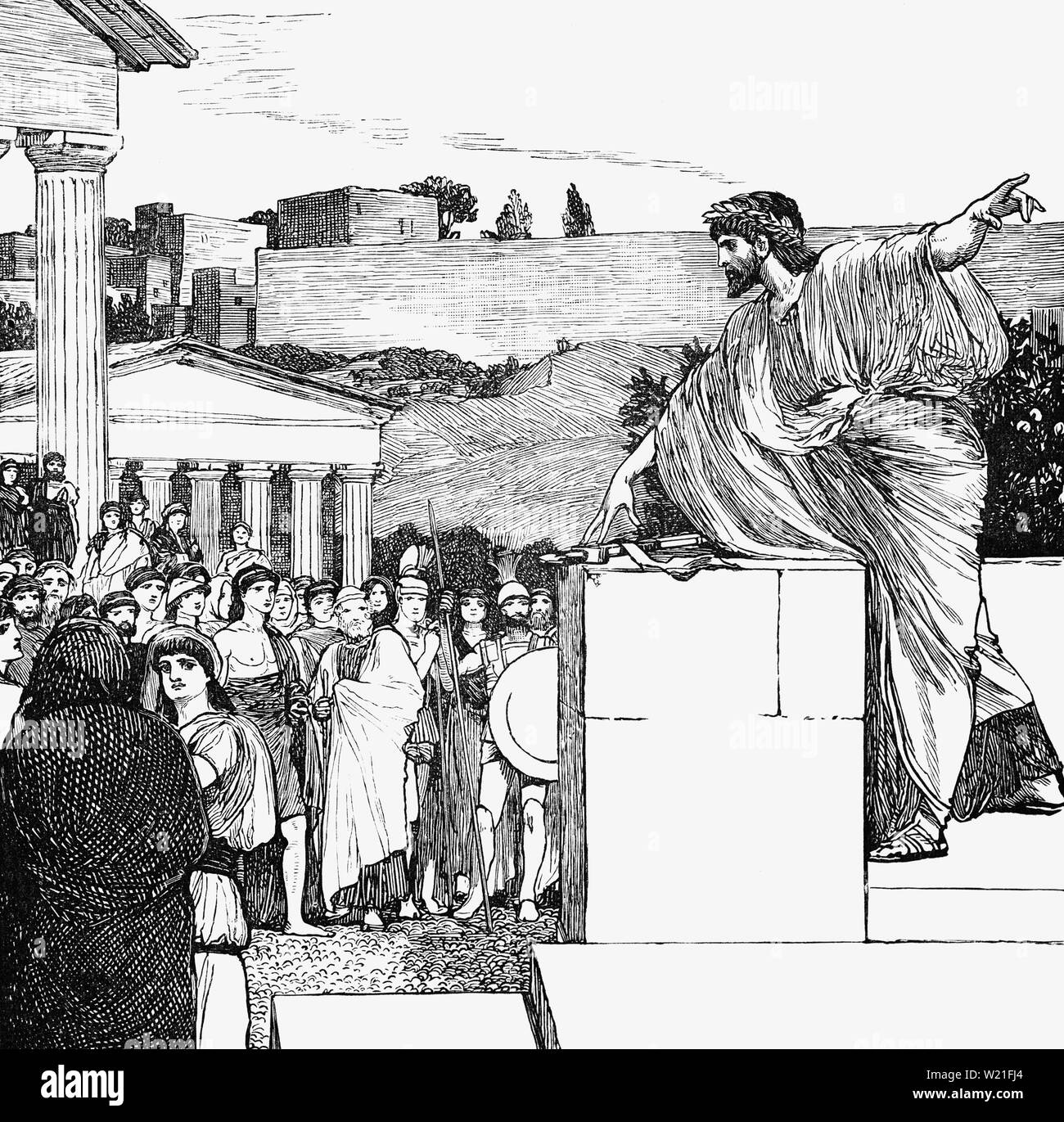 An oration by Demosthenes (384 – 322 BCE), a Greek statesman and orator of ancient Athens. His orations constitute a significant expression of contemporary Athenian intellectual prowess and provide an insight into the politics and culture of ancient Greece during the 4th century BC. After the death of Philip II, King of Macedonia, Demosthenes played a leading part in his city's uprising against Alexander the Great. However, his efforts failed and Alexander's successor in Athens, Antipater, sent his men to track Demosthenes down. Demosthenes took his own life, in order to avoid arrest. Stock Photohttps://www.alamy.com/image-license-details/?v=1https://www.alamy.com/an-oration-by-demosthenes-384-322-bce-a-greek-statesman-and-orator-of-ancient-athens-his-orations-constitute-a-significant-expression-of-contemporary-athenian-intellectual-prowess-and-provide-an-insight-into-the-politics-and-culture-of-ancient-greece-during-the-4th-century-bc-after-the-death-of-philip-ii-king-of-macedonia-demosthenes-played-a-leading-part-in-his-citys-uprising-against-alexander-the-great-however-his-efforts-failed-and-alexanders-successor-in-athens-antipater-sent-his-men-to-track-demosthenes-down-demosthenes-took-his-own-life-in-order-to-avoid-arrest-image259419052.html
An oration by Demosthenes (384 – 322 BCE), a Greek statesman and orator of ancient Athens. His orations constitute a significant expression of contemporary Athenian intellectual prowess and provide an insight into the politics and culture of ancient Greece during the 4th century BC. After the death of Philip II, King of Macedonia, Demosthenes played a leading part in his city's uprising against Alexander the Great. However, his efforts failed and Alexander's successor in Athens, Antipater, sent his men to track Demosthenes down. Demosthenes took his own life, in order to avoid arrest. Stock Photohttps://www.alamy.com/image-license-details/?v=1https://www.alamy.com/an-oration-by-demosthenes-384-322-bce-a-greek-statesman-and-orator-of-ancient-athens-his-orations-constitute-a-significant-expression-of-contemporary-athenian-intellectual-prowess-and-provide-an-insight-into-the-politics-and-culture-of-ancient-greece-during-the-4th-century-bc-after-the-death-of-philip-ii-king-of-macedonia-demosthenes-played-a-leading-part-in-his-citys-uprising-against-alexander-the-great-however-his-efforts-failed-and-alexanders-successor-in-athens-antipater-sent-his-men-to-track-demosthenes-down-demosthenes-took-his-own-life-in-order-to-avoid-arrest-image259419052.htmlRMW21FJ4–An oration by Demosthenes (384 – 322 BCE), a Greek statesman and orator of ancient Athens. His orations constitute a significant expression of contemporary Athenian intellectual prowess and provide an insight into the politics and culture of ancient Greece during the 4th century BC. After the death of Philip II, King of Macedonia, Demosthenes played a leading part in his city's uprising against Alexander the Great. However, his efforts failed and Alexander's successor in Athens, Antipater, sent his men to track Demosthenes down. Demosthenes took his own life, in order to avoid arrest.
 Alexander Sarcophagus. 4th century BC. Alexander fighting the Persians at the Battle of Issus (333 BC). Detail. Pentelic marble. Stock Photohttps://www.alamy.com/image-license-details/?v=1https://www.alamy.com/stock-photo-alexander-sarcophagus-4th-century-bc-alexander-fighting-the-persians-70946229.html
Alexander Sarcophagus. 4th century BC. Alexander fighting the Persians at the Battle of Issus (333 BC). Detail. Pentelic marble. Stock Photohttps://www.alamy.com/image-license-details/?v=1https://www.alamy.com/stock-photo-alexander-sarcophagus-4th-century-bc-alexander-fighting-the-persians-70946229.htmlRME3BTHW–Alexander Sarcophagus. 4th century BC. Alexander fighting the Persians at the Battle of Issus (333 BC). Detail. Pentelic marble.
 Image taken from page 309 of 'Comic History of Greece from the earliest times to the death of Alexander the Great ... Illustrated, etc' Image taken from page 309 of 'Comic History of Greece Stock Photohttps://www.alamy.com/image-license-details/?v=1https://www.alamy.com/stock-photo-image-taken-from-page-309-of-comic-history-of-greece-from-the-earliest-85968275.html
Image taken from page 309 of 'Comic History of Greece from the earliest times to the death of Alexander the Great ... Illustrated, etc' Image taken from page 309 of 'Comic History of Greece Stock Photohttps://www.alamy.com/image-license-details/?v=1https://www.alamy.com/stock-photo-image-taken-from-page-309-of-comic-history-of-greece-from-the-earliest-85968275.htmlRMEYT5BF–Image taken from page 309 of 'Comic History of Greece from the earliest times to the death of Alexander the Great ... Illustrated, etc' Image taken from page 309 of 'Comic History of Greece
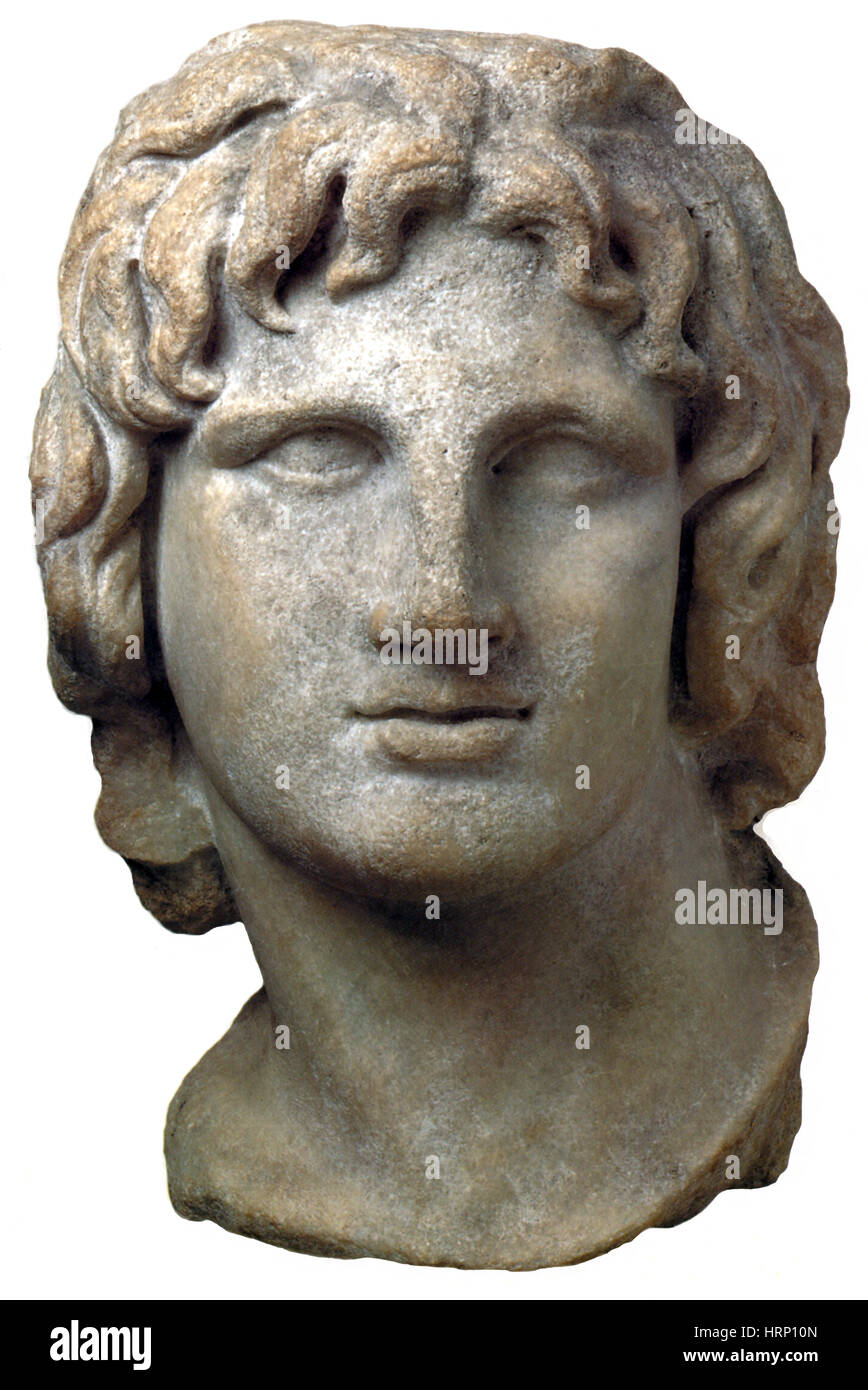 Alexander the Great, Greek King of Macedon Stock Photohttps://www.alamy.com/image-license-details/?v=1https://www.alamy.com/stock-photo-alexander-the-great-greek-king-of-macedon-135093413.html
Alexander the Great, Greek King of Macedon Stock Photohttps://www.alamy.com/image-license-details/?v=1https://www.alamy.com/stock-photo-alexander-the-great-greek-king-of-macedon-135093413.htmlRMHRP10N–Alexander the Great, Greek King of Macedon
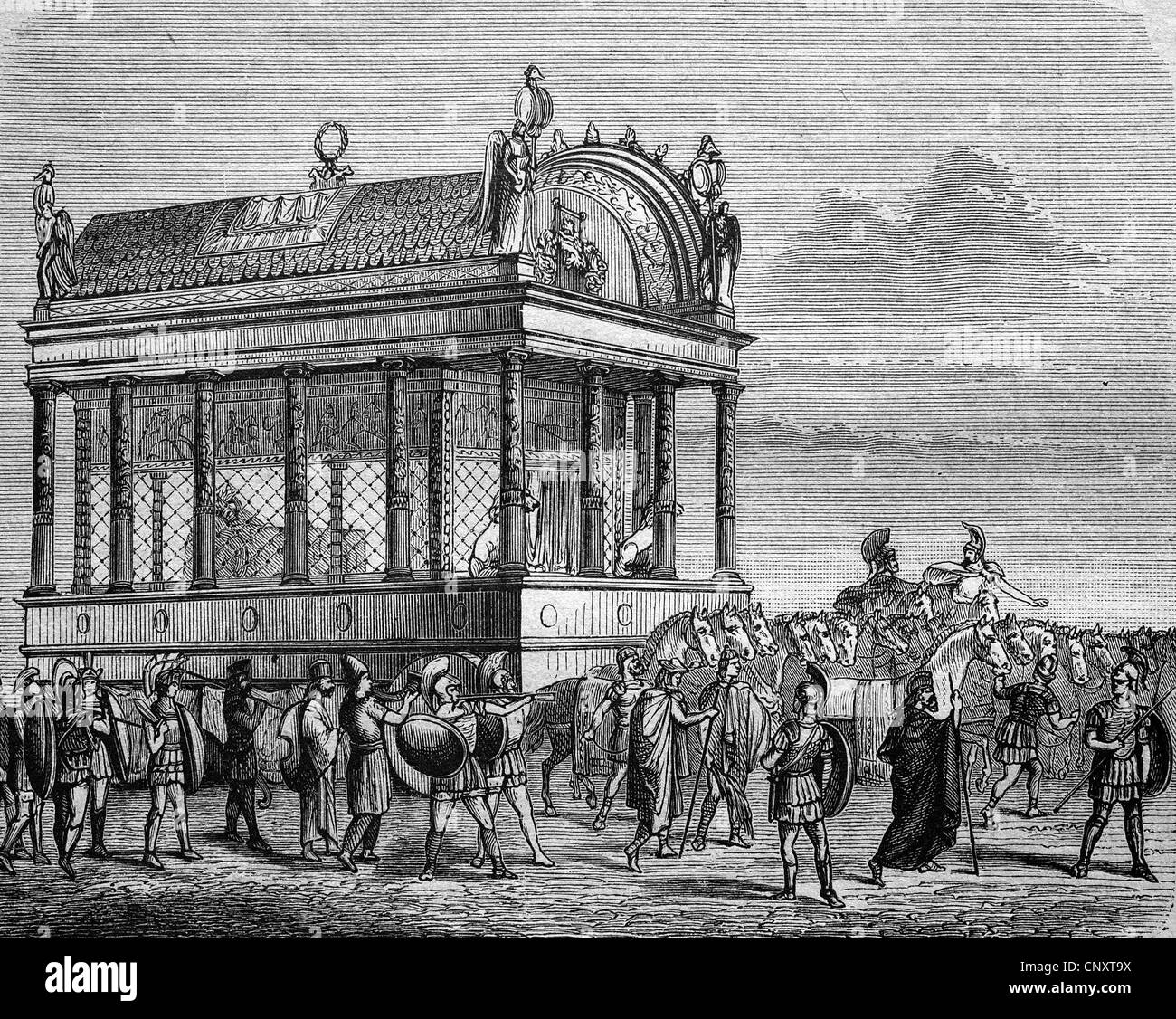 Hearse with the body of Alexander the Great, historical engraving, 1888 Stock Photohttps://www.alamy.com/image-license-details/?v=1https://www.alamy.com/stock-photo-hearse-with-the-body-of-alexander-the-great-historical-engraving-1888-47918358.html
Hearse with the body of Alexander the Great, historical engraving, 1888 Stock Photohttps://www.alamy.com/image-license-details/?v=1https://www.alamy.com/stock-photo-hearse-with-the-body-of-alexander-the-great-historical-engraving-1888-47918358.htmlRFCNXT9X–Hearse with the body of Alexander the Great, historical engraving, 1888
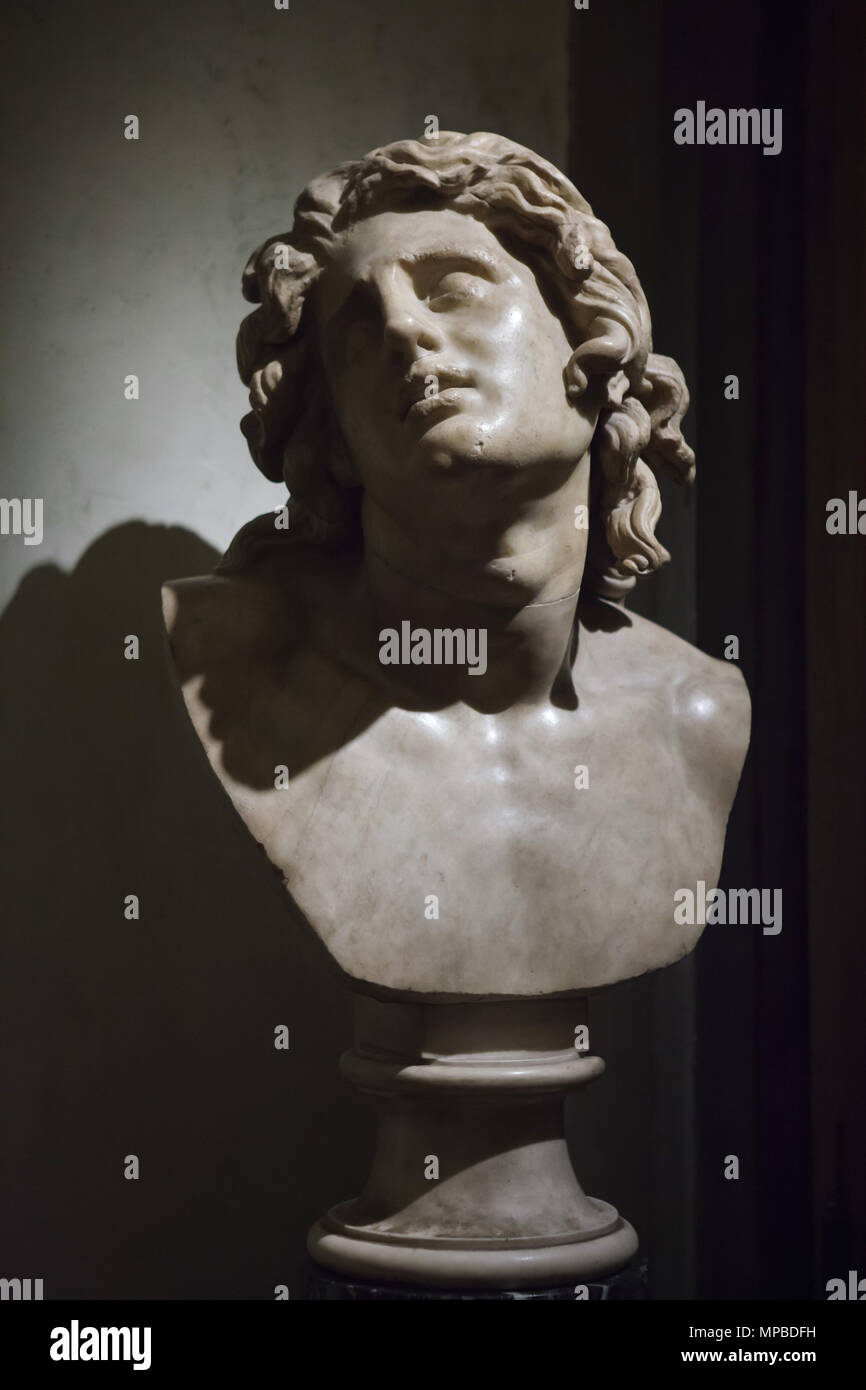 Bust of the Giant also known as the Dying Alexander. Roman marble copy after a Greek original of the Hellenistic period on display in the Uffizi Gallery (Galleria degli Uffizi) in Florence, Tuscany, Italy. Stock Photohttps://www.alamy.com/image-license-details/?v=1https://www.alamy.com/bust-of-the-giant-also-known-as-the-dying-alexander-roman-marble-copy-after-a-greek-original-of-the-hellenistic-period-on-display-in-the-uffizi-gallery-galleria-degli-uffizi-in-florence-tuscany-italy-image185878213.html
Bust of the Giant also known as the Dying Alexander. Roman marble copy after a Greek original of the Hellenistic period on display in the Uffizi Gallery (Galleria degli Uffizi) in Florence, Tuscany, Italy. Stock Photohttps://www.alamy.com/image-license-details/?v=1https://www.alamy.com/bust-of-the-giant-also-known-as-the-dying-alexander-roman-marble-copy-after-a-greek-original-of-the-hellenistic-period-on-display-in-the-uffizi-gallery-galleria-degli-uffizi-in-florence-tuscany-italy-image185878213.htmlRMMPBDFH–Bust of the Giant also known as the Dying Alexander. Roman marble copy after a Greek original of the Hellenistic period on display in the Uffizi Gallery (Galleria degli Uffizi) in Florence, Tuscany, Italy.
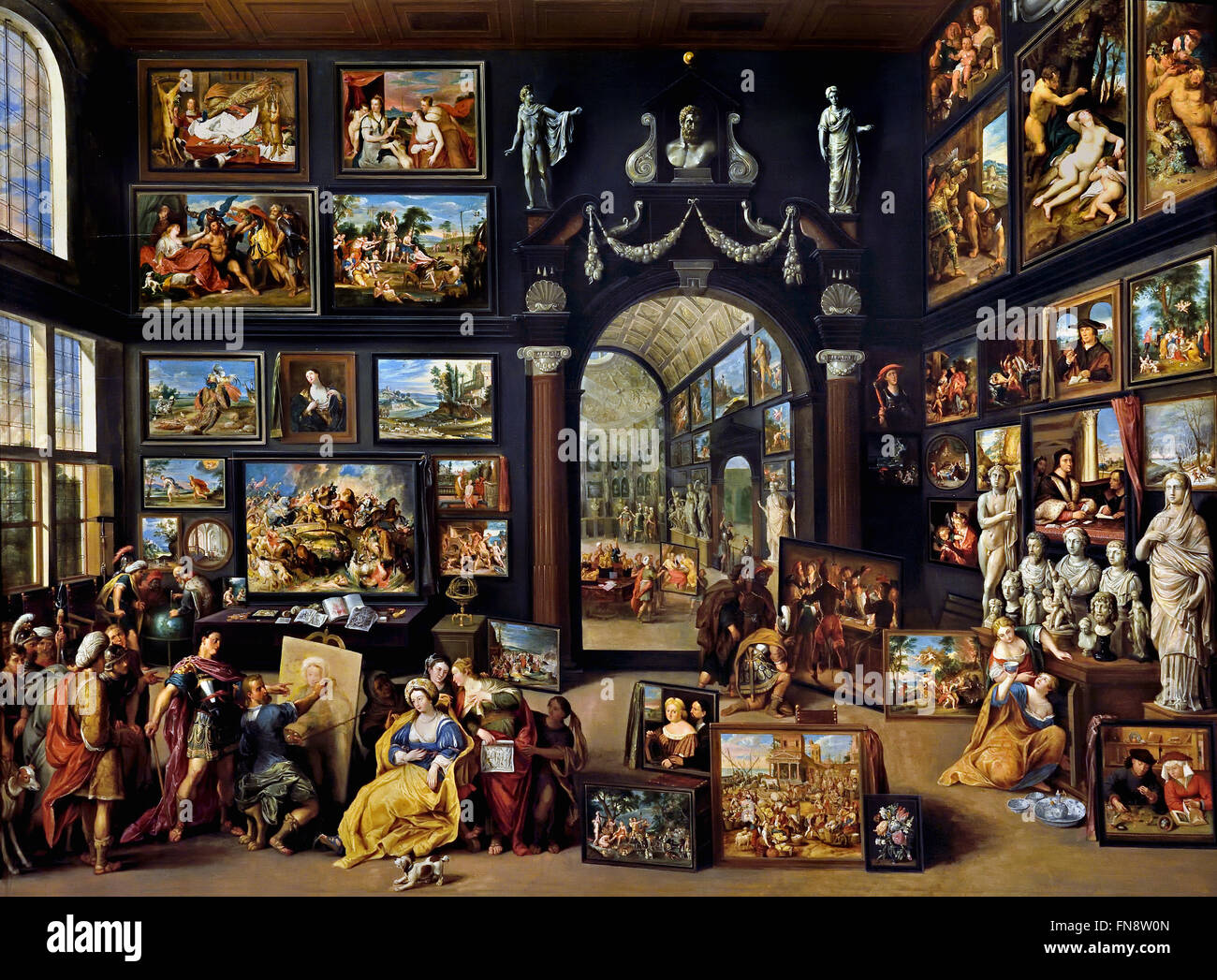 Apelles Painting Campaspe 1630 by Willem van Haecht 1593-1637 Dutch Netherlands Alexander the Great visits the studio of Apelles ( Alexander I was Emperor of Russia from 1801, the first King of Congress Poland from 1815, and the Grand Duke of Finland from 1809 to his death. ) Stock Photohttps://www.alamy.com/image-license-details/?v=1https://www.alamy.com/stock-photo-apelles-painting-campaspe-1630-by-willem-van-haecht-1593-1637-dutch-99154853.html
Apelles Painting Campaspe 1630 by Willem van Haecht 1593-1637 Dutch Netherlands Alexander the Great visits the studio of Apelles ( Alexander I was Emperor of Russia from 1801, the first King of Congress Poland from 1815, and the Grand Duke of Finland from 1809 to his death. ) Stock Photohttps://www.alamy.com/image-license-details/?v=1https://www.alamy.com/stock-photo-apelles-painting-campaspe-1630-by-willem-van-haecht-1593-1637-dutch-99154853.htmlRMFN8W0N–Apelles Painting Campaspe 1630 by Willem van Haecht 1593-1637 Dutch Netherlands Alexander the Great visits the studio of Apelles ( Alexander I was Emperor of Russia from 1801, the first King of Congress Poland from 1815, and the Grand Duke of Finland from 1809 to his death. )
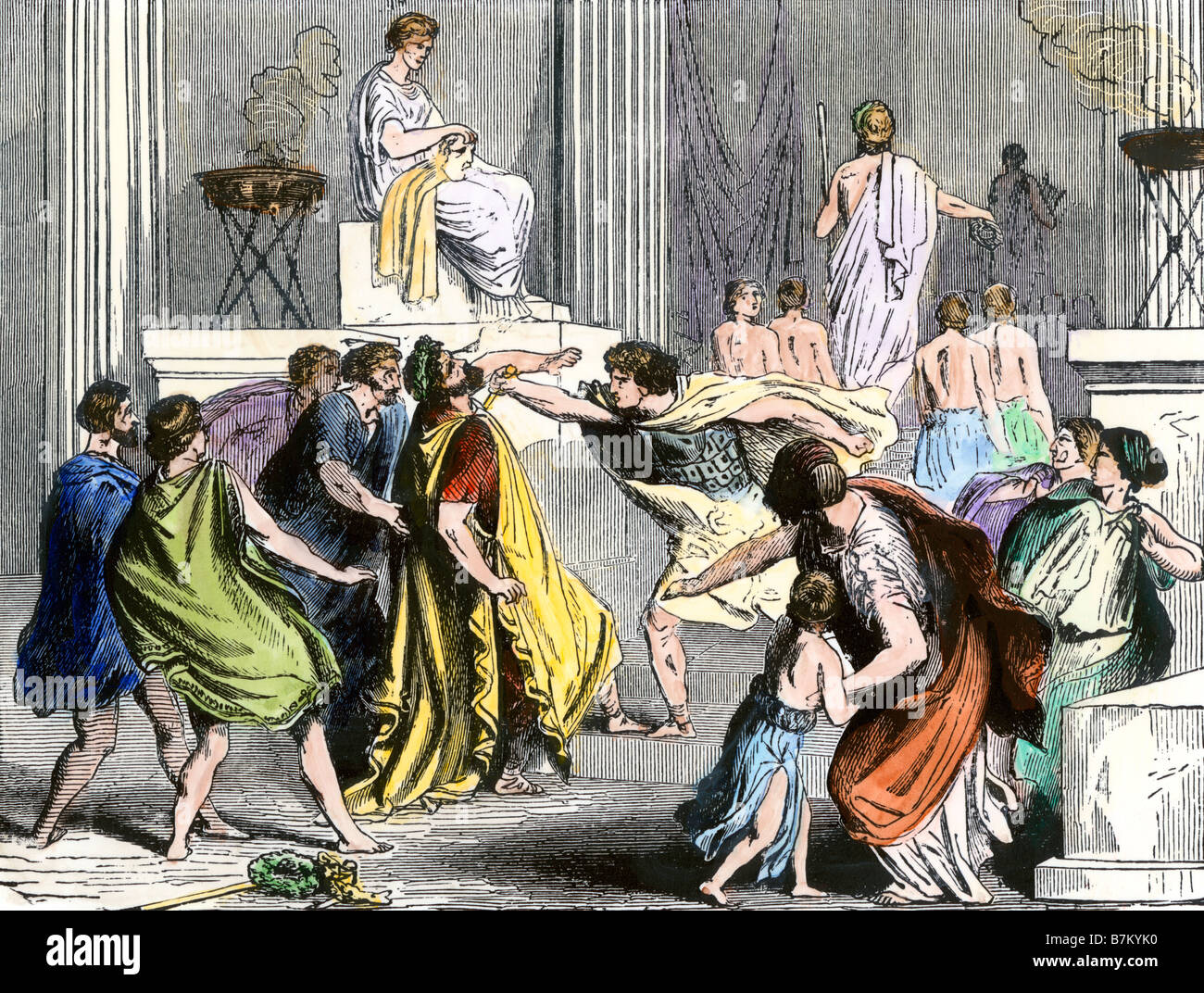 Assassination of King Philip of Macedon, father of Alexander the Great 336 BC. Hand-colored woodcut Stock Photohttps://www.alamy.com/image-license-details/?v=1https://www.alamy.com/stock-photo-assassination-of-king-philip-of-macedon-father-of-alexander-the-great-21951748.html
Assassination of King Philip of Macedon, father of Alexander the Great 336 BC. Hand-colored woodcut Stock Photohttps://www.alamy.com/image-license-details/?v=1https://www.alamy.com/stock-photo-assassination-of-king-philip-of-macedon-father-of-alexander-the-great-21951748.htmlRMB7KYK0–Assassination of King Philip of Macedon, father of Alexander the Great 336 BC. Hand-colored woodcut
 The Death of Alexander the Great after the painting by Karl von Piloty (1886) Stock Photohttps://www.alamy.com/image-license-details/?v=1https://www.alamy.com/the-death-of-alexander-the-great-after-the-painting-by-karl-von-piloty-1886-image477914234.html
The Death of Alexander the Great after the painting by Karl von Piloty (1886) Stock Photohttps://www.alamy.com/image-license-details/?v=1https://www.alamy.com/the-death-of-alexander-the-great-after-the-painting-by-karl-von-piloty-1886-image477914234.htmlRM2JNETDE–The Death of Alexander the Great after the painting by Karl von Piloty (1886)
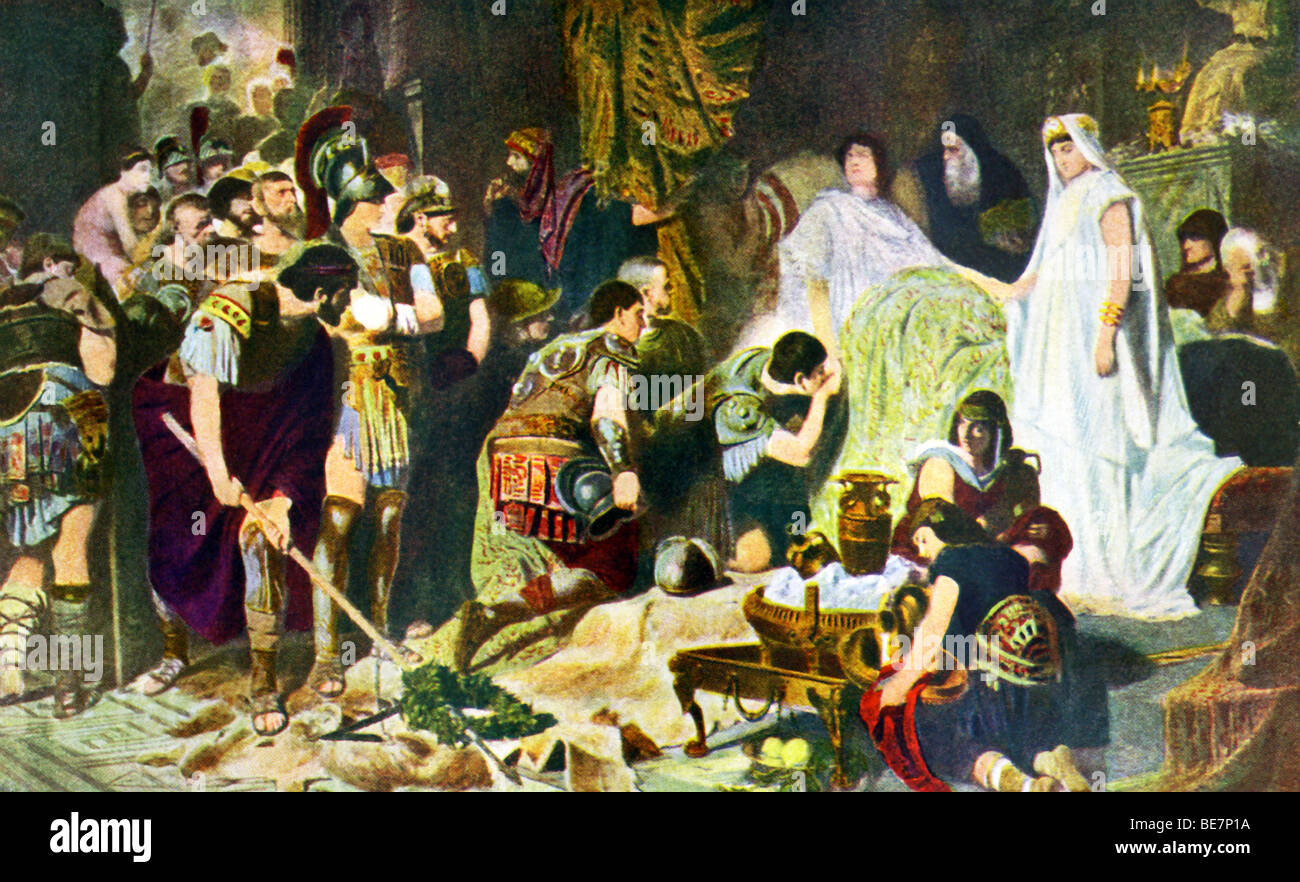 Alexander the Great fell ill in Babylon on his return to Greece and Macedonia. He died there in 323 B.C., pictured here. Stock Photohttps://www.alamy.com/image-license-details/?v=1https://www.alamy.com/stock-photo-alexander-the-great-fell-ill-in-babylon-on-his-return-to-greece-and-25986502.html
Alexander the Great fell ill in Babylon on his return to Greece and Macedonia. He died there in 323 B.C., pictured here. Stock Photohttps://www.alamy.com/image-license-details/?v=1https://www.alamy.com/stock-photo-alexander-the-great-fell-ill-in-babylon-on-his-return-to-greece-and-25986502.htmlRFBE7P1A–Alexander the Great fell ill in Babylon on his return to Greece and Macedonia. He died there in 323 B.C., pictured here.
 Illuminated Manuscript, Five poems (quintet), Alexander the Great laments the death of Darius, This is an illuminated and illustrated copy of the Khamsah (quintet) by Niẓāmī Ganjavī (d. 605 AH / 1209 CE), written in 1059 AH / 1649 CE by Shams al-Dīn Kirmānī. The codex opens with an illuminated titlepiece inscribed hadhā kitāb Khamsah-ʾi Mawlānā Shaykh-i Niẓāmī. There are additional illuminated headpieces for the subsequent four poems. The illustrations are in different styles executed during the Safavid and Qajar periods Stock Photohttps://www.alamy.com/image-license-details/?v=1https://www.alamy.com/illuminated-manuscript-five-poems-quintet-alexander-the-great-laments-the-death-of-darius-this-is-an-illuminated-and-illustrated-copy-of-the-khamsah-quintet-by-nim-ganjav-d-605-ah-1209-ce-written-in-1059-ah-1649-ce-by-shams-al-dn-kirmn-the-codex-opens-with-an-illuminated-titlepiece-inscribed-hadh-kitb-khamsah-i-mawln-shaykh-i-nim-there-are-additional-illuminated-headpieces-for-the-subsequent-four-poems-the-illustrations-are-in-different-styles-executed-during-the-safavid-and-qajar-periods-image573473899.html
Illuminated Manuscript, Five poems (quintet), Alexander the Great laments the death of Darius, This is an illuminated and illustrated copy of the Khamsah (quintet) by Niẓāmī Ganjavī (d. 605 AH / 1209 CE), written in 1059 AH / 1649 CE by Shams al-Dīn Kirmānī. The codex opens with an illuminated titlepiece inscribed hadhā kitāb Khamsah-ʾi Mawlānā Shaykh-i Niẓāmī. There are additional illuminated headpieces for the subsequent four poems. The illustrations are in different styles executed during the Safavid and Qajar periods Stock Photohttps://www.alamy.com/image-license-details/?v=1https://www.alamy.com/illuminated-manuscript-five-poems-quintet-alexander-the-great-laments-the-death-of-darius-this-is-an-illuminated-and-illustrated-copy-of-the-khamsah-quintet-by-nim-ganjav-d-605-ah-1209-ce-written-in-1059-ah-1649-ce-by-shams-al-dn-kirmn-the-codex-opens-with-an-illuminated-titlepiece-inscribed-hadh-kitb-khamsah-i-mawln-shaykh-i-nim-there-are-additional-illuminated-headpieces-for-the-subsequent-four-poems-the-illustrations-are-in-different-styles-executed-during-the-safavid-and-qajar-periods-image573473899.htmlRM2T8YYPK–Illuminated Manuscript, Five poems (quintet), Alexander the Great laments the death of Darius, This is an illuminated and illustrated copy of the Khamsah (quintet) by Niẓāmī Ganjavī (d. 605 AH / 1209 CE), written in 1059 AH / 1649 CE by Shams al-Dīn Kirmānī. The codex opens with an illuminated titlepiece inscribed hadhā kitāb Khamsah-ʾi Mawlānā Shaykh-i Niẓāmī. There are additional illuminated headpieces for the subsequent four poems. The illustrations are in different styles executed during the Safavid and Qajar periods
 Art inspired by Sarcophagus of Alexander, Gelatin silver photograph, ca. 1860-1880, Ottoman, sheet: height: 12 in., Alexander the Great, Ancient Greece, burial, death, mortality, resting place, tomb, Classic works modernized by Artotop with a splash of modernity. Shapes, color and value, eye-catching visual impact on art. Emotions through freedom of artworks in a contemporary way. A timeless message pursuing a wildly creative new direction. Artists turning to the digital medium and creating the Artotop NFT Stock Photohttps://www.alamy.com/image-license-details/?v=1https://www.alamy.com/art-inspired-by-sarcophagus-of-alexander-gelatin-silver-photograph-ca-1860-1880-ottoman-sheet-height-12-in-alexander-the-great-ancient-greece-burial-death-mortality-resting-place-tomb-classic-works-modernized-by-artotop-with-a-splash-of-modernity-shapes-color-and-value-eye-catching-visual-impact-on-art-emotions-through-freedom-of-artworks-in-a-contemporary-way-a-timeless-message-pursuing-a-wildly-creative-new-direction-artists-turning-to-the-digital-medium-and-creating-the-artotop-nft-image459563155.html
Art inspired by Sarcophagus of Alexander, Gelatin silver photograph, ca. 1860-1880, Ottoman, sheet: height: 12 in., Alexander the Great, Ancient Greece, burial, death, mortality, resting place, tomb, Classic works modernized by Artotop with a splash of modernity. Shapes, color and value, eye-catching visual impact on art. Emotions through freedom of artworks in a contemporary way. A timeless message pursuing a wildly creative new direction. Artists turning to the digital medium and creating the Artotop NFT Stock Photohttps://www.alamy.com/image-license-details/?v=1https://www.alamy.com/art-inspired-by-sarcophagus-of-alexander-gelatin-silver-photograph-ca-1860-1880-ottoman-sheet-height-12-in-alexander-the-great-ancient-greece-burial-death-mortality-resting-place-tomb-classic-works-modernized-by-artotop-with-a-splash-of-modernity-shapes-color-and-value-eye-catching-visual-impact-on-art-emotions-through-freedom-of-artworks-in-a-contemporary-way-a-timeless-message-pursuing-a-wildly-creative-new-direction-artists-turning-to-the-digital-medium-and-creating-the-artotop-nft-image459563155.htmlRF2HKJWDR–Art inspired by Sarcophagus of Alexander, Gelatin silver photograph, ca. 1860-1880, Ottoman, sheet: height: 12 in., Alexander the Great, Ancient Greece, burial, death, mortality, resting place, tomb, Classic works modernized by Artotop with a splash of modernity. Shapes, color and value, eye-catching visual impact on art. Emotions through freedom of artworks in a contemporary way. A timeless message pursuing a wildly creative new direction. Artists turning to the digital medium and creating the Artotop NFT
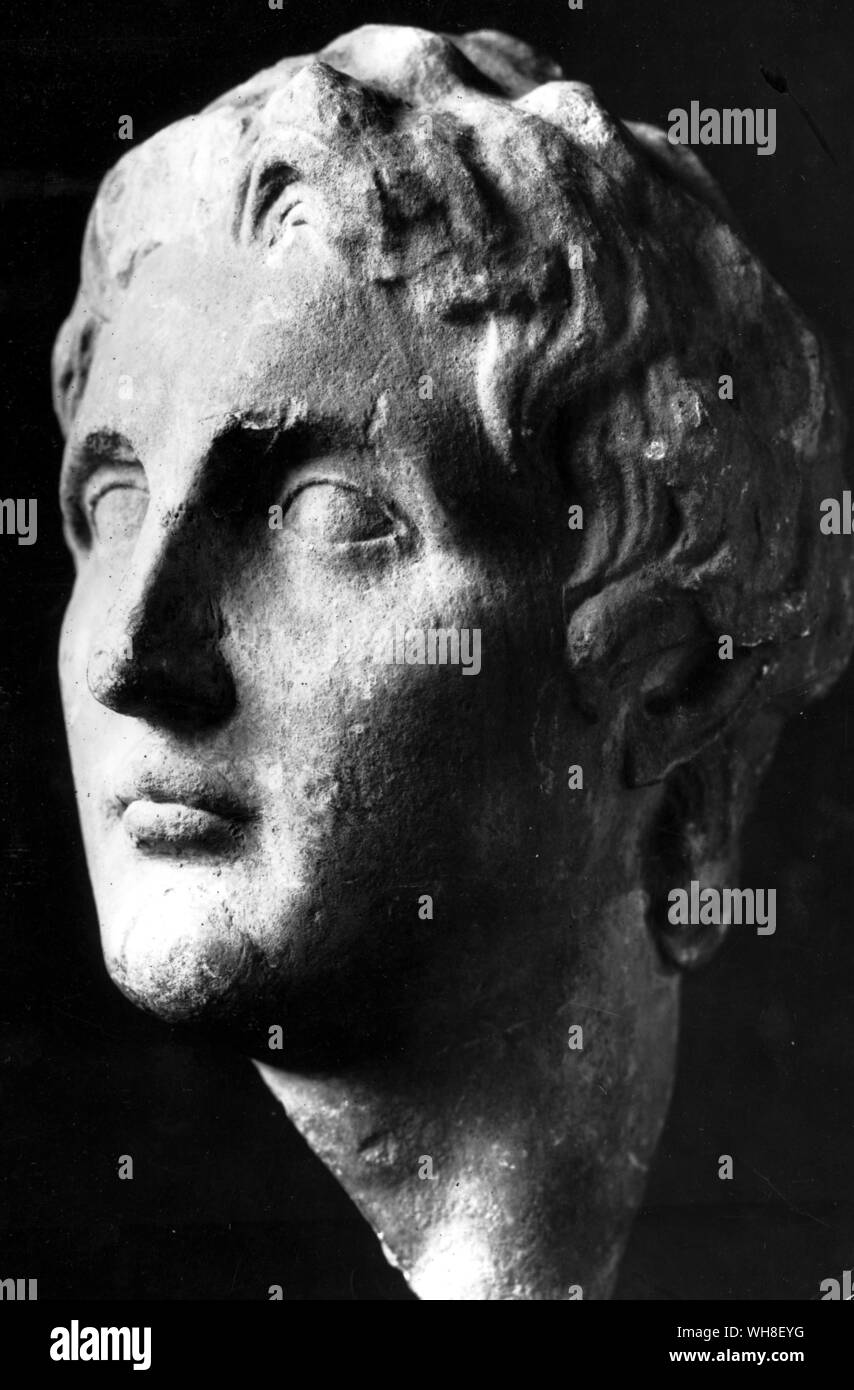 Portrait of Alexander the Great (356 BC-323 BC), King of Macedon 336-323 BC. He is considered one of the most successful military commanders in world history, conquering most of the known world before his death. The Nature of Alexander, by Mary Renault. Stock Photohttps://www.alamy.com/image-license-details/?v=1https://www.alamy.com/portrait-of-alexander-the-great-356-bc-323-bc-king-of-macedon-336-323-bc-he-is-considered-one-of-the-most-successful-military-commanders-in-world-history-conquering-most-of-the-known-world-before-his-death-the-nature-of-alexander-by-mary-renault-image268792036.html
Portrait of Alexander the Great (356 BC-323 BC), King of Macedon 336-323 BC. He is considered one of the most successful military commanders in world history, conquering most of the known world before his death. The Nature of Alexander, by Mary Renault. Stock Photohttps://www.alamy.com/image-license-details/?v=1https://www.alamy.com/portrait-of-alexander-the-great-356-bc-323-bc-king-of-macedon-336-323-bc-he-is-considered-one-of-the-most-successful-military-commanders-in-world-history-conquering-most-of-the-known-world-before-his-death-the-nature-of-alexander-by-mary-renault-image268792036.htmlRMWH8EYG–Portrait of Alexander the Great (356 BC-323 BC), King of Macedon 336-323 BC. He is considered one of the most successful military commanders in world history, conquering most of the known world before his death. The Nature of Alexander, by Mary Renault.
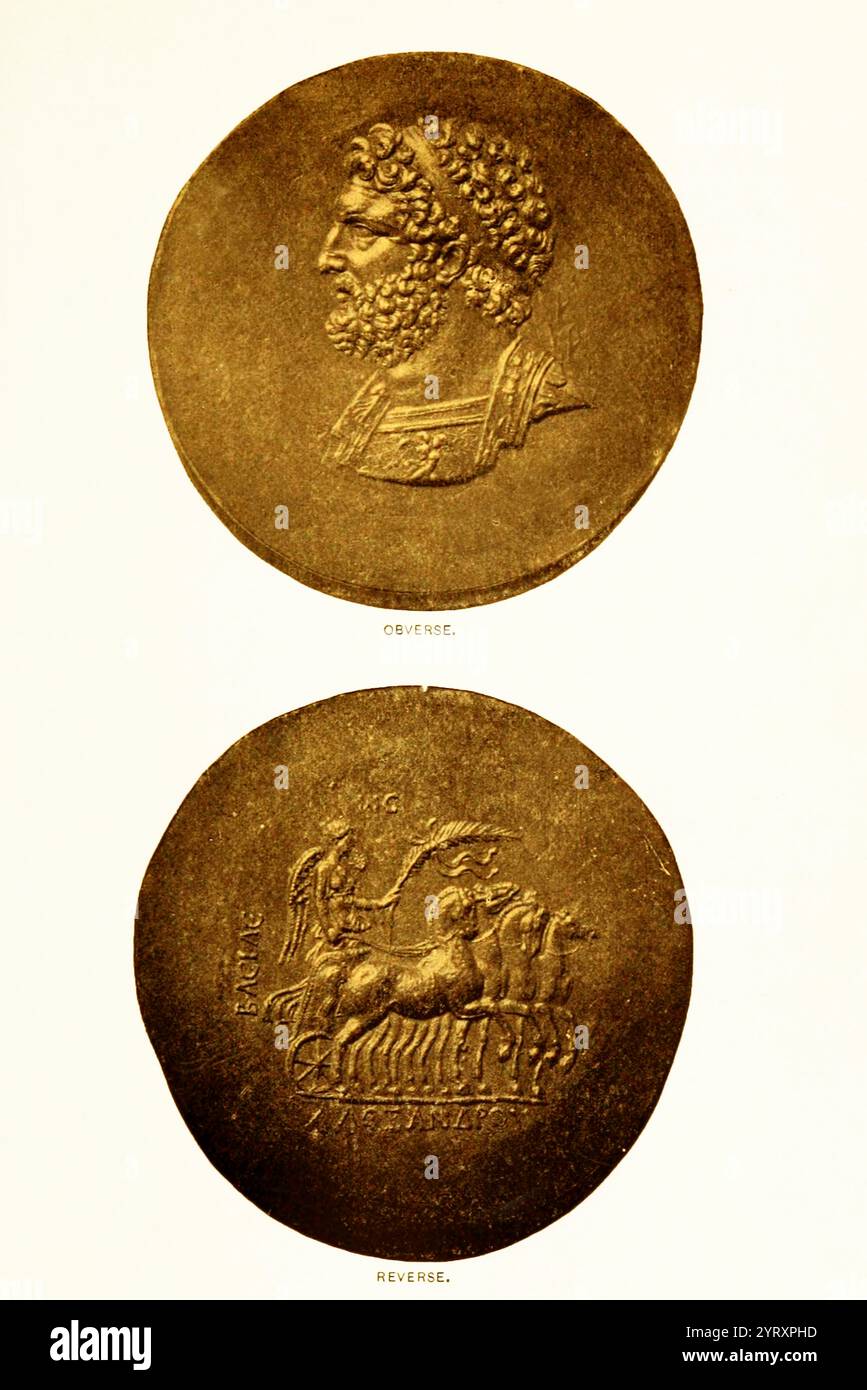 Philip II of Macedon (382 BCE ? 336 BCE ) king (basileus) of Macedonia from 359 BCE until his death in 336 BCE . He was a member of the Argead dynasty, founders of the ancient kingdom, and the father of Alexander the Great. Philip II. 359 336 BCE . Gold Medallion of Tarsus Stock Photohttps://www.alamy.com/image-license-details/?v=1https://www.alamy.com/philip-ii-of-macedon-382-bce-336-bce-king-basileus-of-macedonia-from-359-bce-until-his-death-in-336-bce-he-was-a-member-of-the-argead-dynasty-founders-of-the-ancient-kingdom-and-the-father-of-alexander-the-great-philip-ii-359-336-bce-gold-medallion-of-tarsus-image634298825.html
Philip II of Macedon (382 BCE ? 336 BCE ) king (basileus) of Macedonia from 359 BCE until his death in 336 BCE . He was a member of the Argead dynasty, founders of the ancient kingdom, and the father of Alexander the Great. Philip II. 359 336 BCE . Gold Medallion of Tarsus Stock Photohttps://www.alamy.com/image-license-details/?v=1https://www.alamy.com/philip-ii-of-macedon-382-bce-336-bce-king-basileus-of-macedonia-from-359-bce-until-his-death-in-336-bce-he-was-a-member-of-the-argead-dynasty-founders-of-the-ancient-kingdom-and-the-father-of-alexander-the-great-philip-ii-359-336-bce-gold-medallion-of-tarsus-image634298825.htmlRM2YRXPHD–Philip II of Macedon (382 BCE ? 336 BCE ) king (basileus) of Macedonia from 359 BCE until his death in 336 BCE . He was a member of the Argead dynasty, founders of the ancient kingdom, and the father of Alexander the Great. Philip II. 359 336 BCE . Gold Medallion of Tarsus
 Alexander Of Macedon Stock Photohttps://www.alamy.com/image-license-details/?v=1https://www.alamy.com/alexander-of-macedon-image3176461.html
Alexander Of Macedon Stock Photohttps://www.alamy.com/image-license-details/?v=1https://www.alamy.com/alexander-of-macedon-image3176461.htmlRMAYK80E–Alexander Of Macedon
 Hearse with the body of Alexander the Great, historical engraving, 1888 Stock Photohttps://www.alamy.com/image-license-details/?v=1https://www.alamy.com/hearse-with-the-body-of-alexander-the-great-historical-engraving-1888-image231372631.html
Hearse with the body of Alexander the Great, historical engraving, 1888 Stock Photohttps://www.alamy.com/image-license-details/?v=1https://www.alamy.com/hearse-with-the-body-of-alexander-the-great-historical-engraving-1888-image231372631.htmlRMRCBX47–Hearse with the body of Alexander the Great, historical engraving, 1888
 Death of Alexander the Great, Leonaert Bramer, c. 1655 - c. 1665 Alexander de Grote is on his deathbed, surrounded by courtings. Numbered at the top right: 48. Drawing is part of an album. paper. ink pen / brush Alexander de Grote is on his deathbed, surrounded by courtings. Numbered at the top right: 48. Drawing is part of an album. paper. ink pen / brush Stock Photohttps://www.alamy.com/image-license-details/?v=1https://www.alamy.com/death-of-alexander-the-great-leonaert-bramer-c-1655-c-1665-alexander-de-grote-is-on-his-deathbed-surrounded-by-courtings-numbered-at-the-top-right-48-drawing-is-part-of-an-album-paper-ink-pen-brush-alexander-de-grote-is-on-his-deathbed-surrounded-by-courtings-numbered-at-the-top-right-48-drawing-is-part-of-an-album-paper-ink-pen-brush-image576540139.html
Death of Alexander the Great, Leonaert Bramer, c. 1655 - c. 1665 Alexander de Grote is on his deathbed, surrounded by courtings. Numbered at the top right: 48. Drawing is part of an album. paper. ink pen / brush Alexander de Grote is on his deathbed, surrounded by courtings. Numbered at the top right: 48. Drawing is part of an album. paper. ink pen / brush Stock Photohttps://www.alamy.com/image-license-details/?v=1https://www.alamy.com/death-of-alexander-the-great-leonaert-bramer-c-1655-c-1665-alexander-de-grote-is-on-his-deathbed-surrounded-by-courtings-numbered-at-the-top-right-48-drawing-is-part-of-an-album-paper-ink-pen-brush-alexander-de-grote-is-on-his-deathbed-surrounded-by-courtings-numbered-at-the-top-right-48-drawing-is-part-of-an-album-paper-ink-pen-brush-image576540139.htmlRM2TDYJR7–Death of Alexander the Great, Leonaert Bramer, c. 1655 - c. 1665 Alexander de Grote is on his deathbed, surrounded by courtings. Numbered at the top right: 48. Drawing is part of an album. paper. ink pen / brush Alexander de Grote is on his deathbed, surrounded by courtings. Numbered at the top right: 48. Drawing is part of an album. paper. ink pen / brush
 Ancient Greek. Tetradrachm (Coin) Portraying King Antiochus VII Euergetes Sidetes. 138 BC–129 BC. Ancient Near East. Silver Coinage of Hellenistic RulersThe Hellenistic period spans the nearly three hundred years between the death of Alexander the Great of Macedonia (323 B.C.) and that of Cleopatra VII of Egypt (30 B.C.), a descendant of one of Alexander’s generals. The term Hellenistic is derived from Hellas, an ancient Greek word for Greece. It is used to describe both chronologically and culturally the era following Alexander’s conquest of Egypt and Asia, which resulted in the spread of Gre Stock Photohttps://www.alamy.com/image-license-details/?v=1https://www.alamy.com/ancient-greek-tetradrachm-coin-portraying-king-antiochus-vii-euergetes-sidetes-138-bc129-bc-ancient-near-east-silver-coinage-of-hellenistic-rulersthe-hellenistic-period-spans-the-nearly-three-hundred-years-between-the-death-of-alexander-the-great-of-macedonia-323-bc-and-that-of-cleopatra-vii-of-egypt-30-bc-a-descendant-of-one-of-alexanders-generals-the-term-hellenistic-is-derived-from-hellas-an-ancient-greek-word-for-greece-it-is-used-to-describe-both-chronologically-and-culturally-the-era-following-alexanders-conquest-of-egypt-and-asia-which-resulted-in-the-spread-of-gre-image337940341.html
Ancient Greek. Tetradrachm (Coin) Portraying King Antiochus VII Euergetes Sidetes. 138 BC–129 BC. Ancient Near East. Silver Coinage of Hellenistic RulersThe Hellenistic period spans the nearly three hundred years between the death of Alexander the Great of Macedonia (323 B.C.) and that of Cleopatra VII of Egypt (30 B.C.), a descendant of one of Alexander’s generals. The term Hellenistic is derived from Hellas, an ancient Greek word for Greece. It is used to describe both chronologically and culturally the era following Alexander’s conquest of Egypt and Asia, which resulted in the spread of Gre Stock Photohttps://www.alamy.com/image-license-details/?v=1https://www.alamy.com/ancient-greek-tetradrachm-coin-portraying-king-antiochus-vii-euergetes-sidetes-138-bc129-bc-ancient-near-east-silver-coinage-of-hellenistic-rulersthe-hellenistic-period-spans-the-nearly-three-hundred-years-between-the-death-of-alexander-the-great-of-macedonia-323-bc-and-that-of-cleopatra-vii-of-egypt-30-bc-a-descendant-of-one-of-alexanders-generals-the-term-hellenistic-is-derived-from-hellas-an-ancient-greek-word-for-greece-it-is-used-to-describe-both-chronologically-and-culturally-the-era-following-alexanders-conquest-of-egypt-and-asia-which-resulted-in-the-spread-of-gre-image337940341.htmlRM2AHPE9W–Ancient Greek. Tetradrachm (Coin) Portraying King Antiochus VII Euergetes Sidetes. 138 BC–129 BC. Ancient Near East. Silver Coinage of Hellenistic RulersThe Hellenistic period spans the nearly three hundred years between the death of Alexander the Great of Macedonia (323 B.C.) and that of Cleopatra VII of Egypt (30 B.C.), a descendant of one of Alexander’s generals. The term Hellenistic is derived from Hellas, an ancient Greek word for Greece. It is used to describe both chronologically and culturally the era following Alexander’s conquest of Egypt and Asia, which resulted in the spread of Gre
 Death of Alexander. Diary of astronomical/ meteorological phenomena observed in 323-322 BC. Cuneiform. Babylon, Iraq. British Museum. London.GBR. Stock Photohttps://www.alamy.com/image-license-details/?v=1https://www.alamy.com/stock-image-death-of-alexander-diary-of-astronomical-meteorological-phenomena-164021151.html
Death of Alexander. Diary of astronomical/ meteorological phenomena observed in 323-322 BC. Cuneiform. Babylon, Iraq. British Museum. London.GBR. Stock Photohttps://www.alamy.com/image-license-details/?v=1https://www.alamy.com/stock-image-death-of-alexander-diary-of-astronomical-meteorological-phenomena-164021151.htmlRMKERPJ7–Death of Alexander. Diary of astronomical/ meteorological phenomena observed in 323-322 BC. Cuneiform. Babylon, Iraq. British Museum. London.GBR.
 An Egyptian bas-relief of Cleopatra VII Philopator (69 – 30 BCE), the last active ruler of the Ptolemaic Kingdom of Egypt. As a member of the Ptolemaic dynasty, she was a descendant of its founder Ptolemy I Soter, a Macedonian Greek general and companion of Alexander the Great. After the death of Cleopatra, Egypt became a province of the Roman Empire, marking the end of the Hellenistic period that had lasted since the reign of Alexander (336–323 BC). Her native language was Koine Greek and she was the first Ptolemaic ruler to learn the Egyptian language. Stock Photohttps://www.alamy.com/image-license-details/?v=1https://www.alamy.com/an-egyptian-bas-relief-of-cleopatra-vii-philopator-69-30-bce-the-last-active-ruler-of-the-ptolemaic-kingdom-of-egypt-as-a-member-of-the-ptolemaic-dynasty-she-was-a-descendant-of-its-founder-ptolemy-i-soter-a-macedonian-greek-general-and-companion-of-alexander-the-great-after-the-death-of-cleopatra-egypt-became-a-province-of-the-roman-empire-marking-the-end-of-the-hellenistic-period-that-had-lasted-since-the-reign-of-alexander-336323-bc-her-native-language-was-koine-greek-and-she-was-the-first-ptolemaic-ruler-to-learn-the-egyptian-language-image263100596.html
An Egyptian bas-relief of Cleopatra VII Philopator (69 – 30 BCE), the last active ruler of the Ptolemaic Kingdom of Egypt. As a member of the Ptolemaic dynasty, she was a descendant of its founder Ptolemy I Soter, a Macedonian Greek general and companion of Alexander the Great. After the death of Cleopatra, Egypt became a province of the Roman Empire, marking the end of the Hellenistic period that had lasted since the reign of Alexander (336–323 BC). Her native language was Koine Greek and she was the first Ptolemaic ruler to learn the Egyptian language. Stock Photohttps://www.alamy.com/image-license-details/?v=1https://www.alamy.com/an-egyptian-bas-relief-of-cleopatra-vii-philopator-69-30-bce-the-last-active-ruler-of-the-ptolemaic-kingdom-of-egypt-as-a-member-of-the-ptolemaic-dynasty-she-was-a-descendant-of-its-founder-ptolemy-i-soter-a-macedonian-greek-general-and-companion-of-alexander-the-great-after-the-death-of-cleopatra-egypt-became-a-province-of-the-roman-empire-marking-the-end-of-the-hellenistic-period-that-had-lasted-since-the-reign-of-alexander-336323-bc-her-native-language-was-koine-greek-and-she-was-the-first-ptolemaic-ruler-to-learn-the-egyptian-language-image263100596.htmlRMW817DT–An Egyptian bas-relief of Cleopatra VII Philopator (69 – 30 BCE), the last active ruler of the Ptolemaic Kingdom of Egypt. As a member of the Ptolemaic dynasty, she was a descendant of its founder Ptolemy I Soter, a Macedonian Greek general and companion of Alexander the Great. After the death of Cleopatra, Egypt became a province of the Roman Empire, marking the end of the Hellenistic period that had lasted since the reign of Alexander (336–323 BC). Her native language was Koine Greek and she was the first Ptolemaic ruler to learn the Egyptian language.
 Alexander Sarcophagus. 4th century BC. Alexander fighting the Persians at the Battle of Issus (333 BC). Detail. Pentelic marble. Stock Photohttps://www.alamy.com/image-license-details/?v=1https://www.alamy.com/stock-photo-alexander-sarcophagus-4th-century-bc-alexander-fighting-the-persians-70946121.html
Alexander Sarcophagus. 4th century BC. Alexander fighting the Persians at the Battle of Issus (333 BC). Detail. Pentelic marble. Stock Photohttps://www.alamy.com/image-license-details/?v=1https://www.alamy.com/stock-photo-alexander-sarcophagus-4th-century-bc-alexander-fighting-the-persians-70946121.htmlRME3BTE1–Alexander Sarcophagus. 4th century BC. Alexander fighting the Persians at the Battle of Issus (333 BC). Detail. Pentelic marble.
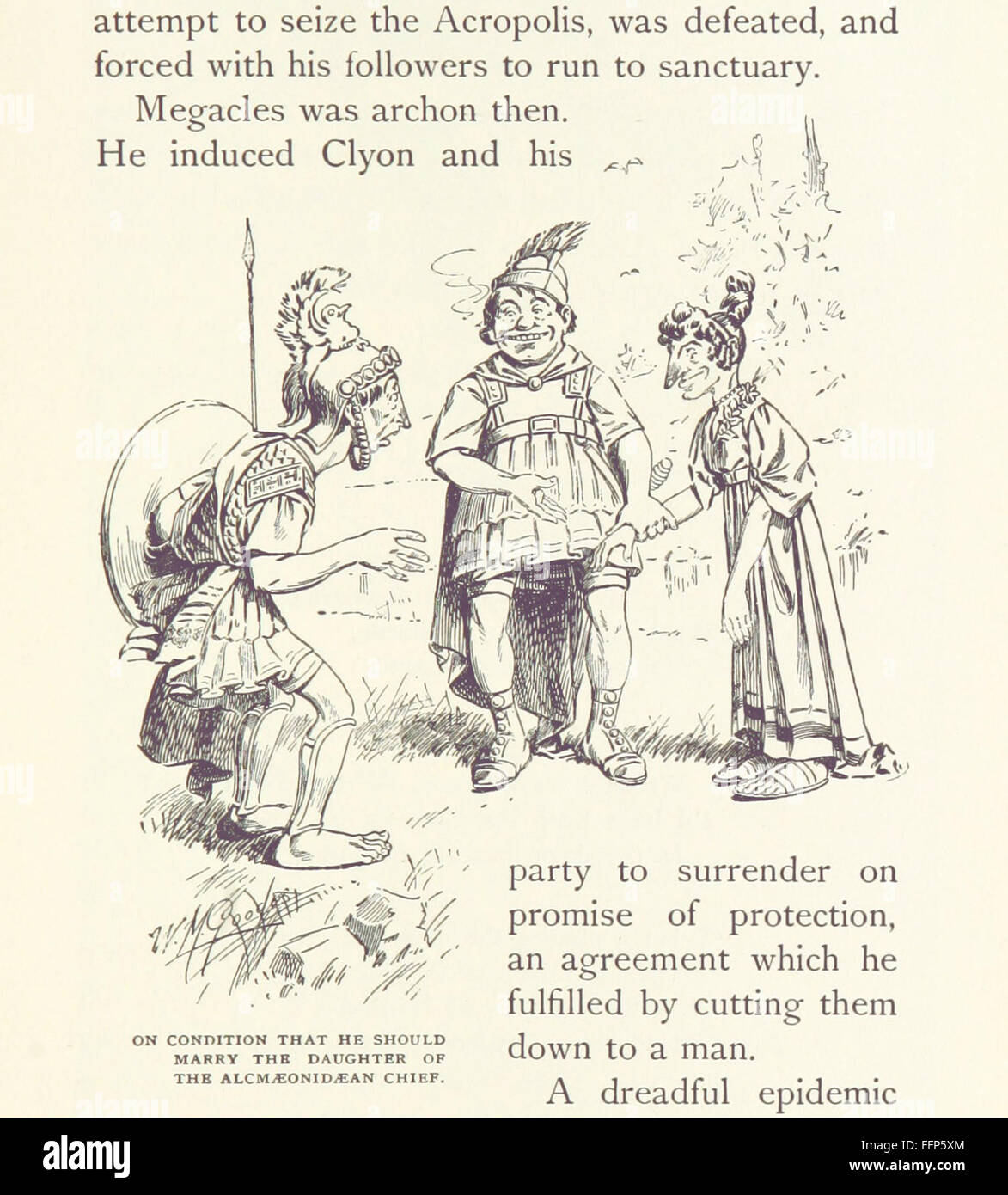 57 of 'Comic History of Greece from the earliest times to the death of Alexander the Great ... Illustrated, etc' Stock Photohttps://www.alamy.com/image-license-details/?v=1https://www.alamy.com/stock-photo-57-of-comic-history-of-greece-from-the-earliest-times-to-the-death-95759292.html
57 of 'Comic History of Greece from the earliest times to the death of Alexander the Great ... Illustrated, etc' Stock Photohttps://www.alamy.com/image-license-details/?v=1https://www.alamy.com/stock-photo-57-of-comic-history-of-greece-from-the-earliest-times-to-the-death-95759292.htmlRFFFP5XM–57 of 'Comic History of Greece from the earliest times to the death of Alexander the Great ... Illustrated, etc'
 Alexander the Great, Greek King of Macedon Stock Photohttps://www.alamy.com/image-license-details/?v=1https://www.alamy.com/stock-photo-alexander-the-great-greek-king-of-macedon-135093927.html
Alexander the Great, Greek King of Macedon Stock Photohttps://www.alamy.com/image-license-details/?v=1https://www.alamy.com/stock-photo-alexander-the-great-greek-king-of-macedon-135093927.htmlRMHRP1K3–Alexander the Great, Greek King of Macedon
 A royal court in the time after the death of Alexander the Great, Kingdom of Macedonia Stock Photohttps://www.alamy.com/image-license-details/?v=1https://www.alamy.com/stock-photo-a-royal-court-in-the-time-after-the-death-of-alexander-the-great-kingdom-145187207.html
A royal court in the time after the death of Alexander the Great, Kingdom of Macedonia Stock Photohttps://www.alamy.com/image-license-details/?v=1https://www.alamy.com/stock-photo-a-royal-court-in-the-time-after-the-death-of-alexander-the-great-kingdom-145187207.htmlRMJC5RNB–A royal court in the time after the death of Alexander the Great, Kingdom of Macedonia
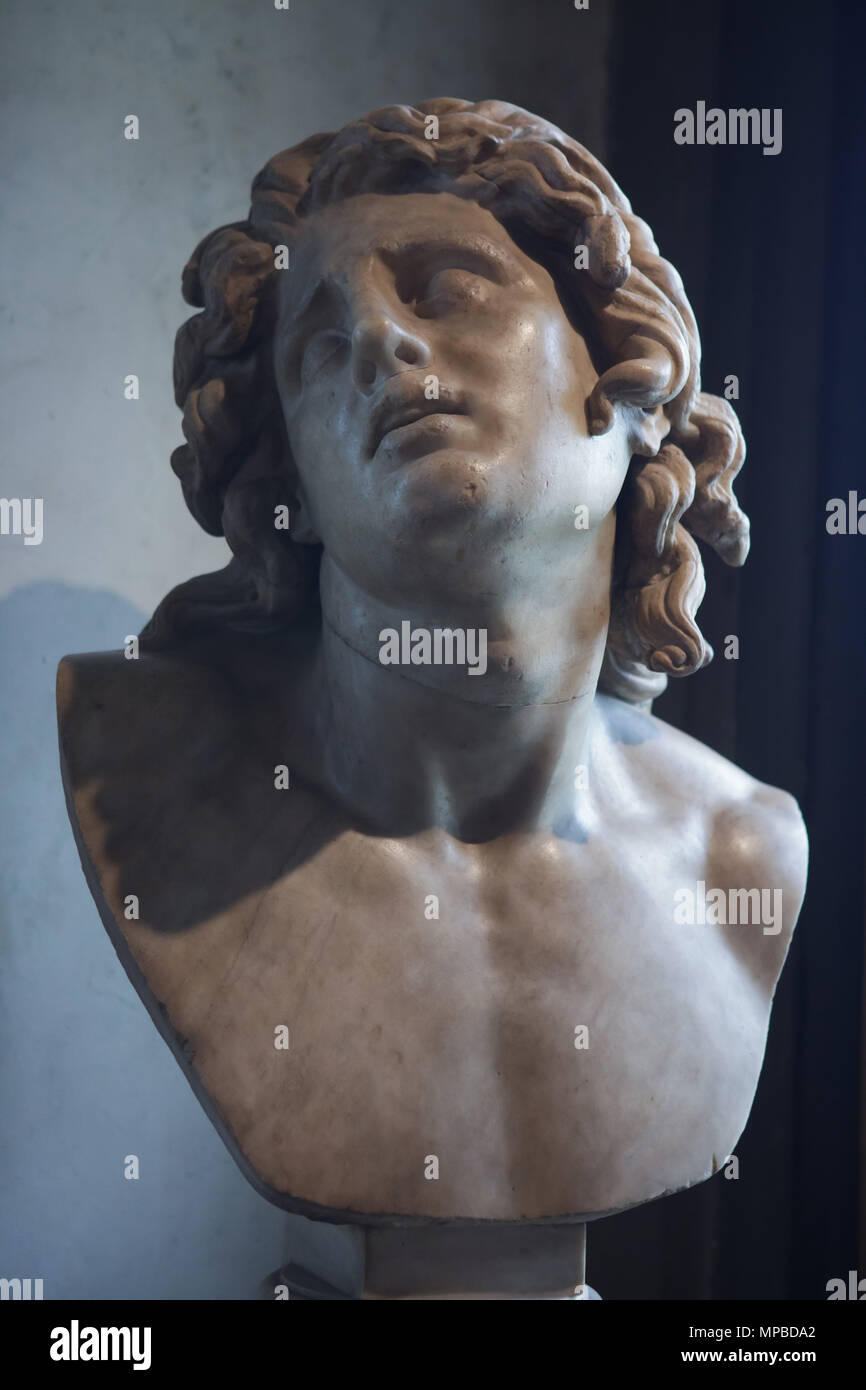 Bust of the Giant also known as the Dying Alexander. Roman marble copy after a Greek original of the Hellenistic period on display in the Uffizi Gallery (Galleria degli Uffizi) in Florence, Tuscany, Italy. Stock Photohttps://www.alamy.com/image-license-details/?v=1https://www.alamy.com/bust-of-the-giant-also-known-as-the-dying-alexander-roman-marble-copy-after-a-greek-original-of-the-hellenistic-period-on-display-in-the-uffizi-gallery-galleria-degli-uffizi-in-florence-tuscany-italy-image185878058.html
Bust of the Giant also known as the Dying Alexander. Roman marble copy after a Greek original of the Hellenistic period on display in the Uffizi Gallery (Galleria degli Uffizi) in Florence, Tuscany, Italy. Stock Photohttps://www.alamy.com/image-license-details/?v=1https://www.alamy.com/bust-of-the-giant-also-known-as-the-dying-alexander-roman-marble-copy-after-a-greek-original-of-the-hellenistic-period-on-display-in-the-uffizi-gallery-galleria-degli-uffizi-in-florence-tuscany-italy-image185878058.htmlRMMPBDA2–Bust of the Giant also known as the Dying Alexander. Roman marble copy after a Greek original of the Hellenistic period on display in the Uffizi Gallery (Galleria degli Uffizi) in Florence, Tuscany, Italy.
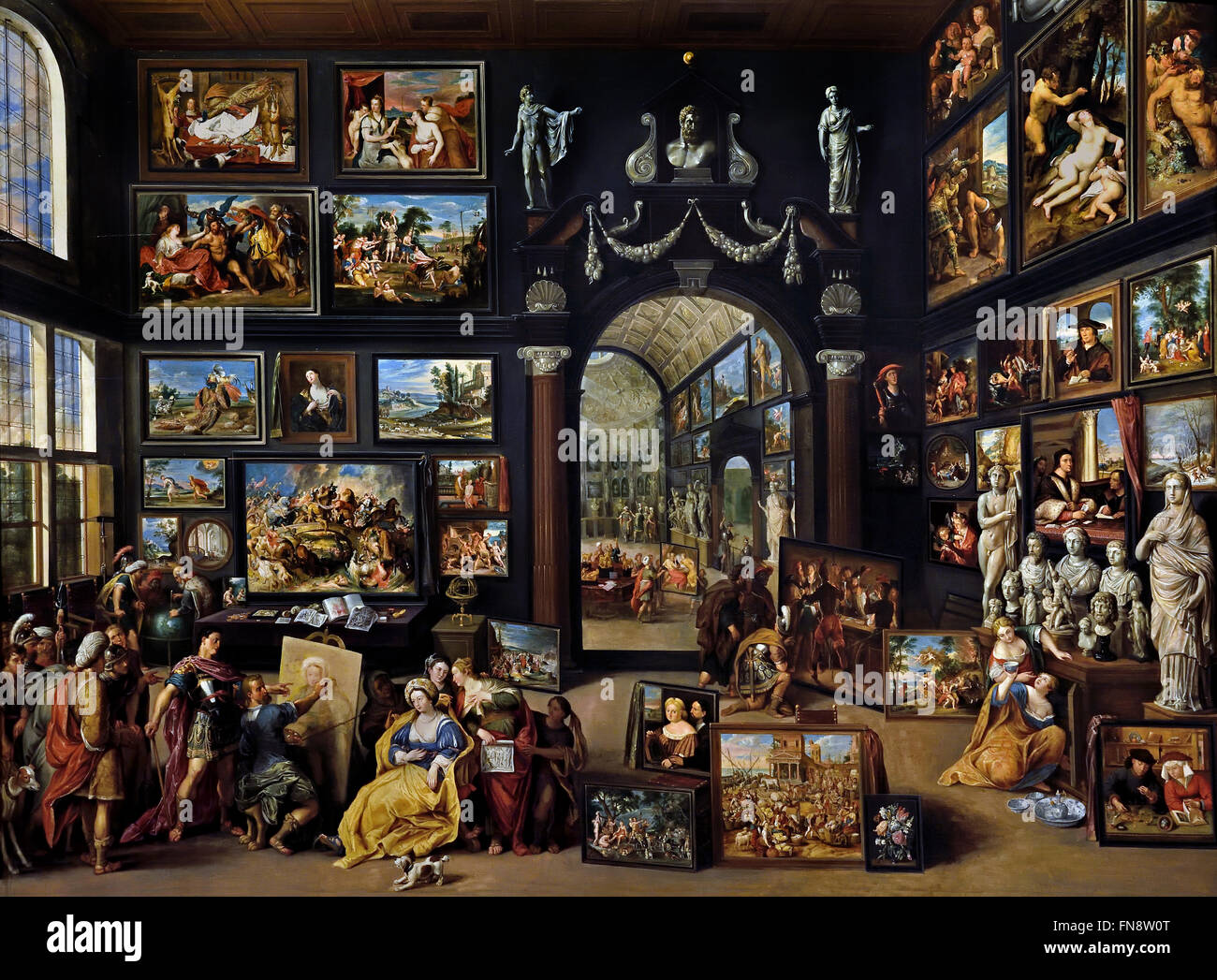 Apelles Painting Campaspe 1630 by Willem van Haecht 1593-1637 Dutch Netherlands Alexander the Great visits the studio of Apelles ( Alexander I was Emperor of Russia from 1801, the first King of Congress Poland from 1815, and the Grand Duke of Finland from 1809 to his death. ) Stock Photohttps://www.alamy.com/image-license-details/?v=1https://www.alamy.com/stock-photo-apelles-painting-campaspe-1630-by-willem-van-haecht-1593-1637-dutch-99154856.html
Apelles Painting Campaspe 1630 by Willem van Haecht 1593-1637 Dutch Netherlands Alexander the Great visits the studio of Apelles ( Alexander I was Emperor of Russia from 1801, the first King of Congress Poland from 1815, and the Grand Duke of Finland from 1809 to his death. ) Stock Photohttps://www.alamy.com/image-license-details/?v=1https://www.alamy.com/stock-photo-apelles-painting-campaspe-1630-by-willem-van-haecht-1593-1637-dutch-99154856.htmlRMFN8W0T–Apelles Painting Campaspe 1630 by Willem van Haecht 1593-1637 Dutch Netherlands Alexander the Great visits the studio of Apelles ( Alexander I was Emperor of Russia from 1801, the first King of Congress Poland from 1815, and the Grand Duke of Finland from 1809 to his death. )
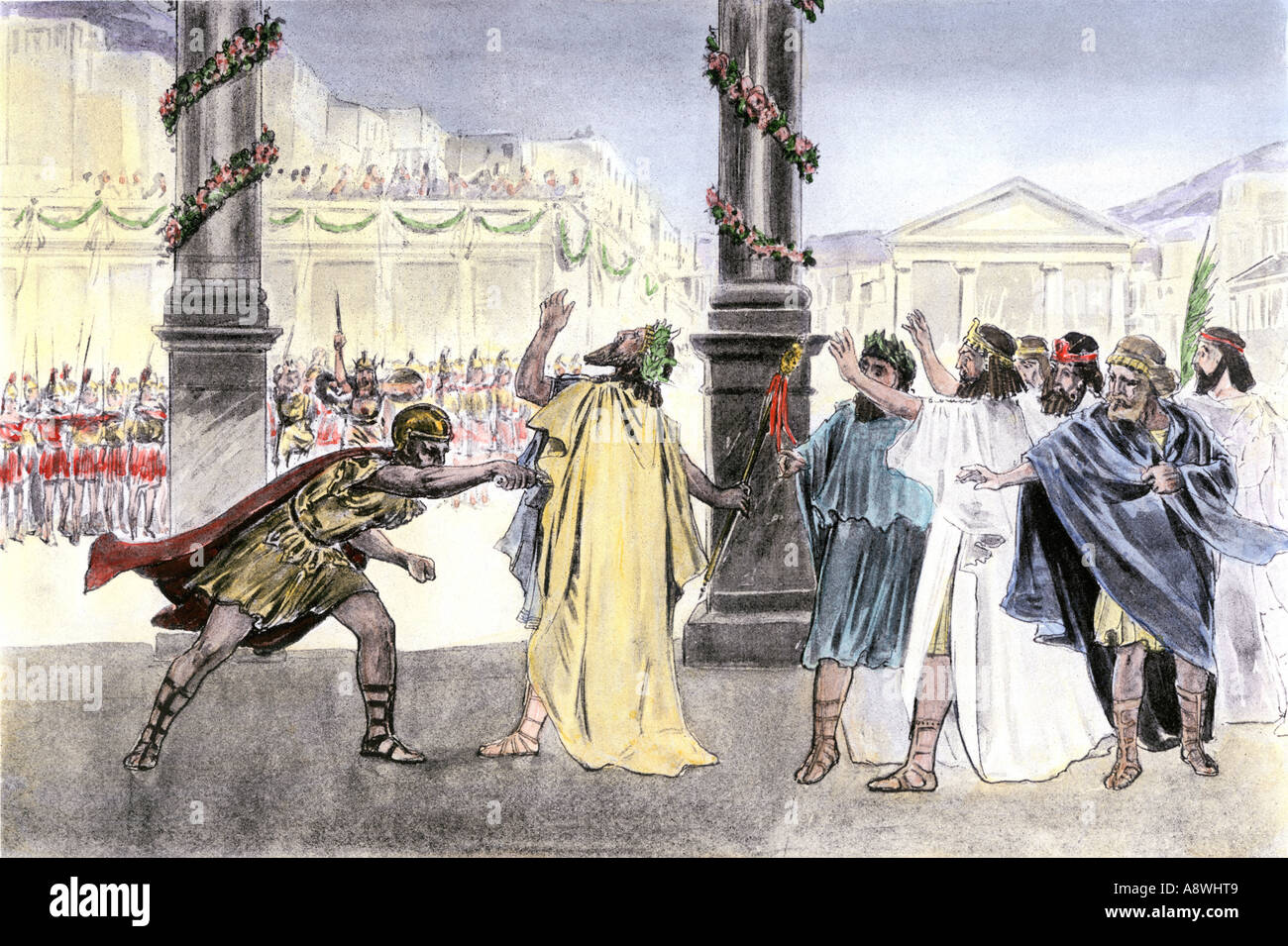 Assassination of Philip II of Macedon causing his son Alexander to become king. Hand-colored halftone of an illustration Stock Photohttps://www.alamy.com/image-license-details/?v=1https://www.alamy.com/assassination-of-philip-ii-of-macedon-causing-his-son-alexander-to-image6961736.html
Assassination of Philip II of Macedon causing his son Alexander to become king. Hand-colored halftone of an illustration Stock Photohttps://www.alamy.com/image-license-details/?v=1https://www.alamy.com/assassination-of-philip-ii-of-macedon-causing-his-son-alexander-to-image6961736.htmlRMA8WHT9–Assassination of Philip II of Macedon causing his son Alexander to become king. Hand-colored halftone of an illustration
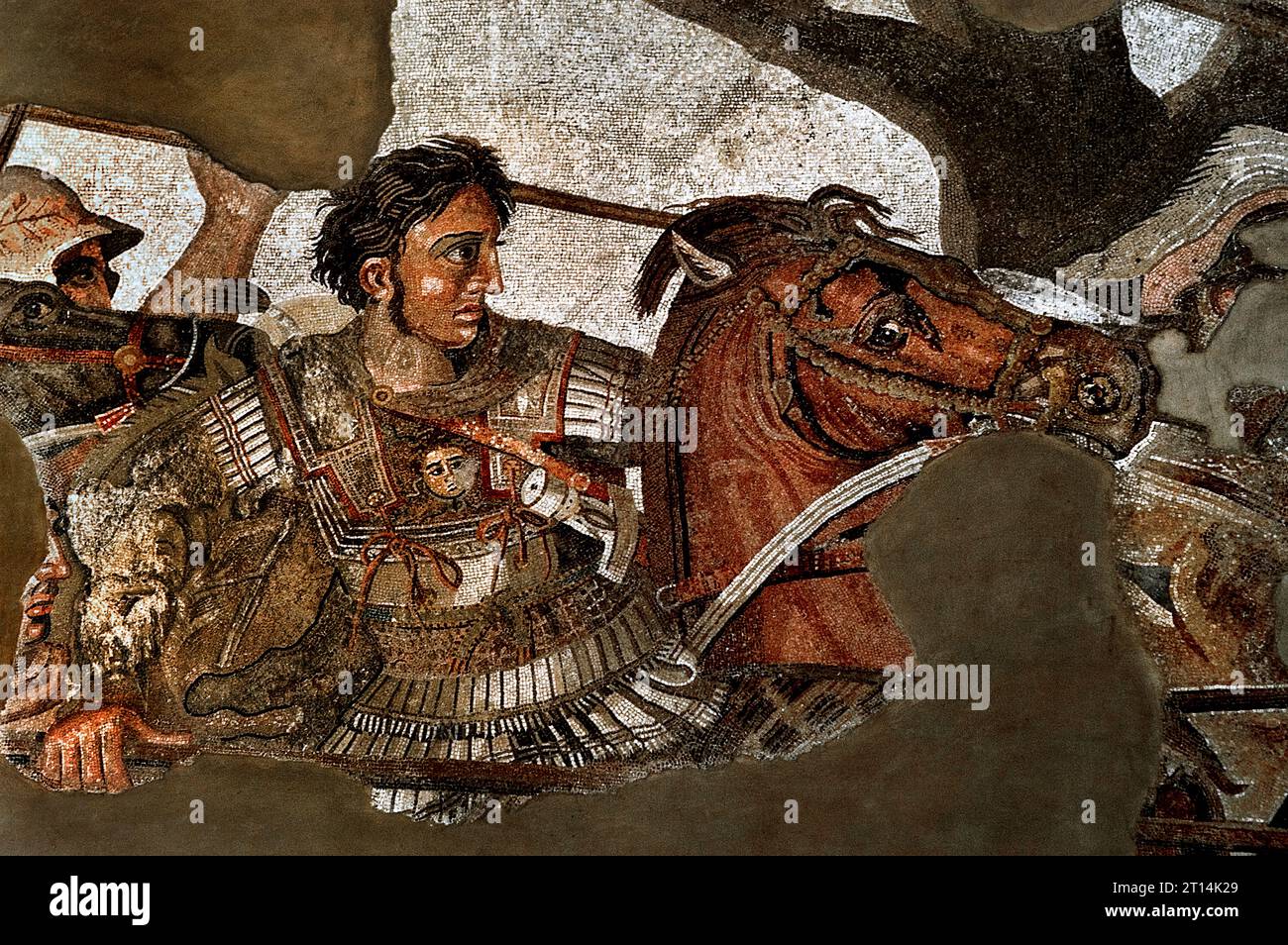 Alexander the Great in battle with Persian King Darius III ,Alexander the Great Issus 331 B.C. Mosaic from Pompeii ( Alexander the Great, Alexander III of Macedon, 356 BC – 323 BC king of the Ancient Greek kingdom of Macedon from 336 BC until his death in 323 BC. He was one of the greatest military leaders of all time. ) Stock Photohttps://www.alamy.com/image-license-details/?v=1https://www.alamy.com/alexander-the-great-in-battle-with-persian-king-darius-iii-alexander-the-great-issus-331-bc-mosaic-from-pompeii-alexander-the-great-alexander-iii-of-macedon-356-bc-323-bc-king-of-the-ancient-greek-kingdom-of-macedon-from-336-bc-until-his-death-in-323-bc-he-was-one-of-the-greatest-military-leaders-of-all-time-image568659569.html
Alexander the Great in battle with Persian King Darius III ,Alexander the Great Issus 331 B.C. Mosaic from Pompeii ( Alexander the Great, Alexander III of Macedon, 356 BC – 323 BC king of the Ancient Greek kingdom of Macedon from 336 BC until his death in 323 BC. He was one of the greatest military leaders of all time. ) Stock Photohttps://www.alamy.com/image-license-details/?v=1https://www.alamy.com/alexander-the-great-in-battle-with-persian-king-darius-iii-alexander-the-great-issus-331-bc-mosaic-from-pompeii-alexander-the-great-alexander-iii-of-macedon-356-bc-323-bc-king-of-the-ancient-greek-kingdom-of-macedon-from-336-bc-until-his-death-in-323-bc-he-was-one-of-the-greatest-military-leaders-of-all-time-image568659569.htmlRM2T14K29–Alexander the Great in battle with Persian King Darius III ,Alexander the Great Issus 331 B.C. Mosaic from Pompeii ( Alexander the Great, Alexander III of Macedon, 356 BC – 323 BC king of the Ancient Greek kingdom of Macedon from 336 BC until his death in 323 BC. He was one of the greatest military leaders of all time. )
 Image from page 451 of 'Comic History of Greece from the earliest times to the death of Alexander the Great ... Illustrated, etc' . Stock Photohttps://www.alamy.com/image-license-details/?v=1https://www.alamy.com/image-from-page-451-of-comic-history-of-greece-from-the-earliest-times-to-the-death-of-alexander-the-great-illustrated-etc-image217782651.html
Image from page 451 of 'Comic History of Greece from the earliest times to the death of Alexander the Great ... Illustrated, etc' . Stock Photohttps://www.alamy.com/image-license-details/?v=1https://www.alamy.com/image-from-page-451-of-comic-history-of-greece-from-the-earliest-times-to-the-death-of-alexander-the-great-illustrated-etc-image217782651.htmlRMPJ8RYR–Image from page 451 of 'Comic History of Greece from the earliest times to the death of Alexander the Great ... Illustrated, etc' .